Best catacombs to visit in Rome
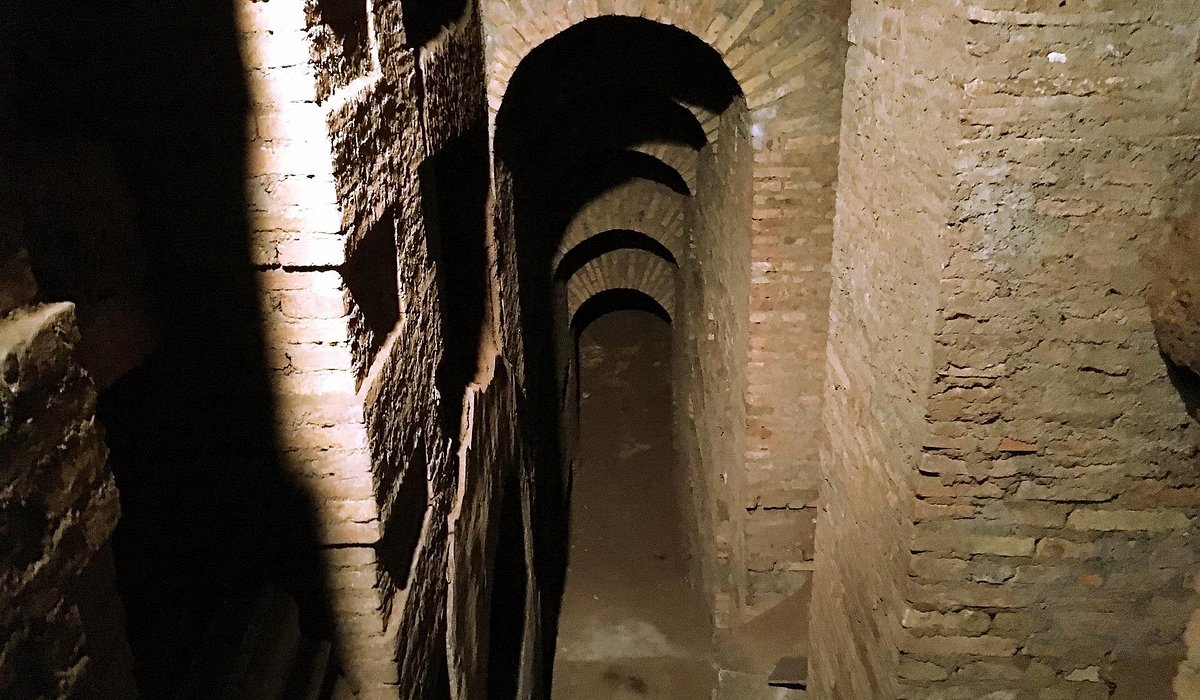
Sure, we all know that visiting Rome means you’ll likely hit the must-see attractions like the Colosseum , Pantheon , and Trevi Fountain . But if you’re looking for a truly unusual experience in Rome, why not check out the Roman catacombs?
Dating back to the first century, these man-made subterranean passageways were used as underground tombs in Ancient Rome. Unlike the Roman pagans who cremated their dead, the Jewish and Christian populations believed in religious burials. However, under the rule of the Roman Empire, bodies were not allowed to be buried within the city walls due to hygiene concerns.
Hence, Jewish and Christian catacombs were constructed to allow the dead to be secretly buried underground. Fearing persecution, many Christians also began praying belowground, and the catacombs became sacred sites of worship. When Christianity eventually became legalized, catacombs gradually fell out of popularity and were only rediscovered in the 1600s.
Today, there are about 40 Christian and six Jewish catacombs scattered around Rome, although not all of them are open to the public. Most of them require entry tickets, and wheelchair access is fairly limited. Women are advised to cover their shoulders, and pictures are also forbidden out of respect, so leave these sacred sites only in your memories.
Whether you’re a history buff or a traveler with a taste for the macabre, get ready to explore the secrets contained within the best catacombs in Rome .

1. Catacombs of Saint Callixtus

Located along the historic Appian Way , the catacombs of Saint Callixtus are the largest and most well-known of the Roman catacombs. These catacombs were featured in Ben-Hur , and were named after Pope Callixtus I, who served as a deacon and administrator of the catacombs.
Once the official underground cemetery of the Church of Rome, the catacombs of Saint Callixtus were the final resting place of close to half a million Christians. These catacombs stretch over more than 12 miles and five levels and are divided into multiple sections, including the Crypt of the Popes, the Crypt of Saint Cecilia, and the Crypt of the Sacraments.
If you get squeamish easily, there’s no need to worry about encountering any human remains here—all bodies within the tour route have since been respectfully relocated.
It’s easy to get lost and confused in this maze-like complex, so we recommend joining a guided tour to learn more about the famous popes and martyrs laid here to rest. As the catacombs are a distance away from the city center, you can also consider joining this tour that includes transportation from Piazza Venezia .
2. Catacombs of Saint Domitilla

The catacombs of Saint Domitilla still hold human remains, but that’s not what they’re known for. Instead, most people flock to the catacombs of Domitilla to admire the intricate frescoes depicting biblical figures and Ancient Roman history. These thousand-year-old frescoes are still undergoing restoration, but you can spot iconic images like Jesus with the apostles.
This is also where you’ll find the fourth-century Basilica of Nereus and Achilleus. The catacombs of Saint Domitilla’s underground basilica are 1 out of only 2 Roman churches dedicated to the two saints, who were martyred for refusing to carry out military orders to kill Christians.
Don’t be intimidated by the size of these catacombs—large portions haven’t been completely excavated, so you won’t need to dedicate too much time here. In fact, this small-group express tour promises to take you to the catacombs and back to downtown Rome in less than two hours. Or if you’d like to check out other historic sights nearby like the Basilica of San Martino ai Monti , this multi-stop walking tour will take you along the treasures of the Appian Way.
While photographs aren’t allowed, the catacombs of Saint Domitilla have a gift shop, so you can pick up souvenirs to commemorate the experience.
3. Catacombs of San Sebastiano

The catacombs of San Sebastiano have had numerous identities, including a former pozzolan mine, a pagan cemetery, and finally, a catacomb used by Christians. The underground graveyard was said to have contained the remains of the Apostles Peter and Paul, and also housed the remains of Saint Sebastian, which are now kept in the basilica above the catacombs.
Unfortunately, these small and accessible catacombs are one of the least preserved. Out of the compound’s original four floors, one has been almost completely destroyed. However, you can still find some stunning relics like the paintings of Jonah’s cubicle and Bernini’s bust of Saint Sebastian. As you embark on your tour of the catacombs , look out for ancient graffiti by devotees scrawled along the plastered walls.
4. Catacombs of Priscilla

Also known as the Queen of the Catacombs, the catacombs of Priscilla are one of the oldest underground graveyards in Rome , used for Christian burials. Pope Marcellinus and Pope Marcellus I were buried here, and the remains of Saint Philomena have also been found within these catacombs.
Explore the tunnels after dark with this evening tour , where you’ll get to appreciate some of the oldest known biblical paintings without the crowds. Most notably, the catacombs of Priscilla contain what’s believed to be the first rendering of Mary, created in the third century. You can also find elaborate frescoes covering the Greek Chapel, which depict scenes from the Old and New Testament.
5. Vatican Necropolis

While the Vatican Necropolis lies outside Rome , it’s still worth a visit, especially if you’re already in Vatican City . Located below St. Peter’s Basilica , the necropolis was once an open air cemetery for early Christians, including Saint Peter himself.
Eventually, Emperor Constantine built a basilica over Saint Peter’s grave, and the necropolis remained undiscovered until the 20th century. During the pontificate of Pope Pius XII, excavation work began in an attempt to locate the grave of Saint Peter. Various mausoleums were gradually discovered, and eventually “Field P” where the Apostle had been buried.
To protect and conserve the sanctity of the necropolis, only a limited number of visitors are allowed at a time, especially as archaeological excavations are still ongoing. You’ll need to join the official Scavi Tour to visit the ancient cemetery and pay your respects to Saint Peter. Bonus: The tour will also allow you to skip the line at St. Peter’s Basilica.
6. Crypt of Capuchins

Perhaps one of the most famously macabre sights in Rome , the Capuchin Crypt technically isn’t a catacomb, but an ossuary. Still, most catacomb tours like this small-group tour include a trip to the legendary “Bone Chapel.”
Venture underground beneath the church of Santa Maria della Concezione dei Cappuccini to explore these six chapels adorned with the skeletal remains of 3,700 Capuchin friars, who were buried here from the 1500s to the 1800s. Various crypts are dedicated to selected body parts like skulls, pelvises, and leg bones.
While the crypt is probably unsuitable for young children or the faint of heart, if you’re able to get over your squeamishness, we highly recommend paying this iconic site a visit. After all, it exists not for morbid reasons, but as a poetic reminder of the constant cycle of life and death: “What you are now we used to be; what we are now you will be…”
If you need a pick-me-up after your tour, we suggest heading to the nearby Trecaffè Due Macelli for a cappuccino—the espresso-based drink was named after the hooded robes worn by the Capuchin monks.
Recommended tours and activities

Rome catacombs: how to visit + what you need to know
All you need to know about Rome catacombs: what they are, where they are, the best catacombs in Rome to visit and how to book a tour.
The catacombs are one of the most fascinating underground attractions in Rome .
Rome’s catacombs are early Christian cemeteries , dating from the early days of Christianity in the Roman Empire.
They develop as an extensive network of underground tunnels and they are one of the most fascinating ancient Christian sites in the city.
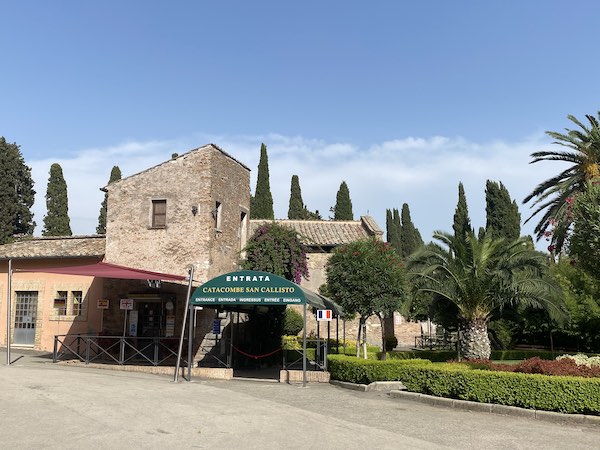
There are several catacombs in Rome, all wonderful for different reasons.
In this guide, I share fun and intersting facts about the Rome catacombs and tips to plan your visit.
Since photography is not allowed inside the catacombs, I added images of the outside and the free info panels at San Callisto, showing drawings of the catacombs.
Safe travel planning!
Please note: this post contains affiliate links and, should you make a purchase through them, we might make a small commission.
Table of Contents
What are the catacombs of Rome? Essential catacombs facts at a glance
- Rome catacombs are underground, early Christian cemeteries
- The Catacombs of Rome date from the II century AD and stayed in use until the V century
- They are excavated in tufa, a volcanic rock typical of central Italy
- The catacombs spread over several kilometres. The catacombs of St Callixtus alone are over 20km long!
- The catacombs develop over several floors and get to a depth of over 20mt underground
- The catacombs of Rome hosted the remains of many saints, martyrs and Popes
- The catacombs were abandoned in the Middle Ages
- The were rediscovered during the Renaissance(XVI century) and partially restored and made accessible in the XIX century
- There are many catacomb complexes in Rome, only some of which are open to the public
- Visits to the catacombs are by guided tours only
How to visit Rome’s catacombs
There are five catacombs in Rome currently open to visitors and managed by organisations offering guided tours.
Due to the nature of the site, access to the catacombs is by guided tour only: booking is essential.
Need to know : access to the catacombs is by steep steps that are not suitable to people with mobility impairments. Due to the underground nature of this site, the catacombs are always cold: bring a shawl even in the hight of summer! See more tips about what to wear for your visit at the end of this page.
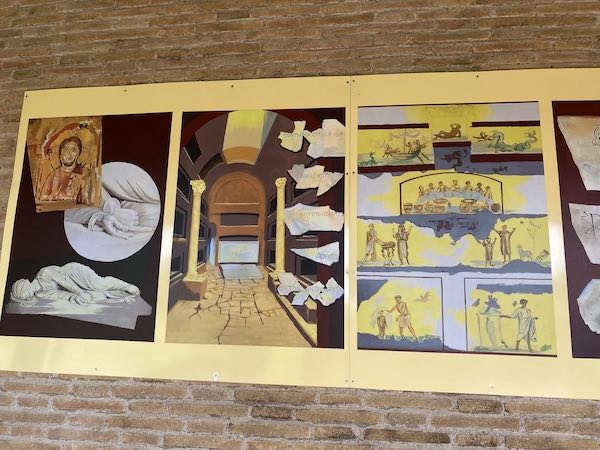
The Catacombs of St Callixtus – recommended for a first visit
The Catacombs of St Callixtus (Catacombe di San Callisto) are the largest in Rome and the most visited.
The are along Via Appia, in an area with several other significant attractions such as the Quo Vadis Church and ancient Roman Tombs.
They are managed by the Vatican, via the Religious Congregation of the Salesians Don Bosco.
Guided tours are available in several languages; you can book online here .
The tour is excellent and aI found it to be the most informative I have take so far.
This is why I recommend this a a tour of choice for a first catacomb visit. the tour is child friendly (school age and up for accessibility and type of attraction – see below)
The Catacombs of Saint Callixtus date from the II century AD and are one of the most important Christian sites in Rome.
They are there esting place of over half a million Christians and count, among their original residents, St Cecilia and many Popes, resting in a chamber aptly called ‘Little Vatican’.
The most noticeable things in the catacombs of St Callixtus are the tunnels themselves, a stunning statue of St Cecilia, now marking her original burial niche, the ancient frescoes in some of the wealthiest chapels and the impressive Little Vatican, a powerful place for Christians especially.
The visit to the Catacombs of St Callixtus lasts about 45 minutes and includes a talk explaining what the catacombs are and how they came to be and a walk though the tunnels.

Catacombs of San Sebastiano
The catacombs of ST Sebastian are also located on Via Appia, only a short distance from those of St Callixtus.
These are among the most ancient catacombs in Rome and are wonderful especially for the beautiful frescoes that still decorate the chamber known as the cubicle of Jonah , dating from the IV century AD.
The catacombs of St Sebastian started as a pagan burial area and became Christian cemeteries in the II century, when they were dedicated to St Peter and St Paul.
They owe their name to St Sebastian, who died martyr in Rome and whose remained where moved here by matron Lucina, who saw the Saint in a dream and felt called to give him proper burial in this location.
You can visit the Catacombs of St Sebastiano with the aid of a guide. You can book your tour here .
Catacombe di Priscilla
The catacombs of Priscilla are located in the north of Rome, close to via Salaria, and are unique as they are where you find the first ever depiction of the Virgin.
The fresco represents Mary with the Christ Child on her lap and dates from the IV century AD.
Access to these catacombs is by guided tour, you can book your ticket here .
These are among the best and most interesting catacombs in Rome.
I recommend a visit especially to visitors with religious interests, Christian art lovers and to families with kids, as they are beside the large Villa Ada park.
Catacombs of Domitilla
Domitilla Catacombs are on Via Ardeatina, in the south of Rome. They have tunnels over 17 kilometers long, they develop over four levels and were the burial grounds of over 150,000 Christians.
They are most famous for being the resting place of St Nereus and Achilleus, who were buried here in the IV century AD and they are also home to a unique site: a partially underground basilica, dating from the Pontificate of Pope Damasus 366-384 A.D.
Access is by private tour only: you can book your ticket contacting the catacombs office directly here .
Catacombe di Santa Agnese
The catacombs of St Agnes are under the stunning Christian complex of St Agnes’ Basilica and Costanza’s mausoleum, in the north of Rome.
The catacombs develop under the church and take their name from St Agnes, who is celebrated here and in the church of Sant’Agnese in Agone in P iazza Navona , where you canals see her relic.
These catacombs are lesser visited than others in Rome; however, they are interesting, especially if you combine your visit to the church of Sant’ Agnese and the unique Christ of Santa Costanza beside it, which is a rare example of round church in Rome.
You can arrange a tour of the catacombs contacting the parish office here
Visiting Rome catacombs with kids
The catacombs are an interesting site for kids; however, due to the nature of the attraction and the the logistics of its accessibility, they may pose challenges to families with small kids.
Based on my experience visiting the Rome catacombs with kids, I believe it is important to know the following things.
The catacombs are not stroller friendly : access is by steep steps and due to the humidity in the tunnels, they can be slippery.
If you plan to visit the catacombs with a baby , a baby carrier and proper shoes are essential.
Also, always hols handrails when climbing down as it is very easy to slip!
I do not recommend visiting the catacombs with a toddler : while it is technically possible, it is of paramount importance that they do not trot ahead or ever leave your side.
Getting lost here is very easy and there are over 20km of tunnels: while safety precautions are in place, it is not a chance you want to take!
They also have no interest for small kids since there is nothing they can touch or engage with except the echo – which is fun for them to experiment with but not ideal for you or anyone else present..
Kids of primary school age and up are likely to love the catacombs: the underground tunnels and the history of the place is likely to pique their attention and curiosity.
However, I recommend you take into account that these are cemeteries and that you will hear stories of gruesome deaths and see the graves of babies and children.
This may or may not be an issue for your children, however, I believe it is essential to be prepared.
A grave of a young child, even if very ancient, is the one thing my daughter remember the most about the whole experience. Preparation is key.
I believe the catacombs are a fantastic site to visit in Rome with teenagers .
Those I recommend with them are those at St Callisto , which you can combine with a bike trip along Via Appia.
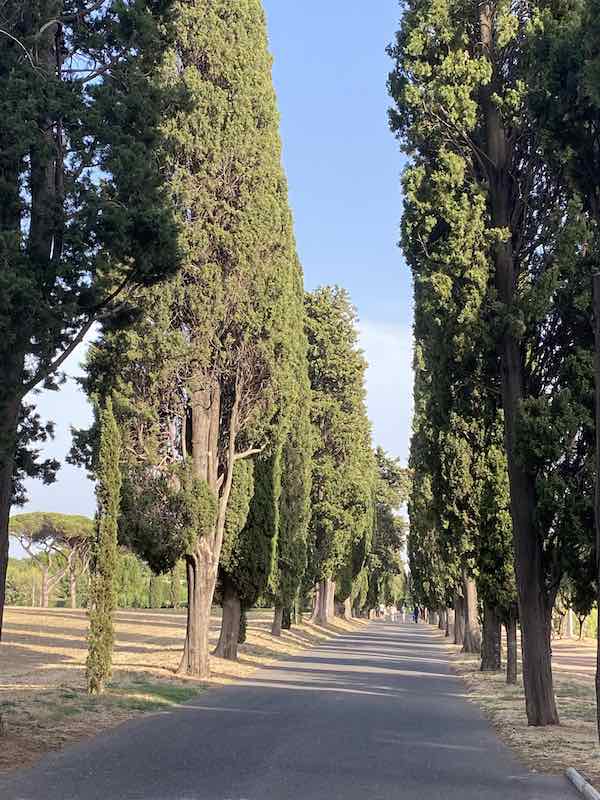
More interesting facts about the Catacombs of Rome
The catacombs of Rome are early Christian underground cemeteries.
According to the Vatican, Christian catacombs started under Pope Zephirinus (199-217).
To answer the growing need for a safe burial ground for Christians, he assigned to soon-to-be-Pope Callixtus the task of managing the burial grounds on Via Appia and turn it into a Christian cemetery, able to host the remains of Popes and fellow Christians alike.
The cemetery grew over time and became a vast underground city for the dead.
The same concept replicated in several areas of Rome so now we can visit several catacombs, in different parts of the city.
What are Rome catacombs made of?
The catacombs are excavated in a type of stone that is typical of central Italy and called tufa.
This material is very malleable when underground but become very strong and resistant once exposed to air.
This characteristic means that diggers ( fossores , in Latin) were able to efficiently excavate long tunnels and burial slots that were then solid and able to stand the test of time once completed.
The excavation would have started with one layer of underground niches, like a modern cemetery; as the need for space grew, diggers would go deeper, adding more and more corridors.
The biggest catacombs in Rome are over 4 storey deep, each storey hosting several rows of burial slots on each side of its walls and numerous chambers.
What do the catacombs look like?
Pleas note: Photography is not allowed inside the catacombs.
The catacombs are a network of long underhand tunnels.
You enter them by rather steep staircases leading you several stories underground and they spread like tall, meandering corridors.
Along their walls, there are slots excavated to accommodate a lying body. Each wall has several niches, one on top of the other, to allow the use of all the space possible.
Each slot would have been covered with a burial stone and had space for a small oil burning lamp, for light and hygene.
As you walk along the corridors, you also encounter chapels and bigger chambers.
These were mausoleums belonging to the wealthiest families or, in the case of the catacombs of St Callixtus, the burial chapel for Popes.
Overall, you experience the catacombs like an underground city, with streets (corridors), crossroads (the network is vast) and a mix of more modest homes and beautifully decorated ones.
What does ‘catacombs’ mean?
The word catacombs comes from the elating ad catacumbas , which in turn seems to come from the Greek expression kata koumbas = at/among the grottos.
How dark are the catacombs? Can I visit if I suffer from claustrophobia?
Since they are underground, there is not natural light in the catacombs.
The areas accessible to the public are now lit up by electric lighting but, back in the day, the small burial lamps and torches would have been the only light sources.
Currently, the catacombs are not ideal if you suffer from claustrophobia but they are well lit and ventilated, so the overall feeling is not too oppressive.
What to wear to visit Rome catacombs
There are two main items you need to visit the catacombs in Rome:
A shawl or a cardigan and good walking shoes.
The shawl/cardigan is essential in all seasons: the catacombs are cold and stay at a temperature of about 16C/61F degrees.
This is regardless of the temperature outside: the last time we visited, we have 35C/95F degrees out and 16C/61F in – make sure you have an extra layer you can easily out on/ take off!
In terms of shoes, I recommend you opt for comfortable shoes with rubber sole: this is to help you with the long walking required and also to give you extra grip on the steps. Avoid flip flops at all costs.
You can find here >>> my tips on the best shoes for Rome .
I hope you found this quick guide to the Rome catacombs useful and it helped you plan your visit. Safe travels to Rome!
My name is Marta, I am a travel-loving mama born and bred in that messy, wonderful, infuriating, awe-inspiring unbelievably beautiful city that is Rome. A classics graduate and professional travel blogger, on this site I share my insider tips to help you plan your dream trip to Rome, Italy.
Underground Rome: the best subterranean ruins in Rome + how to visit
How many days in rome how to decide + recommended rome itineraries, you may also like, fun and interesting facts about the colosseum for..., christmas markets in rome you will love this..., how to see the best of rome in..., free things to do in rome you’ll love..., how to buy tickets for the pantheon +..., how to visit the spanish steps in rome:..., largo di torre argentina: all you need to..., 40+ rome hidden gems you’ll love, outdoor swimming pools in rome you’ll love this..., 22 fantastic things to do in rome when..., privacy overview.
- Most Popular
- Special Tours
- Small Groups
- Florence tours
- Venice Tours
- Pompeii and Amalfi Tours
- Rome culinary experiences
- Cinque Terre
- Alba and Langhe
- Amalfi Coast, Capri and Pompeii
- Puglia and Matera
- Sicily and Pantelleria
- Rome Kids & Families Experiences
- Rome Kids & Families Tours
- Vatican Kids and Families Tours
- Venice Kids & Families Experiences
- Venice Kids and Families Tours
- Cooking Classes for Kids in Rome
- Sustainability
- Via Giustiniani, 23, 00186 Roma RM
(0039) 06 6624626
(0039) 338 7791615
(0039) 334 7243374
- [email protected]

- Rome Kids & Families Tours
The 5 Best Catacombs in Rome
Home / Blog / What to do in Rome / The 5 Best Catacombs in Rome

Descending into the Catacombs in Rome is not an experience for the faint-hearted. Dimly lit passageways and mostly open tombs (often with no remains) welcome visitors who dare, rewarding them with a richly important insight into the burial sites of the Eternal City’s past inhabitants; Christian, Jewish, and even Etruscan.
Whilst there are thought to be over 40 catacombs cascading underneath modern-day Rome, only a handful are open to the public today. What’s more, once inside the seemingly neverending winding corridors, one will understand why a guide is necessary for all catacomb tours.
These underground spectacles can become so confusing that Antonio Bosio, the archaeologist who rediscovered the catacombs, got LOST inside, wandering the cold, dark, and muddy passages for hours… something best not to be repeated!
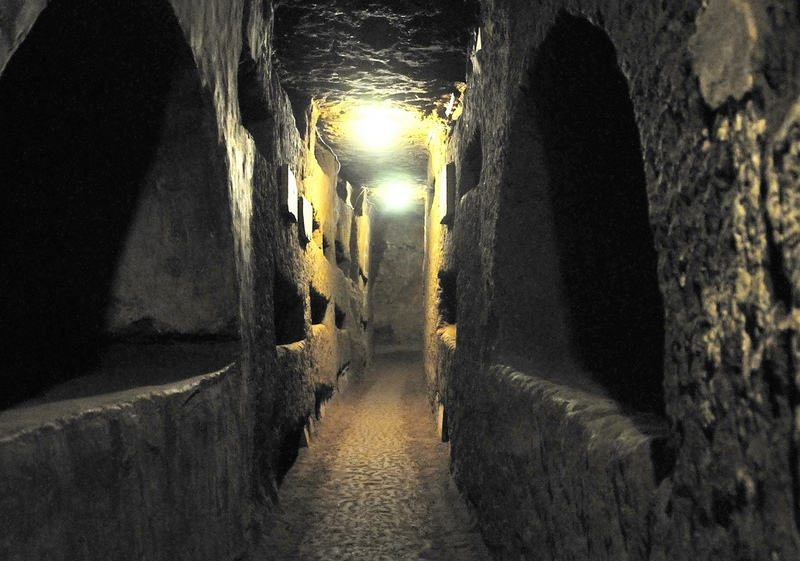
Passageways of the catacombs on the Old Appian Way
Catacombs of San Callisto
Situated on the Old Appian Way , the Catacombs of San Callisto span five levels and a total 20 kilometers in length. Named after the (soon-to-be pope) St. Callixtus, these are among the most significant Christian catacombs in Rome, and acted as the official cemetery of the Church of Rome in the 3rd century AD.
It is believed that roughly half a million Christians were buried in these catacombs, which were built in roughly 150 AD. Of these, there were some 16 pontiffs and 50 martyrs. Today, the Catacombs of San Callisto are open from Thursday to Tuesday between 9 am-12 am and 2 pm-5 pm.
→ Click to a look at our Private Catacombs and the Appian Way Tour !
Catacombs of San Sebastiano
If you are journeying Via Appia Antica, the Catacombs of San Sebastiano will show themselves as an easily accessible option, much like San Callisto. In fact, this hypogeum cemetery has always proved easy to access, resulting in a lack of respective preservation.
However, what is left of this smaller four-story catacomb is truly worth the visit. A restored crypt of St. Sebastian includes a table altar and a bust of the saint attributed to Bernini , as well as pagan mausoleums and Christian iconographies covering the walls of the catacomb.
More graffiti, reading ‘ domus Petri ’ also hints at the possibility that Peter the Apostle was buried within these walls, or more likely gives us the idea that this was of general consensus at the time.
The Catacombs of San Sebastiano are open to visitors from Monday to Saturday between 9 am-12 am and 2 pm-5 pm.
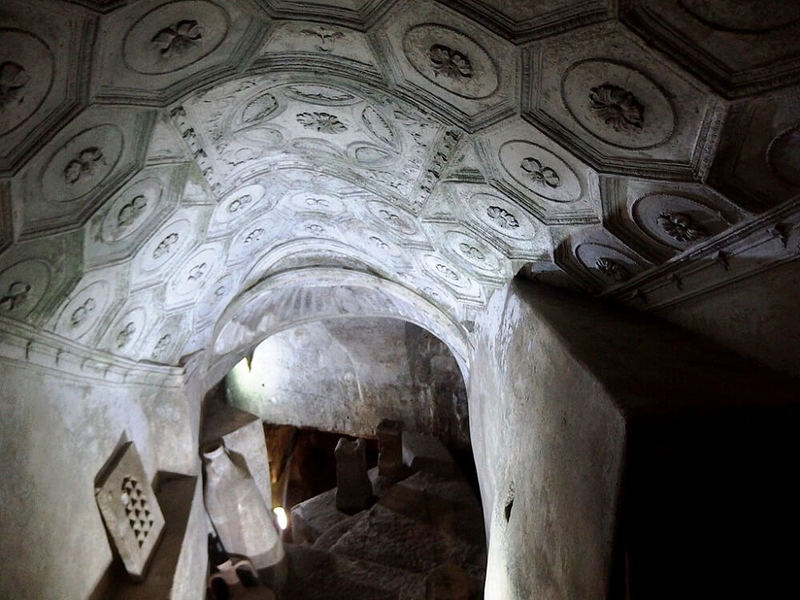
Pagan mausoleum in the Catacombs of San Sebastiano
Bone Church and the Capuchin Crypt
Whilst not technically one Rome’s catacombs, the Bone Church (also known as the Santa Maria della Concezione dei Cappuccini ) offers many visitors greater exposure to the buried themselves that they may feel the more well-trodden path of the catacombs in Rome can provide.
Passing through the church, which is still in operation, one will arrive at the Capuchin Crypt. Here, six rooms contain the skulls and bones of friars who died between 1528 and 1870 – clearly a more recent development than the catacombs of the Old Appian Way.
Taking an Underground Rome Tour with Walks Inside Rome, you can discover the stories behind these 3,700 Capuchin monks that decorated the crypts, and why they were decorated in this way over hundreds of years.
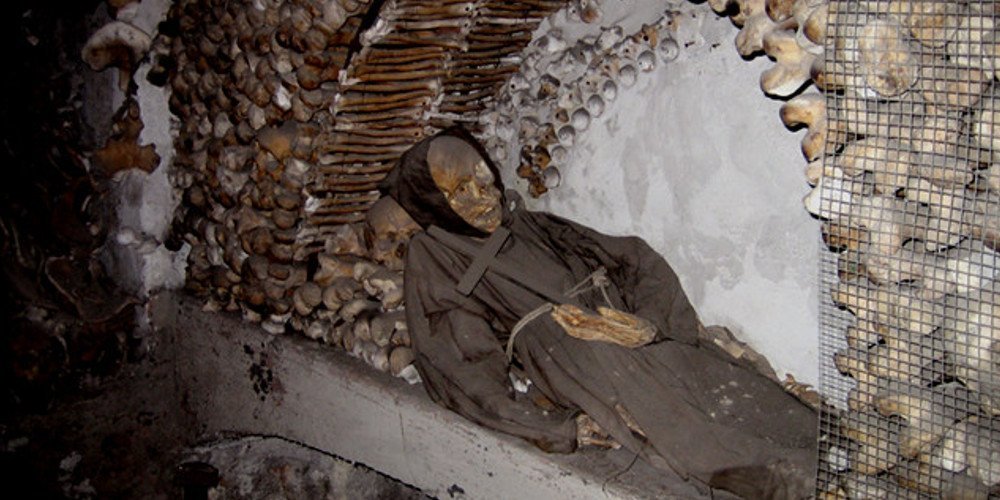
A Capuchin monk’s remains in the Bone Church
Catacombs of Domitilla
Also situated on Via Appia Antica, the Catacombs of Domitilla were discovered in 1593 by Bosio, the archaeologist who slightly lost his way upon discovery. A Christian cemetery, the passageways were mostly used throughout the fifth century AD, and host over 26,000 tombs.
These catacombs differ from their Old Appian Way counterparts in the fact that they still hold human remains. Moreover, the walls are covered in paintings depicting scenes of the mundane, such as bakers and grape vines, to biblical, pagan, and mythical images.
The Catacombs of Domitilla are open to visitors from Wednesday to Monday between 9 am-12 am and 2 pm -5 pm.
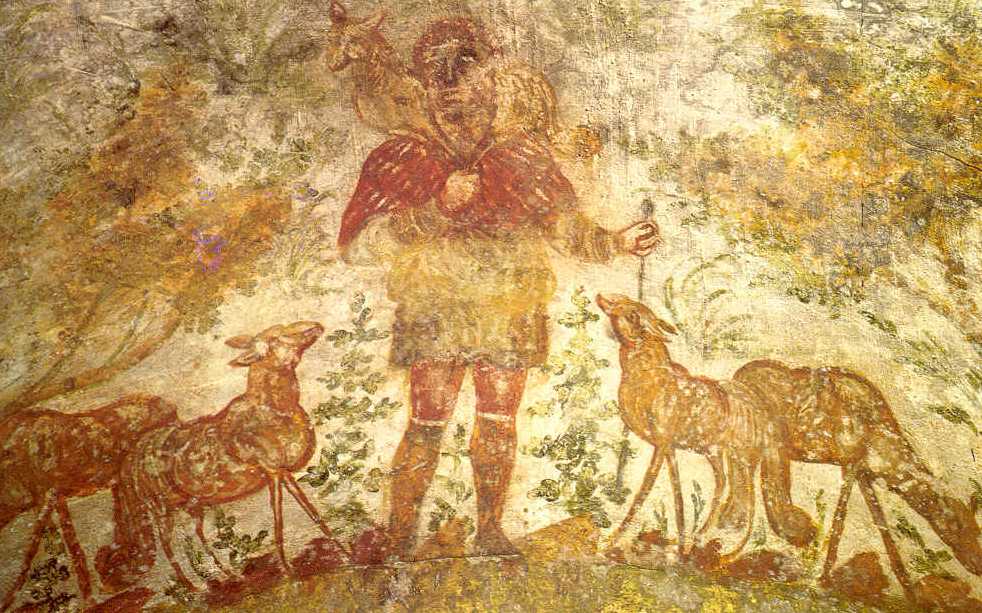
Good Shepherd painting in the Catacombs on Domitilla
The Jewish catacombs of Vigna Randanini
The necropolises that stretch from outside ancient Rome’s walls do not all belong to Christianity. Six Jewish catacombs have been unearthed from Rome’s underbelly, although only Vigna Randanini can be visited today.
With a Jewish Catacombs and Old Appian Way Tour , one can see the wider galleries and the ‘Kokhim’ graves with the wonderfully painted cubicula. Well-preserved, yet more intimate than others, the modest nature of these tombs can be attributed both to the poverty endured by the Jewish community of the time and the Jewish tendency to shun ostentatiousness.
Moreover, we can attribute the fact that the Jewish Romans created their own catacombs to their wish to avoid the Greek and Roman custom of cremation.
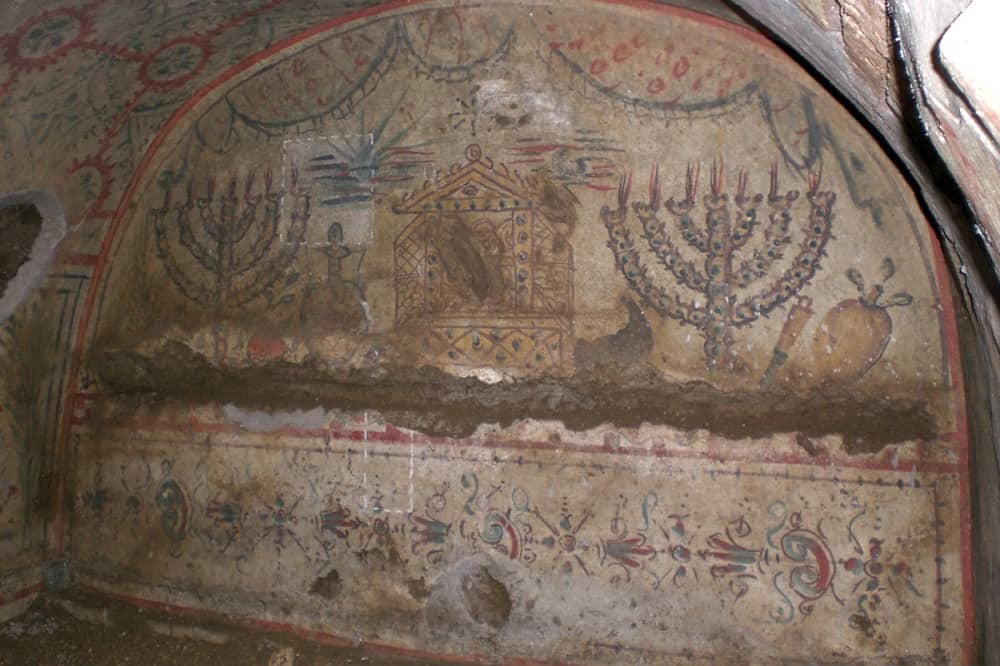
Wall paintings in the Jewish Catacombs
Visit the Catacombs with Walks Inside Rome
Walks Inside Rome has been guiding visitors through the city’s catacombs for over two decades, providing immersive, authentic, and educational experiences for those who wish to delve deep into underground Rome.
Our local, licensed guides who are experts in art, history, archaeology, and food endeavor to transform your catacombs tour into something unforgettable.
See our website, or contact us via email to see our entire catalog of catacombs tours and more. We can’t wait to hear from you so we can customize your catacombs in Rome experience and explore the Eternal City together!
Related Tours
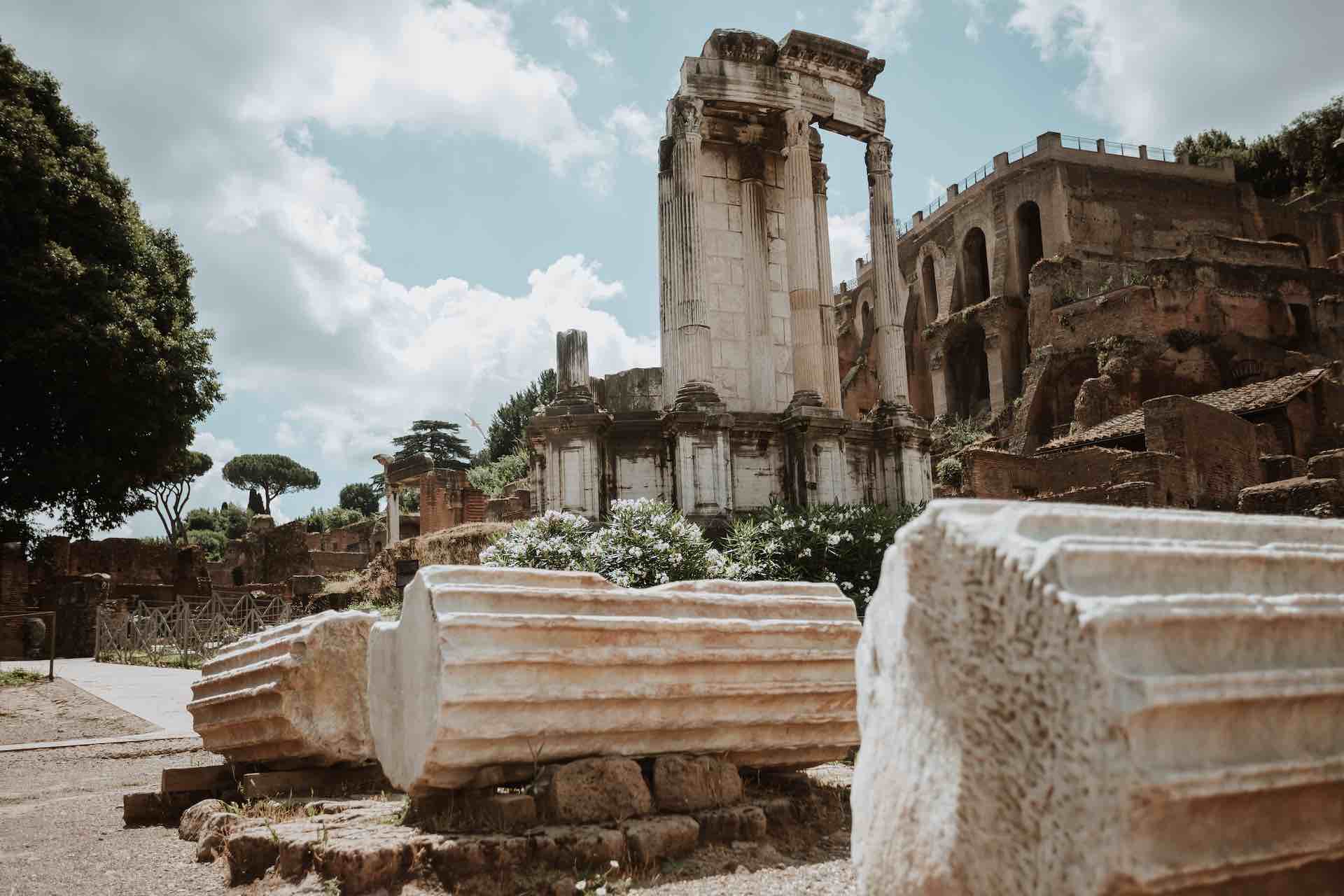
Ancient & Christian Rome Tour | Private
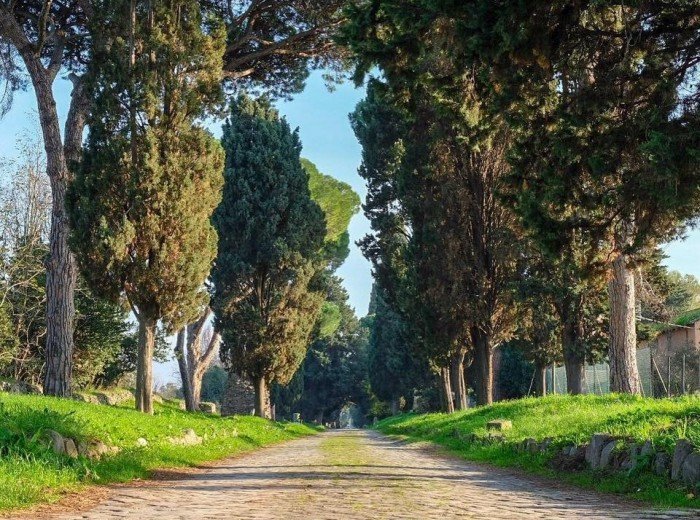
Catacombs & the Appian Way Tour | Private
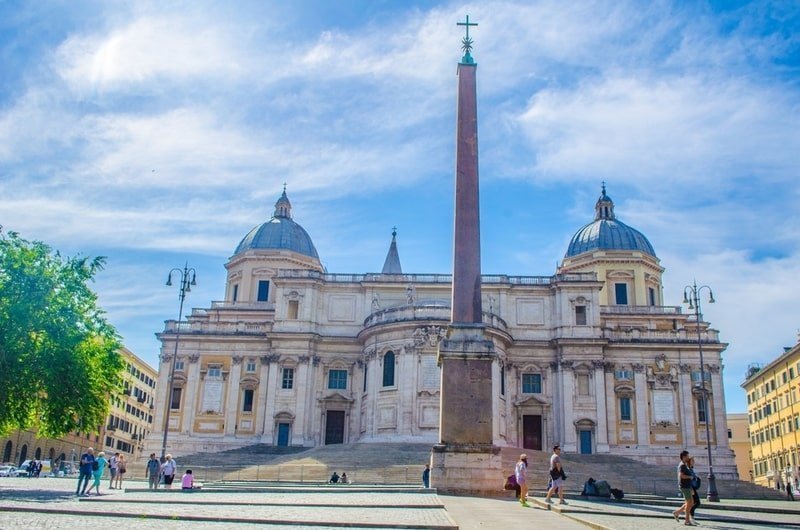
Christian Rome & Basilica Tour | Private
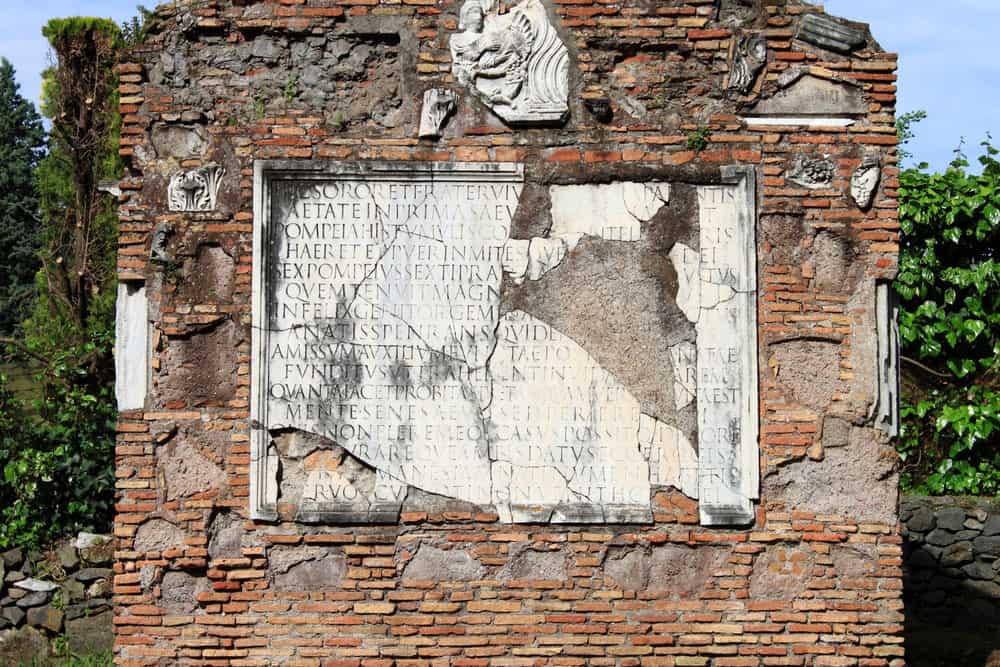
Jewish Catacombs and Old Appian Way | Private
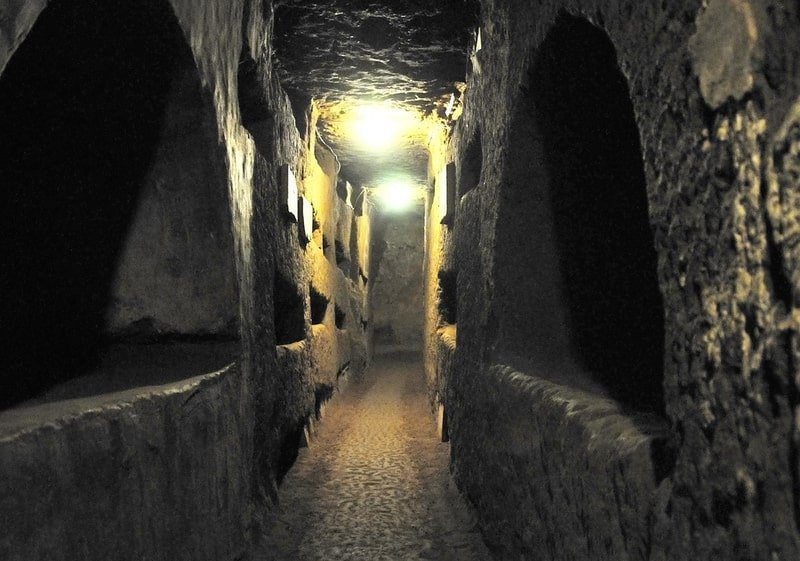
Underground Rome Tour | Private
- Rome Guided Tours
- Cooking Classes in Rome
- Rome for Kids Tours
- Rome Small Group Tours
- Walks Inside Rome
- +39066624626
- +393387791615
- Privacy Policy
- Cookie Policy
Forgot your password?
Lost your password? Please enter your email address. You will receive mail with link to set new password.
Back to login
- Where to Stay
- Where to Eat
- Best Time to Visit Rome
- Top 10 Tips for Rome
- Bathrooms in Rome
- What to Pack & What to Wear
Money Matters
Getting Around
Getting to Rome
- Learn Italian
- Can You Travel to Rome Right Now?
- Italy Green Pass - do you need one?
- Rome Coronavirus News & Updates
- Rome & Vatican Tours
- Italy Tours
- Transfers & Transport
- Sign up & get a FREE ebook Subscribe Today!
- Romewise Home Page
- What to Do in Rome
- catacombs of Rome
Everything you need to know before visiting the Catacombs of Rome

By Elyssa Bernard
February 19, 2023
Thinking of visiting the catacombs of Rome? Wondering if it's worth it?
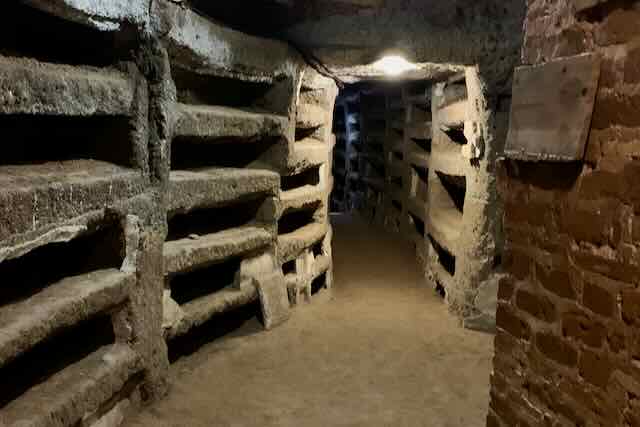
Catacombs of Rome - Everything you need to know
If you love Ancient Roman history, art, and off-the-beaten-path sightseeing, add the catacombs to your Rome itinerary!
On this page, we'll go over:
- A brief history of the catacombs of Rome - what are they, when were they built, and what were they used for?
- What is the Christian history of the Roman catacombs?
- Where are the Rome catacombs?
- How can you visit the different catacombs of Rome?
- What will you see when you visit Rome's catacombs? Are there bones?
- Is it worth seeing the Rome catacombs?
So read on for some fascinating Roman catacombs facts!
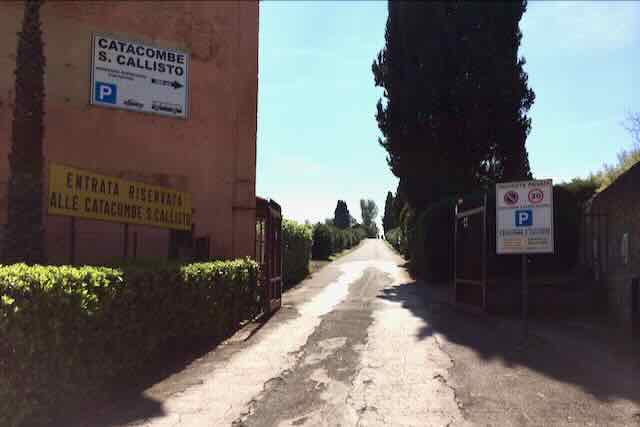
History of the catacombs of Rome
What are the catacombs.
So whats a catacomb? The catacombs of Rome are a network of underground burial chambers located around the city of Rome.
There are probably 50-60 catacombs underground Rome, but only a handful have been excavated and only 6 are open regularly.
The catacombs began being used as burial sites for centuries, starting in the 2nd century CE. They were used by people of varying faiths - Christian, Jewish, and pagan, but fell out of use around the 5th century.
In the 9th century, Rome was often vandalized by Germanic tribes from the north, and many catacombs were plundered for their valuables. As a result, popes began moving Christian martyrs and saints remains and relics to churches in Rome where they can be found today. The popes then blocked the entrances and they were forgotten for over 500 years.
In 1578, Maltese-born archaeologist, Antonio Bosio (1576 – 1629 CE), stumbled upon an entryway to a catacomb along the Via Salaria.
In 1593, he rediscovered the Catacombs of Domitilla, nearly getting lost in the labyrinth as he delved further in.
Nick-named “Columbus of the Catacombs” because he was the first to systematically explore and document the Roman catacombs, Bosio published Roma Sotterranea , which became an essential guide to future archeologists and those studying the catacombs.
When and how were the catacombs of Rome built? Who built them?
From the earliest days of the Roman Republic (6th century BCE), it was forbidden to bury the dead inside city walls.
This was likely to prevent the spread of disease, but also to prevent overcrowding in rapidly growing cities.
This law was later observed across the Roman Empire, which is why you find ancient necropolises, or "cities of the dead", also at Pompeii , Ostia Antica , etc. (Many of these are above-ground.)
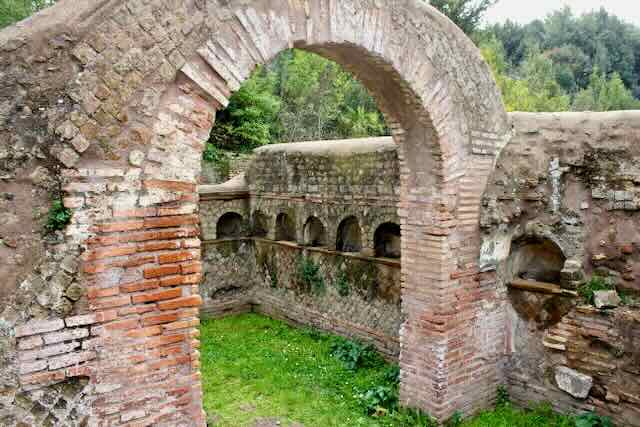
Before Christianity became popular, Ancient Romans cremated their dead and placed them in urns which in turn were placed in honeycomb-like structures called a colombario .
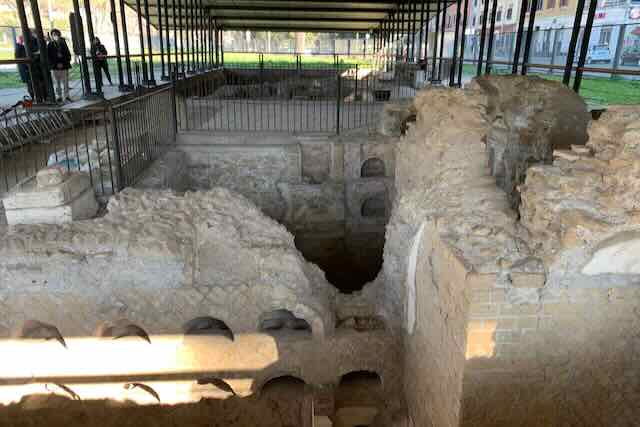
Christians and Jews did not want to be cremated, preferring "inhumation", which kept the body intact.
The earliest underground tunnels near Rome were dug by the Etruscans and primitive Romans, who were looking for minerals and other useful underground substances such as sandstone and limestone. These tunnels were dug out of the soft earth we have around Rome, called "tuff" or tufo in Italian.
As the idea to bury people in inexpensive mass graves outside the city limits began to take hold, these same underground tunnels were repurposed as catacombs. This began in around the 1st century, making them the oldest catacombs ever built.
The wealthy sometimes built impressive tombs for themselves and their families above ground, and you can see some of these if you visit the Appia Antica .
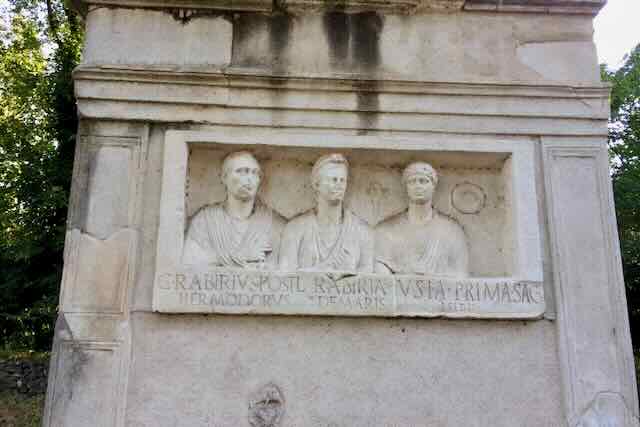
One of the largest and most famous of these is the tomb of Cecilia Metella, a 1st century BCE tomb of a daughter of a Roman Consul.
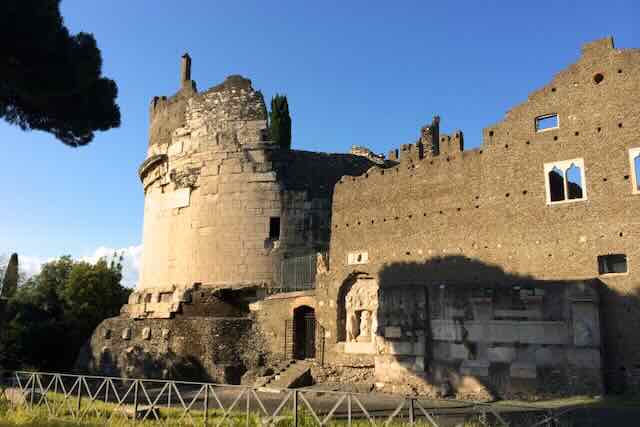
But the tunnels were a convenient way to bury a lot of people in a relatively safe way, far from the city limits. The bodies were usually wrapped in 2 layers of linen, sprinkled with lime to help mask the smell, and placed in loculi , or small niches cut into the walls of the tunnels. When you visit the catacombs, you will also notice smaller loculi for children.
The catacombs were built over the course of several centuries, with the majority built during the 3rd and 4th centuries CE.
What were the catacombs of Rome used for?
The Rome catacombs were used as a place to bury the dead.
This included people of all faiths, Christian, Jewish, and pagan.
The word " cemetery " derives from the Greek word for "sleeping place", and this is exactly what the catacombs were - a place for the dead to rest.
The word "catacomb" also derives from Ancient Greek. " Kata " meant "near" and " kymbas " meant "cave". This in turn became the Latin " cata cumbas ", in English catacombs meaning "among the graves".
Contrary to popular belief, they were likely not used as a place for Christians to meet in secret to avoid persecution.
Ready to plan your trip?
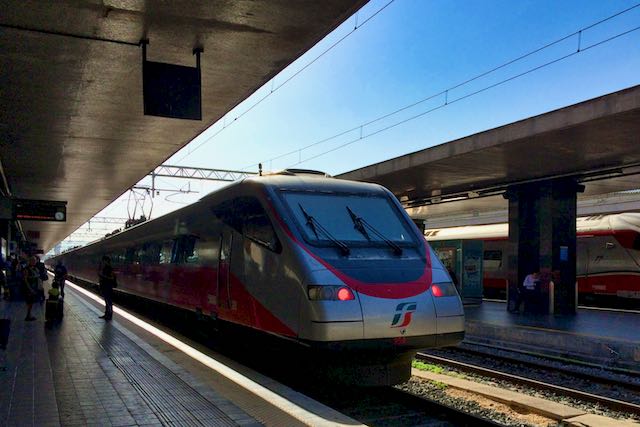
How many people were buried in the catacombs of Rome?
As the tunnels go for miles and miles (much of this has not been excavated), and as the dead were often piled on top of each other, thousands upon thousands of people were buried in the Roman catacombs.
Are there still bodies in the catacombs of Rome?
There are no longer any visible bodies buried in the catacombs of Rome. The catacombs are now mostly empty. Some of the bodies that were once buried there have been moved to other burial sites, and in many cases, the remains have simply disintegrated over time.
How long are the Rome catacombs?
There are several catacombs around Rome, and some of them have not even been excavated yet. But of those that have been, there are miles and miles of them. One could easily get lost in there, which is one reason you must visit as part of a guided tour .
Christian history of the Roman catacombs
What did the first christians use the catacombs of rome for.
Christianity began to spread through Rome in the mid-1st century CE, and by the 2nd century CE there was a large and thriving Christian community in Rome.
The catacombs were an important part of early Christian life in Rome. They provided a place for Christians to bury their dead.
This tradition continued until around the 5th century CE.
Is it true that Christians would meet in secret because Christianity was banned?
The idea that the catacombs were used by Christians as a place to meet in secret because they were being persecuted has largely been discredited - most scholars today debunk this urban myth.
First of all, the persecution of Christians was sporadic and inconsistent, happening over long stretches of time.
Second of all, the catacomb locations were well-known, so it would be hard to hold secret meetings there.
It is more likely that when people, Christian or otherwise, met in the catacombs, it was to celebrate their dead family members.
What are the features of the Christian catacombs?
They're home to a wealth of early Christian art.
This includes examples of early Christian symbol like the Good Shepherd, as well as depictions of scenes from the Old Testament.
You will also find many examples of early Christian inscriptions or graffiti in the catacombs. This writing often contains the names of the dead which helps us to understand who was buried there.
One of my favorite catacombs is the catacomb of Santa Priscilla. There you can see the earliest known depiction of Mary as mother of God.
What are the cubicula?
The function of the cubicula was to provide small, private burial chambers for wealthy families, something like a family crypt.
Each cubiculum consisted of a number of small rooms that were used to bury the dead. The rooms were often decorated with Christian symbols and inscriptions.
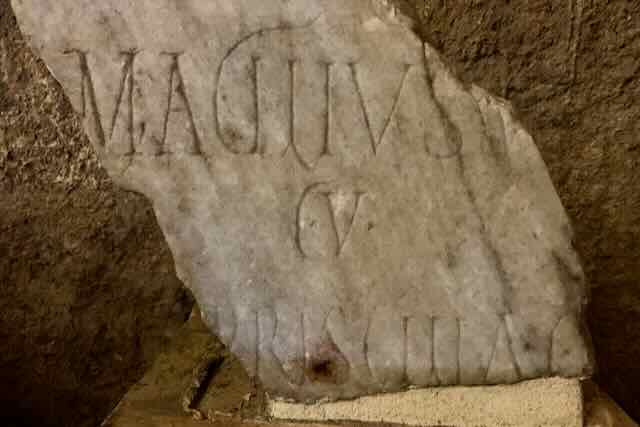
The catacombs also contain arched recesses called arcosolia . The word derives from Latin arcus , "arch", and solium , "throne".
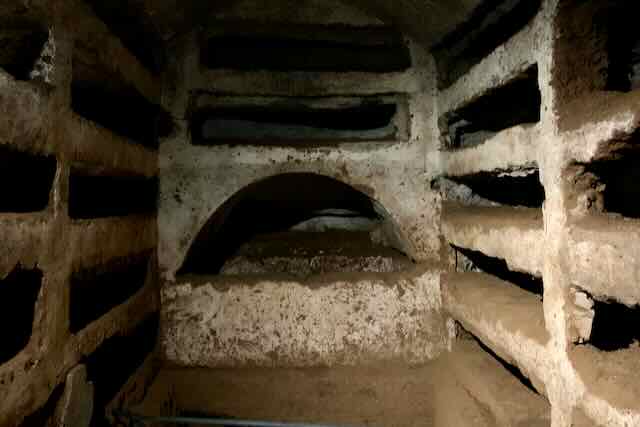
How to visit the catacombs of Rome
Which catacombs can you visit in rome.
The catacombs you can easily visit in Rome are the catacombs of Callixtus , Sebastian , Saint Domitilla , Agnes , Priscilla , and Marcellinus and Peter .
There are a few more that you can visit only upon request, such as the catacombs of Comodilla or San Pancrazio.
There are six known Jewish catacombs in Rome. Only two are open for visits - the tombs at Vigna Randanini and at Villa Torlonia (these are currently being restored, so as of 2022 are not open to visitors). These catacombs, while sometimes available for visits, are not regularly open. The only way to see them is with a guided visit upon special request. Some tour companies offer these visits - take a look at the following options:
- Jewish Roma Walking Tours
- Roman Jews - Jewish Catacombs Tour
- Walks Inside Rome - Jewish Catacombs and Appian Way Tour
Other examples of burial places or tombs in or near Rome you may want to visit include:
- Saint Peter's tomb
- The Capuchin Crypt (not a catacomb, but the best place to see bones if you are interested)
- The Mausoleum of Augustus and the Mausoleum of Hadrian (today Castel Sant'Angelo .)
- If you are interested in cemeteries , we have some beautiful and interesting ones in Rome.
- Etruscan tombs not far from Rome (a great day trip from Rome or shore excursion)
You can also see some Etruscan tombs in the Villa Giulia and inside the Vatican Museums' Etruscan wing.
What is the best time to visit the catacombs in Rome? What are the opening hours of the catacombs? What is the entrance fee?
All the catacombs have differing opening hours so you can almost always find one open. Many of them have a period of closure in summer or winter .
- San Callisto : Open Monday - Tuesday, Thursday - Sunday 09:00 - 12:00, 14:00 - 17:00. Closed on Wednesdays, on holidays: January 1st, Easter (April 17th), Christmas (December 25th) and during winter (20 January - 15 February)
- San Sebastiano : Open Monday - Wednesday, Friday-Sunday 10:00 - 17:00 (last visit starts 16:30). Closed on Thursdays and during winter (25 November - 25 December)
- Santa Domitilla : Open Monday, Wednesday - Sunday 9:00 - 12:00, 14:00 - 17:00 (The last guided Rome catacombs tour begins 20 minutes before closure, both in the morning and in the afternoon). Closed on Tuesdays, and during winter (17 December - 14 January)
- Santa Priscilla : Open Tuesday - Sunday 09:00 - 12:00, 14:00 - 17:00. Closed on Mondays, on holidays (Christmas, 1 January, Easter) and during summer and winter pause (27 December 2021 - 13 January 2022 and 16 - 29 August 2022)
- Sant'Agnese : Open Thursday - Friday: 9:00 - 12:00, 15:00 - 18:00; Saturday 9:00 - 12:00, 15:00 - 19:00; Sunday: 15:00 - 18:00. Closed on Mondays, on mornings of religious holidays (Christmas, Easter, August 15th, January 1st) and during November
- Saints Marcellinus and Peter : Open Monday - Wednesday, Friday – Sunday 10:00 - 12:00, 14:00 - 17:00. Closed on Thursdays and during August.
Can you visit the catacombs without a guide?
No, you must go with a guide. You cannot buy Roman catacombs tickets and walk around on your own inside.
In some cases, you can go with a guide working for the site. In many cases, you can book a tour with a tour company . This can be convenient because with a tour company you can usually see more than one site, and transportation is often included.
Can you take pictures in the catacombs?
No, you cannot take pictures or film inside the catacombs.
You can, however, take a tour on Google. Just visit Google maps, enter the name of the catacombs you want to see, and when the results come up, choose image mode. Here is Santa Priscilla for example .
What should you wear when visiting the catacombs?
You should wear comfortable shoes as you will be doing lots of walking. You may want to bring a sweater or jacket as it can be chilly underground Rome - this is a great way to keep cool in the summer !
Finally, because these are considered holy sites, you should make sure to cover knees and shoulders, as you would when visiting the Vatican or other holy site.
For more tips about what to pack for a trip to Rome, visit our page here .
No matter what season you visit Rome, here are 4 things never to leave at home:

Disclosure: If you make a purchase through a link on this page, I may receive a small commission - at no extra cost to you. Thank you for supporting my site!
Is it claustrophobic? How long do visits or tours last?
The guided tours generally last around 1-2 hours.
If you are very claustrophobic, you may not enjoy a visit to Rome's catacombs. Some of them are quite small and cramped. In some cases, the tunnels lead to larger openings but overall, it can be a claustrophobic visit.
How to get to the catacombs of Rome?
The catacombs of Rome are all over the Eternal city.
If you do not take a guided tour that includes transportation, you could take a taxi , but you'll want to have a way to call or order a taxi for the return trip.
Probably the best way to reach a catacomb is by public transportation . There is no Metro stop that's very near to any of the catacombs, but quite a lot of bus routes will get you close to them.
The Hop-on Hop-off buses stop near the catacombs along the Appian way .
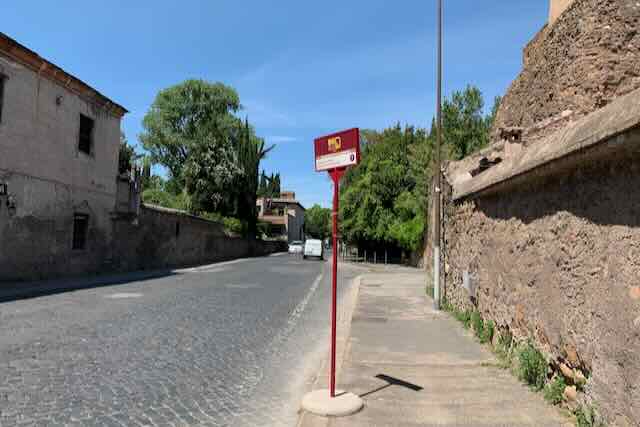
One nice way to visit the Appian Way catacombs is to go by bike - you can rent bicycles in the area and cycle in the Caffarella Park nearby.
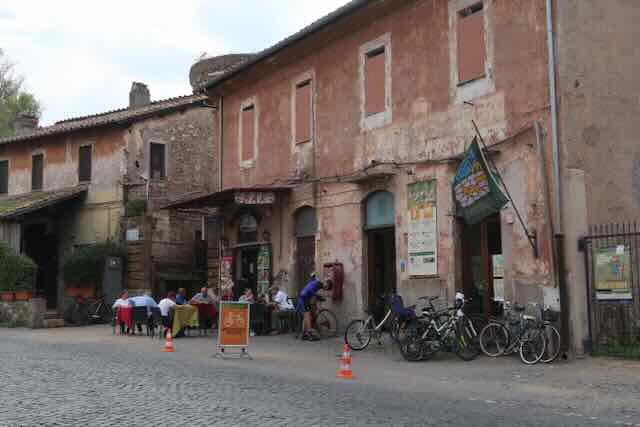
Here's how to get to the main Rome catacombs:
Appia Antica Catacombs
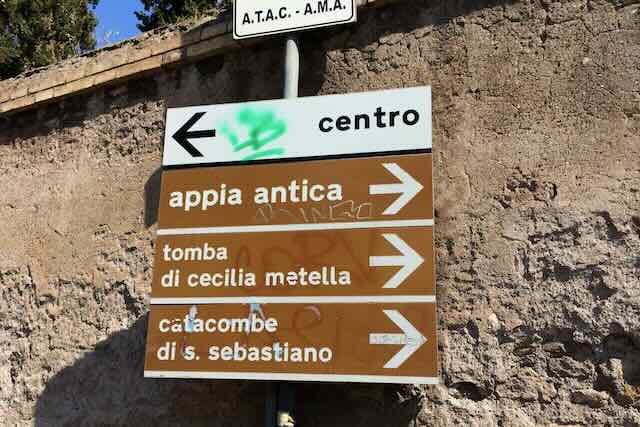
Three of Rome's best-known catacombs are near each other, on or near the Appian Way in the southern part of Rome.
- Catacombs of San Callisto (Via Appia Antica, 110/126) - The 118 bus drops you about 2 minutes' walk from the entrance. The 218 bus drops you about 5 minutes' walk from the entrance.
- Catacombs of San Sebastiano (Via Appia Antica, 136) - The 118 bus stops almost in front of these catacombs. The 218 bus stops at Fosse Ardeatine which is about a 10 minute walk to these catacombs.
- Catacombs of Santa Domitilla (Via delle Sette Chiese, 282) - These are also along the Via Appia Antica but in a different spot from the above two. The 714 bus and the 30 express bus both stop at Navigatori, about 9 minutes from here. The 218 bus stops at Fosse Ardeatine which is about a 5 minute walk away.
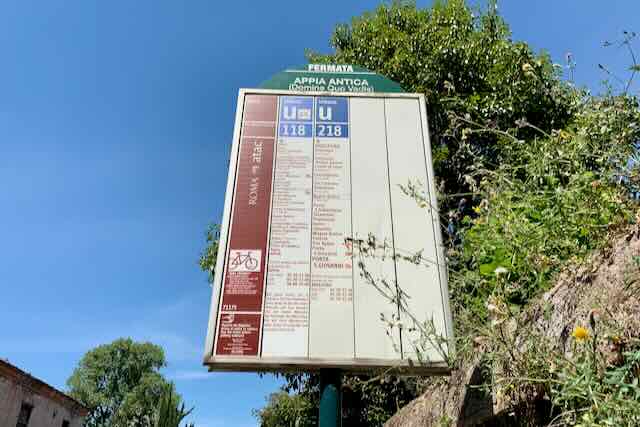
Catacombs in northern Rome:
- Santa Priscilla (Via Salaria, 430) - The 92 bus and the 310 bus each stop a few minutes from the entrance.
- Sant'Agnese (Via Nomentana, 349) - Being on a very busy road, there are many city buses that stop just outside the entrance to this site.

Catacombs in eastern Rome
- Saints Marcellinus and Peter (Via Casilina, 641) - The tram Giardinetti stops right in front, as does the 105 bus.
What will you see in the catacombs of Rome?
While all the catacombs in Rome were the burial place for ancient Romans, they all have different things for you to see.
Some, such as the Catacombs of San Callisto were home to the final resting place of prominent individuals - these catacombs are nicknamed “the little Vatican ”, because 9 popes were buried here.
Even more impressive examples of important figures are at the Catacombs of San Sebastiano, which is where St Paul and Peter were both initially buried.
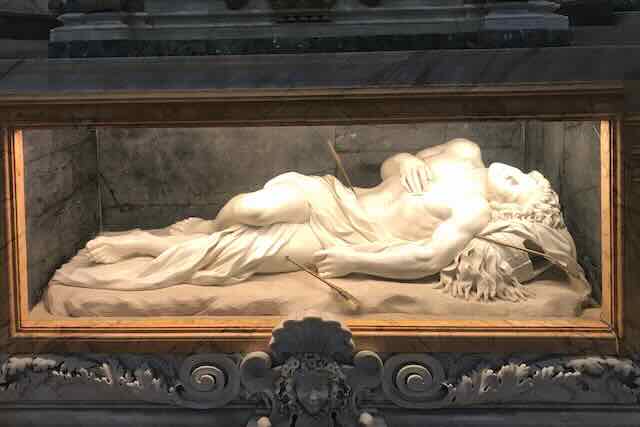
The Catacomb of Santa Domitilla is the only location you can visit that still has human remains. It also has a 4th century basilica inside where you can worship, with vividly restored frescoes.
The Catacomb of Santa Priscilla is inside a monastery. You will see stunning intact frescoes, including the earliest known depiction of Mary with the baby Jesus, and because there were so many martyrs and popes buried here, they're nicknamed the regina catacumbarum , the queen of the catacombs.
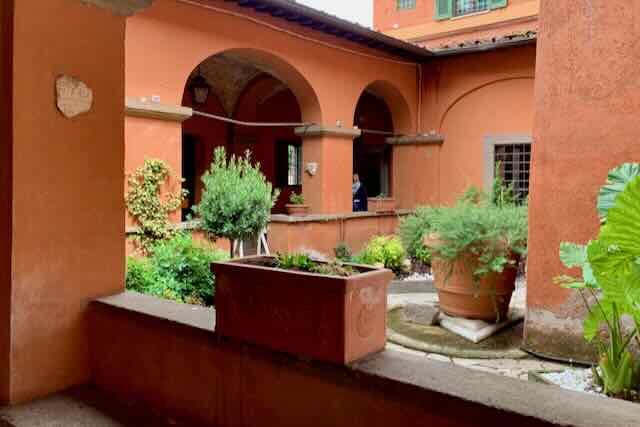
The catacombs of Sant'Agnese are under the basilica of the same name, and next to the Mausoleum of Santa Costanza. It's worth taking a tour of the entire complex.
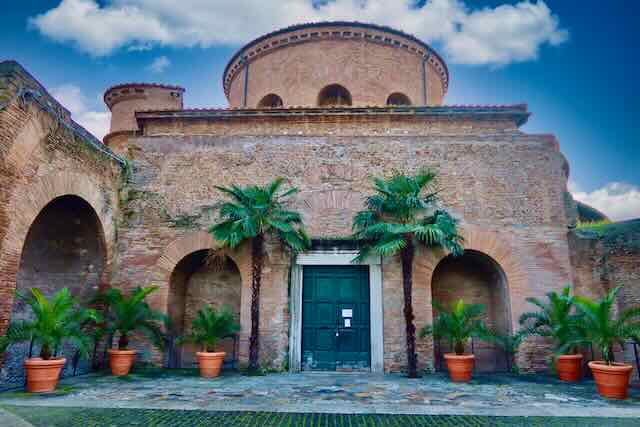
The catacombs of Saints Marcellinus and Peter are under the Mausoleum of Saint Helen, today a museum.
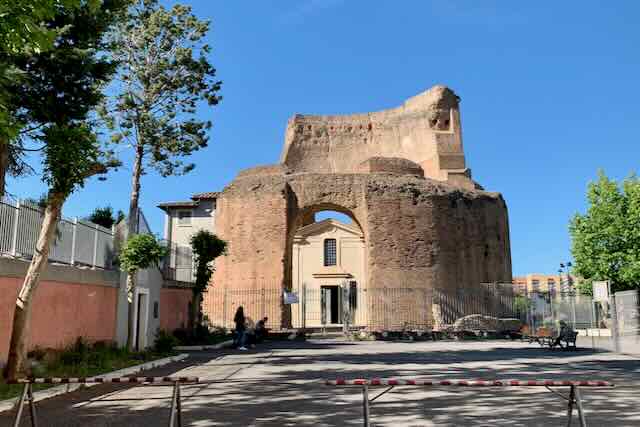
Is it worth visiting the Rome catacombs?
They definitely are worth visiting for these reasons:
- If you're interested in Ancient Rome, this is a great way to learn about how the Romans handled death and burial, and how early Christians celebrated their dead.
- The catacombs are usually not on people's bucket lists so tend to be less crowded than the " must-see " attractions in Rome.
- If you're interested in art, this is the perfect way to learn about early fresco art techniques and themes.
- Visiting the catacombs and other underground sites can be a nice way to cool down in summer. The exception is Saint Peter's tomb (not a catacomb), which is actually hotter than above ground, and is best visited from fall through spring , and avoided in summer if possible.
If you had to pick one, which is the best catacomb in Rome?
Many people would say that the catacombs of San Callisto are the best catacombs to visit in Rome. They are the largest and most well-known.
My favorite is the catacomb of Priscilla, not only for its beautiful frescoes, but also because it is lesser known, and therefore not as crowded as some of the others .
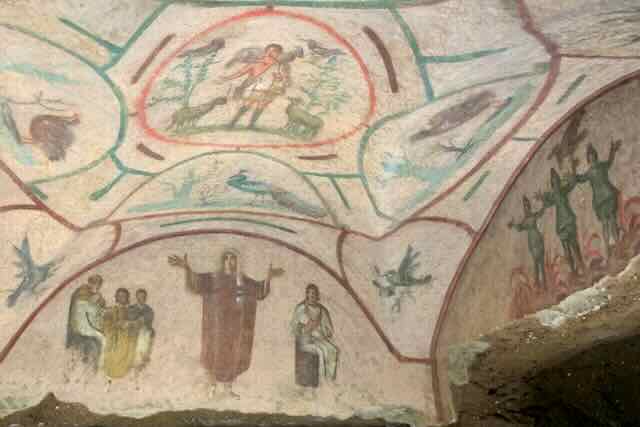
No matter which catacombs you visit, you are sure to have an interesting and educational experience.
For more information, visit the website of the commission responsible for the catacombs for opening hours, catacombs Rome map and more.
Want to save this to Pinterest? Pin it here!
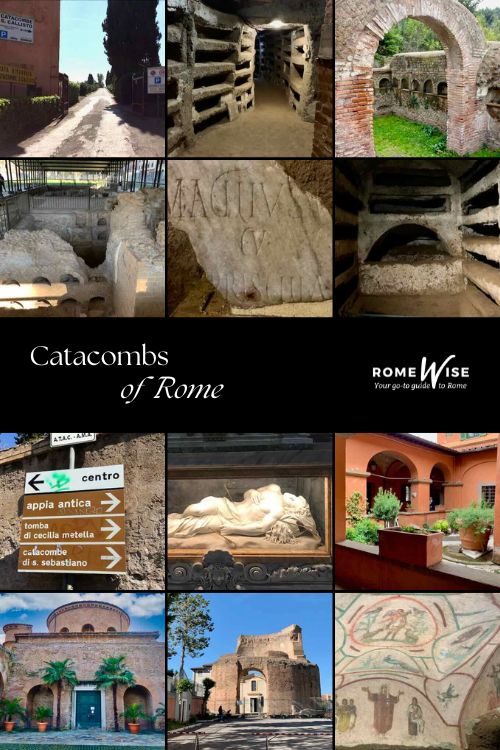
Get your 100% free Rome trip planner now!
Simply sign-up today for our free newsletter and get the Romewise Quick Start guide to Rome:
We are committed to respecting your data. Click for our Privacy Policy .
Comments? Questions? Suggestions?
Please come over to the private Romewise Facebook group and join in the conversation.
You will often find me there, happy to answer your questions / comments!
You will also meet other Rome lovers and experts, too.
What are you waiting for?
Come join in the fun !

Read here about our sponsorship policy
Top attractions and tours

- Colosseum - Don't miss visiting Rome's most iconic monument
- Vatican Museums - This is where the Sistine Chapel is
- Pantheon - Book ahead and skip the line
- Galleria Borghese - You'll need to book ahead for one of Rome's best museums
- Castel Sant'Angelo - See Rome's history through its architecture
- Rome City Pass - A great way to make your Rome visits easier
Disclosure : If you make a purchase through a link on this page, I may receive a small commission - at no extra cost to you. Thank you for supporting my site!
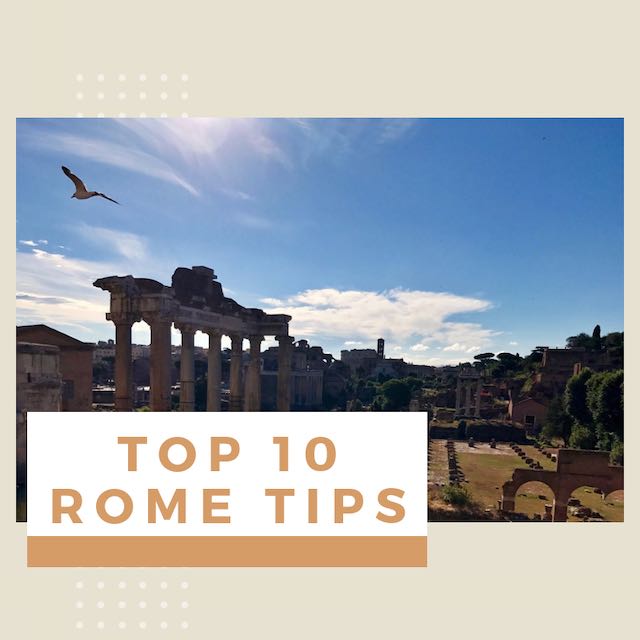
New to Romewise? Start Here
Get the most out of Romewise
Coming To Rome?
Weather in Rome
Accommodation
Already in Rome?
Things to Do
Home | About Me | Privacy Policy | Legal Disclaimer | Affiliate Disclosure | Contact Me
Copyright © 2009-2024 by Elyssa Bernard, Romewise.com | All Rights Reserved.

- Nov 9, 2023
- 15 min read
A Guide to Rome Catacombs: Everything you Need to Know
Updated: Nov 14, 2023
Introduction:

Rome's catacombs represent a historical intertwining of faith, death, and the art of burial, offering an unparalleled glimpse into the spiritual life of the early Christians. As you consider delving into this subterranean world, here's a comprehensive guide to prepare for your journey.
Origins of the Term 'Cemetery'
The term "cemetery" holds its etymology in the Ancient Greek word meaning "place of rest," reflecting a serene finality. The catacombs of Rome, an intricate labyrinth of narrow passageways beneath the city’s edge, encapsulated this sentiment. Here, the first Christians in Rome found their final resting place, an intricate underground network that bore witness to their hope for resurrection and salvation.
The Catacombs: Rome's Underground Enigma
A journey into the catacombs is like a descent into the pages of history. These catacombs were not only the resting place of martyrs and saints but also of everyday individuals like farmers—all part of the nascent Christian community. The vastness of these subterranean tunnels, housing hundreds of thousands of the deceased, is a humbling reminder of the past. Located adjacent to the venerable Appian Way, these catacombs present an entangled maze so complex, that without a knowledgeable guide, one could become a permanent addition to its ancient enigma.
Subterranean Symbolism: The Catacombs' Spiritual Significance
Visitors are often captivated by the catacombs' spiritual resonance, an echo of the enduring faith of those who once walked the streets of ancient Rome. These catacombs are an emblem of the trials and tribulations faced by early Christians and their unwavering hope for a life beyond death.
A Modern Pilgrimage: Touring the Appian Way and Catacombs
Embarking on a tour along the Appian Way is a journey through time. The road itself is lined with relics and whispers of the past, from imposing tombstones to the picturesque Roman countryside. Yet, the catacombs remain the centerpiece of this historical pilgrimage. Venturing deep beneath the earth, visitors traverse corridors carved with the simplest of tools, an enduring testament to the sheer will and devotion of Rome's early Christians. These tours do more than illuminate history; they provide a profound connection to the nascent moments of Christianity—a Rome seldom seen and rarely experienced.
Ensuring a Memorable and Enlightening Experience
A visit to Rome's catacombs is more than a simple tourist excursion; it's an emotive expedition offering insight into the world of those who lived two millennia ago. By choosing to explore these ancient passageways with a guide, one not only ensures safety but also gains access to the rich tapestry of stories and historical context that might otherwise remain buried in the sands of time.
Remember, the catacombs are not merely an attraction; they are hallowed ground, a place of deep historical and religious significance. As such, visitors are encouraged to approach with respect and a readiness to discover the profound legacy of Rome's early Christian ancestors.
Table of Contents:
What are the catacombs, history of the catacombs in rome, facts about rome's catacombs, visiting rome's catacombs, tickets for the catacombs, what to see at the catacombs, insider tips.
In Conclusion
Crypts & Catacombs Tour
Rome Catacombs Tour
Understanding the Catacombs: Rome's Underground Sanctuaries
The catacombs of Rome stand as enigmatic portals to the ancient past, beckoning the curious to uncover the sacred practices of early Christian burials. Here, we delve into the essence of these cryptic tunnels and the traditions that led to their creation.
The Birth of the Catacombs
The Appian Way, one of Rome's oldest and most significant roads, serves as more than a historical thoroughfare; it is a bridge to the city's ancestral rituals. The catacombs here were not a mere matter of choice but a necessity, as early as the 5th century BC, due to Roman law prohibiting burials within the city's sacred boundaries. This led to the establishment of necropolises at the city's margins, with the Appian Way, the crucial artery to the south, becoming a preferred burial ground.
A Refuge for the Deceased
For Romans, the commemoration of the dead was an affair marked by roadside monuments and elaborate tombs. In contrast, early Christians opted for a more discreet, communal form of burial, carving out extensive networks of tunnels into the soft volcanic tufa rock beneath Rome. These catacombs became the final resting place for a multitude of believers, from the most venerated saints and martyrs to the multitude of unsung Christians.
The Appian Way's Holy Underground
The catacombs along the Appian Way are significant not only for their spiritual importance but also for their historical and architectural merit:
The Catacombs of St. Domitilla (Santa Domitilla):
As the oldest and most sprawling catacomb complex, it showcases the longevity and extent of early Christian burials, offering visitors a rare glimpse into antiquity with some areas still adorned with skeletal remains.
The Catacombs of St. Callixtus (San Callisto):
This is the most extensive and frequently visited network, renowned for its early Christian art, a testament to the faith and artistic expression of the era's devout.
The Catacombs of St. Sebastian (San Sebastiano):
A site of significant pilgrimage, reputed to have once cradled the remains of Apostles Peter and Paul, and home to a treasure trove of ancient Roman and Christian tombs, epitomizing the confluence of cultures.

A Tour Through Time
Embarking on a catacomb tour is to step into the past, tracing the hallowed steps of history. Each catacomb offers a unique narrative, a distinct glimpse into the socio-religious fabric of early Christianity. As you traverse the labyrinthine corridors, you encounter not only the sacred silence of the crypts but also the evocative artwork and inscriptions that speak volumes of a bygone era's beliefs and ways of life.
In conclusion, Rome's catacombs are not simply ancient tunnels but sanctuaries of history. They serve as a testament to the resilience of faith and the human spirit in the face of adversity and temporal law. Through these tours, visitors can connect with the distant past, engaging with stories etched into the very stones beneath Rome's bustling life.
Tracing the Epochs: The Evolution of Rome's Catacombs
The catacombs of Rome offer a silent narrative of the city's transformation from the zenith of imperial grandeur to the symbolic heart of Christianity. This section unveils the catacombs' historical journey and their significance in the broader tapestry of Rome's history.
The Contrast of Ancient Burial Customs
As one strolls the Appian Way, the stark disparity between ancient Roman and early Christian burial practices is evident. Grand monuments like the Mausoleum of Cecilia Metella stand as a testament to the wealth and power of Rome's elite. These opulent edifices, erected for the nobility, contrast sharply with the modest beginnings of Christian burial sites. Unable to afford such lavish memorials, the early Christians sought refuge in the subterranean depths, carving out their sanctuaries beneath the land.
The Christian Underground: A Realm of Equality
The catacombs became the great equalizer in death. Here, the bodies of hundreds of thousands of Christians, from revered saints and martyrs to common folk, were interred on multi-tiered shelves, a humble yet poignant reminder of the community's unity in faith and fate.
Middle Ages to Modern Rediscovery
With the catacombs falling into disuse by the Middle Ages, they slipped from the collective consciousness of Rome, their entrances overgrown and their memory fading into legend. It was not until the resurgence of interest during the 18th century, particularly among the intrepid travelers of the Grand Tour, that the catacombs were thrust back into the limelight. Intrepid explorers, drawn by the allure of the past and the thrill of discovery, ventured into the catacombs’ enigmatic embrace, guided by the flicker of candlelight.
The Catacombs Today: A Journey into the Past
Today, although stripped of bones and the physical remnants of those who once lay within, the catacombs remain a poignant pilgrimage site. They invite the modern visitor to step away from the sunlit splendor of Rome into the dimly lit passages that once cradled the city's earliest Christian ancestors. These tours are not only an exploration of the physical tunnels but also a journey through the annals of early Christian history, offering an alternative perspective on Rome's cultural and religious evolution.
The catacombs, now absent of their original occupants, continue to captivate those who seek a deeper understanding of Rome's complex past. Each silent corridor and empty tomb offers a story, an indelible connection to the lives and beliefs of the early Christians. For today's seekers of history or the simply curious, Rome's catacombs stand as an enduring testament to a faith that once, and still, shapes the world above.
Deciphering the Catacombs: Revelations from Rome’s Underground Labyrinths
The catacombs of Rome hold countless stories in their silent chambers, their origins and rediscovery as shrouded in mystery as the tunnels themselves. This section aims to illuminate some intriguing facts about these subterranean wonders.
Etymology and Origin of 'Catacomb'
The term "catacomb" itself whispers of antiquity, rooted in the Greek words 'kata' and 'kymbas', suggesting proximity to caves. Adopted into Latin as 'cata tumbas', it aptly described the resting places nestled among the graves along the Appian Way. These ancient names evoke the catacombs' essence as communal resting places by the caves.
A Serendipitous Rediscovery
Antonio Bosio, the intrepid explorer of the 16th century, stumbled upon the catacombs almost as if by fate, his quest nearly leading him to a permanent residence among the ancient dead of St. Domitilla. His subsequent work, "Roma Sotterranea," became a foundational text for the archaeological community, offering insights and guidance into the catacombs' depths that continue to benefit researchers and historians today.
St. Domitilla and Her Legacy
The Catacombs of St. Domitilla carry the legacy of a devout Christian woman from the influential Flavian family, cast into exile and ultimately finding eternal rest in a familial mausoleum that would later bear her name. The catacombs emerged as a poignant homage, a place where faith and social status intersected in death.
Resting Places of Saints and Martyrs
Throughout the warren of catacombs, saints were interred, their remains sometimes relocated to other sacred sites as their veneration grew. The notable shifts of St. Cecilia to a cathedral in Trastevere and the absence of St. Sebastian, St. Peter, and St. Paul from the catacombs bearing St. Sebastian’s name reflect the evolving landscape of religious relics. However, the catacombs still cradle the remains of lesser-known martyrs and saints, serving as hallowed pilgrimage destinations.
The Unseen Labyrinth
Today's catacomb tours offer but a glimpse into the sprawling network that ancient Rome's Christians created. What visitors traverse is a mere fragment of the entire subterranean matrix, with vast sections remaining shrouded in darkness, their secrets locked away in history. Archeologists continue to theorize about the full scale of these underground sanctuaries, suggesting an expansive complex that might never be fully uncovered or understood.
The catacombs of Rome, in all their elusive grandeur, stand as a testament to early Christian life and death, a reminder of a community that thrived on the edges of ancient society. They beckon the living to remember, to explore, and to wonder at the profound legacy left in the depths beneath the Eternal City.
Unveiling the Journey to Rome's Ancient Underground: A Visitor's Guide
Embarking on a voyage to the past, the catacombs of Rome await beneath the storied cobblestones of the Appian Way. This guide is meticulously crafted to ensure a seamless pilgrimage to these venerable relics of early Christianity.
Embarking from the Heart of Rome
While the catacombs are nestled away from the bustling city center, modern Rome has embraced these ancient sanctuaries within its urban sprawl, making them accessible for the intrepid traveler. Here's how to navigate your way:
Via Public Transport: The 118 Bus Odyssey
The 118 bus, a chariot of the modern age, wends its way from the grandeur of the Colosseum, past the Circus Maximus, and onward along the Via Appia Antica. Alighting at the catacombs is made easy with stops directly in front of these subterranean marvels. To circumvent the whims of Roman bus schedules, arm yourself with real-time updates from a transport app such as Muoversi a Roma, transforming potential waits into mere moments.
The Cyclist’s Path
For those wishing to blend the joy of exploration with the rhythm of the pedals, cycling to the catacombs offers a delightful prelude to the underground tour. Rental havens near the Appian Way’s origin provide the steeds for your adventure, which can extend beyond the catacombs, especially on Sundays when the ancient road transforms into a haven free from the modern chariot's hustle.
A March through History
Only the most ardent of walkers are advised to undertake the trek to the catacombs on foot. Those setting out from points like Circus Maximus or the Baths of Caracalla will find the journey manageable, with St. Callixtus welcoming visitors a mere 20 minutes from Porta San Sebastiano. Caution is urged where the pathway wanes, as travelers must share the road with vehicles.
A Word to the Wise: Secure a Ride Home
Regardless of how you arrive, it is prudent to keep a local taxi service’s contact details at hand. Roman buses are fickle, and after delving into the catacombs' depths, even the most resilient of explorers may prefer a restful chariot ride back to the city's heart.
Effortless Explorations: The Rome Catacombs Tour
For those seeking to immerse themselves fully without the encumbrance of logistics, our Rome Catacombs Tour offers an all-encompassing experience with transport included, ensuring your focus remains on the awe-inspiring history that lies beneath.
This guide serves as your compass to navigate the terrain above before you uncover the stories of antiquity below, making your visit to Rome's catacombs a chapter in your journey as timeless as the Eternal City itself.
Securing Your Passage to the Past: Catacombs of Rome Ticket Guide
Unlocking the secrets of ancient Rome requires more than just a map and a sense of adventure. Here's your key to ensuring that your journey into the depths of the city's history is guaranteed.
St. Domitilla's Subterranean Labyrinths
Availability: Open daily, save for Tuesdays.
Admission: A portal fee of €8 opens the gates to this realm of history, with tickets procurable via an online system reminiscent of bygone days or at the on-site ticket office.
Visitation Hours: The hours of passage are from 9:00-12:00 and 14:00-17:00, providing ample time to explore the depths.
The Vast Expanse of St. Callixtus
Availability: Welcoming visitors every day.
Admission: For €8, travelers can secure their entry online or at the ticket office, ensuring access to some of the most poignant Christian art and sanctified relics.
Visitation Hours: Open from 9:00-12:00 and 14:00-17:00, St. Callixtus offers a glimpse into the spiritual heart of ancient Christian Rome.
The Sacred Ground of St. Sebastian
Availability: Open daily, except for Sundays, and closed throughout December.
Admission: Tickets are priced at €8, available exclusively at the ticket office. Advanced booking is reserved for group pilgrimages, accessible via phone or email.
Visitation Hours: From 10:00-17:00, tread the paths once walked by saints and martyrs.

Maximizing the Experience: A Guided Exploration
For those desiring a comprehensive understanding of these sacred spaces, our catacombs tour in Rome includes a thorough exploration of St. Domitilla. By joining our expert-guided tour, you can delve deeper into the catacombs' history, symbolism, and the enduring legacy of the Christians who once sought refuge and eternal rest within these walls.
When planning your descent into history, this guide will ensure your exploration is not left to chance. Prepare to step beyond the veil of time with your tickets secured and witness the catacombs of Rome as few have seen them before.
Unearthing Ancient Wonders: Highlights of Rome's Catacombs
Embark on a time-traveling expedition to the catacombs of Rome, where the whispers of the early Christians resonate through the art and symbols etched in these subterranean sanctuaries.
Marvels of St. Domitilla
Rediscovered Beauty: The catacombs here are a canvas of restored frescoes, with the spotlight on a magnificent ceiling fresco portraying Christ. The crypt known as "the room of the bakers" boasts vibrant decorations that narrate tales of ancient livelihoods and devotion. Awaiting public unveiling, these areas, along with an anticipated new museum, will soon enrich the visitor experience.
Symbols in Stone: St. Domitilla showcases an array of Christian symbols. The olive branch-carrying dove and the salvation-representing anchor are among Rome's earliest Christian art, offering insight into the symbols' profound meanings.
Pagan Artifacts: Beyond the Christian imagery, the catacombs preserve pagan splendors, such as the 3rd-century AD painted cubiculum depicting the myth of Cupid and Psyche, symbolizing the soul's journey and the power of love.
Secrets of St. Callixtus
Labyrinthine Legacy: With miles of tunnels reaching heights of 70 feet, St. Callixtus presents an underground marvel. It houses "the little Vatican," an enclave where nine popes found their resting place, their presence marked by original Greek inscriptions.
Artistic Echoes: The catacombs bear Christian frescoes adorned with timeless symbols—the fish, dove, and phoenix. Family tombs converted into sanctified chambers host some of the most significant frescoes, revealing stories of faith and life eternal.
Saint Cecilia's Crypt: While St. Cecilia's remains have been moved, visitors can still pay homage to her original burial site, a crypt steeped in reverence and history.
The Wonders of St. Sebastian
Tombs of Antiquity: St. Sebastian's catacombs offer a unique perspective with well-preserved Ancient Roman tombs, initially part of an above-ground pagan necropolis. The stucco decorations within the burial chamber are testimonies to the artistry of a bygone era.
Saintly Sculpture: Although St. Sebastian's remains are elsewhere, a Bernini-attributed bust provides a poignant reminder of the martyr's eternal legacy.
Artistic Imprints: With artifacts like Jonah's cubicle paintings and the rich frescoes adorning the mausolea, the catacombs of St. Sebastian are a gallery of ancient narratives waiting to be discovered.
In the catacombs of Rome, the stones speak, the art tells tales, and the echoes of the past invite you to look closer. Your visit promises more than just a tour; it's a pilgrimage through time, art, and faith, etched in the silent corridors beneath the Eternal City.
Navigating the Depths: Essential Advice for Rome's Catacombs
Delving into the catacombs of Rome is a journey unlike any other, a literal step down into history. To ensure a seamless and respectful experience, here are some insider tips to keep in mind:
Confronting Claustrophobia:
The catacombs are a network of narrow, hand-hewn tunnels. They're intimate and enclosed, so if tight spaces make you uneasy, prepare mentally or consider this when deciding to visit.
Sacred Dress Code:
Remember, the catacombs are hallowed ground. Dressing modestly is not just a sign of respect; it's a requirement. Shoulders should be covered, and skirts or shorts should be of a modest length.
Guided Tour Variance:
While each catacomb provides its own guides—often monks or priests—the experience may vary. Some may offer spiritual insights along with historical facts. For a more balanced exploration, consider a group tour like our San Domitilla tour for a comprehensive historical narrative.
Explore Above Ground:
The catacombs are only one layer of Rome's rich religious history. Near St. Sebastian's catacombs, visit the church of San Sebastiano fuori le mure. Marvel at the artifacts, including the saint's statue and the legendary arrow.
Trace the Steps of St. Peter:
Don't miss the church of Domine Quo Vadis, steeped in the lore of St. Peter's vision of Christ. It houses what many believe to be the marble-encased footprints of Jesus.
Dining Options:
The catacombs are somewhat isolated, with limited dining nearby. Plan ahead with a picnic in the park or indulge in a meal at local establishments like the Appian Way Café for a casual bite, or L’Archeologia for a more upscale dining experience.
Visiting Rome's catacombs is more than a simple tour; it's a pilgrimage into the past. With these tips in hand, your expedition through these ancient underground corridors will be enriched with respect, understanding, and the right dose of adventure.
In Conclusion: Embracing the Echoes of Antiquity
As our journey through the hushed and hollowed grounds of Rome's catacombs comes to an end, we are left with more than just echoes of the past; we carry with us the weight and whispers of history. These catacombs, a somber lattice beneath the bustling life of modern Rome, serve as a solemn reminder of the city's layered and spiritual heritage.
Walking the same paths that early Christians did, under the soft illumination that dances across ancient frescoes and inscriptions, is to walk through a portal in time. In these cool, subterranean galleries, we find ourselves in intimate communion with those who came before us, their stories etched in stone and preserved in silence.
The catacombs remind us of Rome's enduring legacy, one that has witnessed the full spectrum of humanity, from the mundane to the divine. They challenge us to reflect on our own existence, our beliefs, and the mark we wish to leave for future generations to ponder.
In this sanctified darkness, with the company of martyrs, saints, and countless souls, our hearts beat in unison with the timeless rhythm of history. Here, in the catacombs, Rome's eternal heart pulses, inviting us to listen, to learn, and to remember.
Whether you came seeking knowledge, solace, or the thrill of exploration, may you leave with a sense of connection to the eternal city and the countless lives that have shaped its narrative. The catacombs of Rome, with their silent majesty and enduring presence, are not just a destination but a journey—one that resonates deeply within the chambers of the soul.
Let us carry the memory of our journey into the catacombs as a treasured keepsake, a humbling encounter with the past that enriches our understanding of the human spirit. As the light of day welcomes us back from the depths, may we hold in our hearts the serene beauty and profound tranquility of the catacombs, an indelible part of Rome's immortal story.
Sacred Journeys Beneath Rome: Exclusive Catacomb Tours with Roma Experience
Embark on a profound journey through the sacred underworld of Rome with Roma Experience's bespoke catacomb tours. Whether you choose the intimate encounter of standing alone in St. Agnes' Catacomb with our "Crypts & Catacombs Tour," or the rare opportunity to uncover hidden histories with "Catacomb Tour with Exclusive Underground Access," each tour promises a unique and deeply moving exploration of the eternal city's most ancient sanctuaries. These meticulously curated experiences offer an unparalleled glimpse into the spiritual bedrock upon which Rome is built, inviting you to traverse time and tradition in the silent footsteps of the past.

Step back in time with Roma Experience's "Crypts & Catacombs Tour," where the whispers of early Christian Rome echo through the solemn corridors of antiquity. This immersive tour takes you into the heart of devotion and memory, as you stand alone in the hallowed St. Agnes' Catacomb. Traverse a sacred past across three venerable burial grounds and connect with the spiritual odyssey that shaped a world beneath the bustling streets of Rome. Prepare to be enveloped by the serene embrace of history on a journey that transcends the ages.

Rome Catacomb Tour Exclusive Underground Access
Unlock the veiled mysteries of Rome with Roma Experience's exclusive "Catacomb Tour with Underground Access." Our privileged passage opens doors to a catacomb hidden from the world for generations, inviting you on a rare expedition beneath Rome's storied landscape. With intimate insight, this exclusive tour invites you to delve into the depths of time, where each layer unravels tales of ancient lives and eternal beliefs. Stand where few have stood before and witness history unveiled in the silence of the underground.
- Religion & Culture
Recent Posts
Your Ultimate Guide To the Colosseum: Everything You Need to Know
A Guide to the Palatine Hill: Everything You Need to Know
A Guide to Ostia Antica: Everything you Need to Know about Rome's Ancient Port
The 5 Best Catacombs Tours In Rome [2022 Reviews]
Rome is a fascinating city for anyone interested in ancient history, the history of early Christianity, and grand architecture. However, not all the most amazing sights are found within the city walls. The catacombs scattered along the ancient Roman roads are among the most important attractions in Rome.
Also see our Rome Tour Guide which is helpful for anyone who wishes to see all the main attractions in Italy’s capital. And most catacombs tours in Rome also include other fascinating historic sites, such as the Aqueducts Park or the St. John in Lateran Basilica.
I’ve identified the 5 top-rated catacombs tours in Rome. Read my reviews below to discover which Rome catacombs tour interests you the most.
Best Roman Catacombs Tours
Quick answer: the 5 best-rated catacombs tours in rome.
- Rome: Crypts & Catacombs Tour with Bone Chapel Visit
- Rome: Catacombs and Crypts Small Group Minibus Tour
- Catacomb of St. Callixtus and Appian Way: Guided Tour
- Catacombs & St John in Lateran Combo Tour
- Rome: Catacombs, Appian Way & Aqueduct Park Small Group Tour
Catacombs Tours In Rome Reviews
#1. rome: crypts & catacombs tour with bone chapel visit.
- Departure Point : The Triton Fountain, Piazza Barberini
- Departure Time: 2:30 PM
- Duration : 3½ hours
- Includes : Licensed guide, small group tours, air-conditioned transportation, entrance fees to the Capuchin Crypt and Museum, admission to the catacombs, and admission to the Basilica San Clemente
Your tour begins outside the ancient city walls and within the 2 nd -century catacombs found alongside Roman roads.
Here, far beneath the ground, the earliest Christians prayed while suffering persecution from the authorities in Ancient Rome.
Your experienced and knowledgeable guide will lead you through the maze of tunnels and tell you all about their history, including their use as both burial ground and place of worship.
Expand To See More See Less
Next, you’ll return inside the city walls to visit the Basilica of San Clemente, near the Colosseum. Although it looks like a normal church from outside, inside be prepared for a treat. The church is a Russian Matryoshka nesting doll of layers.
The visible basilica dates to the 11 th century, but beneath is a 4 th -century basilica. That basilica was a conversion of an aristocrat’s villa that was once used for secret Christian worship during the persecutions. The basement beneath the villa was used as a Mithraeum in the 2 nd century, meaning a pagan temple dedicated to worshipers of Mithras.
A highlight of this tour is a visit to the Capuchin Crypt below Santa Maria Church. The crypt is decorated with the skeletal remains of over 3,700 monks in complex floor-to-ceiling patterns. The Roman Catholic Church states that this is a physical representation of how fleeting and fragile our lives are.
The attached Capuchin Museum also contains religious relics relating to St. Francis and a famous painting by Caravaggio.
You’ll enjoy air-conditioned transportation as you’re whisked from one amazing sight to another on this excellent tour of some of the lesser-known wonders of Rome.
For tour prices, transportation and availability:
100% refund for cancellations within 24 hours of tour experience
#2. Rome: Catacombs and Crypts Small Group Minibus Tour
- Departure Time: 9:00 AM, 9:45 AM, 1:45 PM, 2:00 PM
- Duration : 3¼ hours
- Includes : Licensed guide, air-conditioned transportation, a tour of ancient catacombs, a tour of the Lasagna Church of San Nicola in Carcere, and entrance fees to the Capuchin Crypt
Your tour will take you to the Capuchin Crypt, known as the “Bone Chapel”. Inside the crypt are the skeletal remains of over 3,700 monks.
The bones are used as decorations for several small chapels within the crypt, which is found below the Santa Maria della Concezione dei Cappuccini Church. This use of the bones is not meant to be disrespectful but rather a physical representation of our mortality.
The Lasagna Church of San Nicola is a more cheerful stop on your tour. The church was only built in the 10 th century, but it incorporates large portions of pre-existing pagan temples that are visible within the more modern stonework.
Admire the marble columns dating to the 4 th century and left exposed on the 10 th -century church walls. Stepping through this fascinating basilica is like stepping back through time.
The many levels you experience while touring this church are the reason for its nickname.
Another highlight of the tour is a guided tour of one of the 2 nd -century, early Christian catacombs found outside the city walls and alongside one of the main roads leading away from Ancient Rome.
Within the catacombs, you can admire examples of the earliest Christian art and learn all about the emergence of Christianity during a time of persecution.
Other Experiences You May Enjoy:
#3. catacomb of st. callixtus and appian way: guided tour.
- Departure Point : Bus stop at Via Cavour 224
- Departure Time: 9:45 AM
- Duration : 3 hours
- Includes : Licensed guide, air-conditioned transportation, entrance fees to the Catacombs of St. Callixtus, the Appian Way, and the Aqueducts Park
During this tour, you will walk along a section of the ancient Via Appia Antica, one of the most important roads of Ancient Rome.
The historic cobblestones still bear the scars of a million chariot wheels. In Ancient Rome, burials were always held outside of the city walls and usually close to one of the main roads, so several catacombs are located along the path of the Appian Way.
Your tour will take you into the Catacombs of St. Callixtus. These catacombs are almost 2,000 years old and notable as the Crypt of the Popes. Within these ancient passages, you can see examples of the earliest Christian art.
Another highlight of this tour is a view of the 1 st -century Mausoleum of Cecilia Metella, the daughter of a Roman Consul. In later years, the mausoleum was expanded and became an important castle defending the Appian Way.
You’ll also explore the aqueducts park, where you can see the remains of a 1 st -century aqueduct and a surviving 16 th -century aqueduct.
#4 Catacombs & St John in Lateran Combo Tour
- Departure Point : OMNIA Vatican & Rome in St. John Basilica
- Departure Time: 9:00 AM, 10:00 AM, 11:00 AM, 12:00 PM, 1:00 PM, 2:00 PM
- Includes : Licensed guide, entrance fees to the Catacombs of St. Callixtus, entrance fees to St. John in Lateran Basilica, the Holy Stairs, and the Sancta Sanctorum
The Cathedral of Saint John the Baptist in the Lateran is the main church of the Diocese of Rome and the official seat of the Pope, who is also the Bishop of Rome.
It is the oldest public church in Rome, founded by Pope St. Sylvester I, who was a companion of Constantine the Great and oversaw the period when Christianity became the official religion of the Roman Empire.
A major highlight of this tour is the opportunity to ascend the Scala Sancta (Holy Stairs) located in the basilica.
These marble steps once graced the praetorium of Pontius Pilate in Jerusalem, and it is believed that Jesus Christ climbed them during His Passion. Anyone climbing these steps today is literally following in Jesus’ footsteps!
The basilica also contains the Sancta Sanctorum (the original, private Papal chapel), which is found at the top of the Scala Sancta. This is the only surviving part of the original Lateran Palace that was the first official Papal residence in Rome.
The second highlight of this tour is a visit to the Catacombs of St. Callixtus. These 2 nd -century catacombs are located near the Appian Way.
You will be guided around the catacombs by a local expert and learn all about the history of the catacombs and their various levels.
#5 Rome: Catacombs, Appian Way & Aqueduct Park Small Group Tour
- Departure Point : Basilica di Santa Maria degli Angeli e Martiri
- Departure Time: 9:00 AM
- Includes : Licensed guide, air-conditioned transportation, entrance fees to the Catacombs of St. Sebastian, the Appian Way, and the Aqueducts Park
The Basilica of St. Sebastian Outside the Walls is found alongside the Via Appia Antica (Appian Way). Typically, the early Christian catacombs in Rome were built outside the city walls and alongside the major roads, like the Appian Way.
The Catacombs of St. Sebastian are the first along the long road.
The catacombs beneath St. Sebastian are said to have held the bodies of St. Peter and St. Paul during the Christian persecutions. The church holds a sculpture and the tomb of St. Sebastian.
You will have the opportunity to explore these famous catacombs as they descend through 5 levels.
A little further along the Appian Way, you’ll find the Tomb of Cecilia Metella. The tomb was built in the 1 st -century to hold the daughter of a Roman Consul but later became an important castle held by the Caetani family.
They used its position alongside the important Appian Way to extort a toll from travelers.
In the Aqueducts Park, you can view the impressive ruins of a 1 st -century aqueduct begun by Emperor Caligula and a 16 th -century aqueduct built by Pope Sixtus V.
The park also features part of the Via Latina and the ruins of a large 2 nd -century villa.
Rome Travel Guide
Some visitors to Rome plan their visit specifically around the Vatican and related locations, such as the Sistine Chapel. However, you’ll still want to be aware of accommodations, the expected weather, and even other attractions you may want to visit while visiting Rome.
As you learn more about vacationing in Rome, you may want to plan for a few extra days to truly get the most out of your time in this ancient city.
What attractions are you looking forward to the most when you visit Rome? Where do you plan on staying? We’d love to hear about your plans! If you’ve already visited Rome, let us know what you enjoyed the most.
Airports & Entry
When headed to Rome, you’ll most likely land at the Leonardo da Vinci-Fiumicino Airport . This airport is the largest in Italy. Most foreign tourists, no matter their final destination in Italy, land in Rome. This means the airport is usually very crowded. However, this airport is also fairly easy to navigate.
To visit Italy, you must have a valid passport that has at least six months remaining before expiration. You can stay up to 90 days in the country for business or tourist reasons without a visa so long as your passport is valid.
Planning Tips
Before you start packing your bags, you’ll want to know how to make your trip easier and how to get the most out of your time in Rome. These top 5 planning tips can help you do just that.
Tip #1: Dress Appropriately for your Visit to the Vatican
Because the Vatican Museums , as well as the Sistine Chapel, are religious places, you’ll need to dress appropriately. Your shoulders, knees, and abdomen should be completely covered.
Your clothes should not have inappropriate graphics or sayings. If security personnel believe you are dressed inappropriately, you won’t be allowed in. This is true even if you are on a private tour.
Tip #2: Plan Everything in Advance
There are millions of visitors to Rome and the Vatican every year. This means that some of the attractions you are looking forward to may be sold out or closed by the time you arrive.
The Vatican Museums and Sistine Chapel are a great example of this. If you are traveling to Rome around the time of religious holidays, these attractions may be closed to the public as well as to guided tours.
While many guided tours have backup plans in the event a scheduled location is closed unexpectedly, you should research your trip to make sure the places you wish to visit should be open.
Tip #3: Choose a Tour of the Vatican
If you plan on visiting the Vatican Museums, the Sistine Chapel, St. Peter’s Basilica, and other popular places within Vatican City, purchasing a guided Vatican tour .
While this is true wherever you are visiting within the city of Rome, it is especially true when visiting the Vatican. Large bags, umbrellas, camera tripods, and other cumbersome items aren’t allowed within the Vatican Museums and related locations.
You can store them in the cloakroom provided for free, but you may end up having to leave your tour early to retrieve them before closing time. It’s best to carry only what you need when touring the Vatican.
Tip #5: Visit on a Wednesday
If you’re looking forward to seeing the Pope and to the papal audience, you’ll want to plan your visit for a Wednesday.
While there are occasional deviations from the Wednesday schedule, you’ll most likely be able to see the weekly message on that day.
In fact, the Papal Audience and Vatican Museums tour we reviewed above guarantees you will see the Pope as part of the papal audience as long as he delivers his message on schedule.
Restaurants & Eating Out
When in Rome, do as the Romans do. Right? There is no better time to follow this rule then when it comes to dining. Eating out in Rome is probably much more affordable than you would’ve thought.
Of course, you’ll want to savor a true Italian pizza. The best place for this is La Gatta Mangiona. This casual restaurant is well known for its thin crust pizzas and may very well have been the start of the pizza craze in Rome.
If you’re looking for lighter fare, stop by Il Forno Campo de’ Fiori . The restaurant serves up delicious soups, sandwiches, salads, and light snacks. The bakery next door produces delicious biscuits, pastries, and more. Both the restaurant and the bakery offer take out so you can avoid the long lines.
While there are many places to get your fill of gelato in Rome, the Gelateria del Teatro is one of the most popular. You’ll find all the traditional flavors and occasionally come across an experiment or two. Have you ever tried raspberry and sage gelato?
NOTE : When it comes to leaving a tip at a restaurant, it’s important not to be too generous. Tipping more than 10% is often frowned upon. Also, you’ll rarely have an opportunity to leave a tip when using a debit or credit card. You’ll want to have a few euros on hand for tips as well as small purchases.
Nightlife & Entertainment
The nightlife in Rome is just as mixed as the combination of both ancient and modern seen all over the city. The Antica Enoteca has one of the most extensive wine lists in Rome and offers a rustic and casual atmosphere. If you’re looking for a traditional bar, you’ll want to stop by the American Bar at the Hotel Forum.
When it comes to cocktails, Rome offers ingenuity and imagination. Take the Carbonara Sour at Co.So Cocktail & Social, for example. This delicious cocktail might be a little different, containing black pepper and egg whites along with other ingredients, but is one of their most popular drinks.
If cocktails aren’t your thing and you’d rather sit down with a craft beer, stop by Brasserie 4:20. This small pub is warm and welcoming, and so is their list of craft beers on tap, plus a selection of whiskeys, bourbons, and other fine drinks.
Getting Around
While there is a great public transportation system in place, it’s often easier to get around in Rome by walking. You can get nearly everywhere you need to go by lacing up your tennis shoes and going for a stroll.
If you’re going a longer distance, you might want to take a bus. A 100-minute bus ticket is quite affordable, as is the day pass.
Renting a car in Rome isn’t a good idea. Those unfamiliar with the city can have a difficult time maneuvering. If car travel is best, you’ll want to take a taxi. You can only grab a taxi in designated areas.
Hailing for a cab outside of these areas is frowned upon. Taxis can be on the expensive side but if you’re going a fair distance and you’d rather not take a bus, a taxi can be quite effective.
Accommodations
When it comes to accommodations in Rome, you’ll see inexpensive hotels and luxury resorts. The cheaper places to stay are often farther away, very small, or offer very few amenities.
Most of these hotels aren’t recommended for tourists. There is no shortage of luxury hotels in Rome, however. The G-Rough is located inside a 16 th -century palazzo and epitomizes the history and art that Rome is famous for.
While staying at a luxury resort is ideal, it may not always be feasible. A great mid-range hotel that offers many of the benefits of a luxury resort without the price tag, is the Nerva Boutique Hotel .
With just 19 rooms, guests can enjoy modern design, great food, as well as a great location.
July and August are the hottest months in Rome. The average temperature is somewhere around 78°F. For many, the 48°F average temperature in Rome in January is very mild.
However, if you want to enjoy Rome with better chances of great weather, you’ll want to visit in the spring or the fall.
Attractions
Rome is full of attractions you can visit around your tour of the Vatican. The National Roman Museum is family-friendly and houses many interesting artifacts.
The Basilica of San Clemente is not just a church, but also an archaeological site. The newer building at the entry level dates back to the 12 th -century while you can head downstairs to the original basilica built in the 4 th -century AD.
If you’d like to see some of the more ancient attractions around Rome, you have several options. The Roman Forum is the location where Romulus made the founding of the city of Rome official.
It was once the epicenter of Roman life. Ostia Antica is just 25-minutes away by train. This location was once a thriving center of commerce. Today, you can explore over 100 acres of ancient shops, baths, temples, and even apartment buildings and houses.
If you have some extra time, a visit to the Tuscany region should not be missed. With beautiful hilltop towns and wineries you should take a day trip to Tuscany . If might be the highlight of your trip!
The Vatican’s Treasures: Both Seen & Felt
A tour of the Vatican is a must if you’re planning a vacation to Rome. The arts, architecture, and history contained within Vatican City simply can’t be experienced anywhere else.
Whether you choose a short, 3-hour tour to see the basics or you opt for the VIP Vatican Experience, it’s guaranteed this is a trip you’ll never forget.
Tour Guides
The Crypts & Catacombs Tour with Bone Chapel Visit is our Editors Choice for the best catacombs tour in Rome
Richard Remick
Related articles, the 5 best stonehenge tours from london [2024 reviews], the 5 best wine tours from florence [2024 reviews], the 7 best vatican tours ⛪ [2024 reviews], the 5 best seine river dinner cruises [2024 reviews].
6x Best Catacombs in Rome
Rome underground crypts: tickets & tours rome catacombs.

Outside the old city center are dozens of underground cemeteries and Roman crypts, or the Catacombs of Rome. You can visit six catacombs, like the Catacombs of Saint Callixtus, Saint Sebastian, Domotilla and the Catacombe di Priscilla.
The Rome catacombs, the underground cemeteries
- Catacombs of Saint Callixtus
- Catacombs of Saint Sebastian
- Catacombs of Domitilla
- Catacombs of Priscilla
- Catacombs of Marcellinus and Peter
- Catacombs of St. Agnes
The city of Rome has a lot of history and culture, including the famous Catacombs of Rome . More than 40 different complexes of catacombs and crypts are scattered beneath the surface of the ancient city of Rome. For many years, these Rome underground cemeteries have served as final resting places for Christians and other believers. The Rome catacombs can be described as a huge network of underground tunnels and burial chambers that were used for centuries to bury the deceased. Most of these cemeteries originally served as family tombs for wealthy Romans, but it was mainly the Christians who made the catacombs famous. The early Christians used the catacombs as sacred places. Today, the catacombs give us a special insight into how what people believed back then.
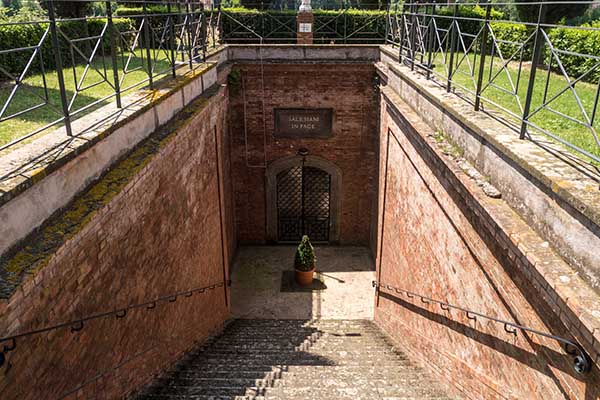
History of Rome catacombs
These Rome underground cemeteries go back about 1,800 years ago. At first the catacombs were used to bury relatives, but later - when Christianity became more important - the catacombs were considered a special place for Christians. It was a place where Christians gathered to pray. On the inside of most catacombs there are beautiful paintings and texts that show what people believed and what life used to be like. In Rome there are many, even more than 40 Rome catacombs . Each catacomb has its own story and history. Some catacombs originally functioned as family tombs, while others were later used by Christians as holy places.
Visit Catacombs in Rome
Only 6 catacombs in Rome are open to the public , always with a mandatory guided tour. Some Rome catacombs where travelers can go to learn more about the distant past are the Catacombs of Saint Callixtus , the Catacombs of Saint Sebastian , the Catacombs of Domitilla , the Catacombs of Priscilla and the Catacombs of Marcellinus and Peter . During this underground tour through the narrow tunnels and chambers you will see numerous drawings and symbols about the lives and beliefs of the people who were buried there.
Rome Catacomb Tours
Catacombs close to via appia, 1. catacombs of saint callixtus (san calisto).
- Address : Via Appia Antica, 110/126
- Tickets : from 15 euros, but can only be visited with a guided tour ( book your tour )
- Tip : Not sure which catacombs to visit for the first time? Then it is best to visit these catacombs of San-Calisto and combine this with the Via Appia .
One of the most famous and unique catacombs in Rome are these of Saint Callixtus (San Callisto) located on the Via Appia . This catacomb is named after Pope Calixtus I. It is a catacomb with thousands of graves, including those of various popes and martyrs from the past. In the tunnels and chambers you can read frescoes and inscriptions where you can learn more about Christianity and the spiritual life of the period. This catacomb is considered a sacred place where early Christians gathered to honor their faith. If you want to visit a catacomb in Rome for the first time, this is the best choice to start with.
2. Catacombs of Saint Sebastian
- Address : Via Appia Antica, 136
The Catacomb of Saint Sebastian (or Catacombe di San Sebastiano ) is named after the Christian martyr Saint Sebastian. It is one of the oldest catacombs in Rome with unique architectural features and is located on the Via Appia . A basilica has been built on top of the catacombs of Saint Sebastian. The Catacomb of Saint Sebastian used to be a sacred place for worship and prayer. This catacomb has a special significance because Saint Sebastian became an important symbol of courage and faith during the Roman period.
3. Catacombs of Domitilla
- Address : Via delle Sette Chiese, 282
In the Catacomb of Domitilla you will find numerous chambers and tunnels that once served as resting places for members of the Emperor's family and other prominent Romans. The Catacomb of Domitilla is known for its frescoes and sculptures in different styles. There is also an underground basilica that used to be used for liturgical celebrations. Many people used to gather in these Rome catacombs to pray, but also to celebrate their faith extensively.
Other catacombs in Rome
4. catacombs of priscilla.
- Address : Via Salaria, 430
The Catacomb of Priscilla is known worldwide for its beautiful frescoes, ranging from Biblical pieces to portraits of saints. This catacomb is named after a noblewoman named Priscilla. Priscilla may have played an important role in the Christian community of the time. In addition to burial chambers, this catacomb also contains a cubic space, also known as the 'Cappella dei Sacramenti'. The frescoes in the Catacomb of Priscilla offer more insight into how the faith was portrayed and celebrated in the past.
5. Catacombs of Marcellinus and Peter
- Address : Via Casilina
The Catacomb of Marcellinus and Peter, also known as Catacombe ad Duas Lauros, was specially designed and built in the name of Saints Marcellinus and Peter. This Catacomb of Marcellinus and Peter is popular for its well-preserved frescoes with Biblical inscriptions and Christian symbols.
6. Catacombs of St. Agnes
- Address : Via Nomentana, 349
The catacombs are named after Saint Agnes, a young Christian martyr who died in AD 304. She is often depicted with a lamb as a symbol of her innocence. Her tomb and the spaces around it in the Catacomb of St. Agnes are important pilgrimage sites for Christians. The catacombs consist of a complex network of underground passages and chambers carved into the soft tuff beneath Rome. They contained burial chambers (cubicula), niches in which bodies were placed, and sometimes frescoes and inscriptions commemorating the deceased.
Organized tours of underground Rome
You can choose to visit only one catacomb, but there are also several tours that visit several underground locations in Rome. A guide can share interesting stories, explain details and guide you through the tunnels and chambers. In this way you ensure an unforgettable, more profound and fascinating experience.
Video: Hidden History of the Catacombs of Rome
Where are the Catacombs in Rome?

Most visited attractions

Top 25 Things to do in Rome

Colosseum & Tickets

Sistine Chapel & Vatican Museums

St.Peter's Basilica & Tickets
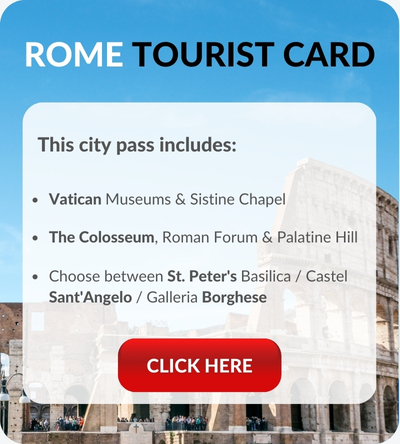
Best catacombs to visit in Rome

Sure, we all know that visiting Rome means you’ll likely hit the must-see attractions like the Colosseum , Pantheon , and Trevi Fountain . But if you’re looking for a truly unusual experience in Rome, why not check out the Roman catacombs?
Dating back to the first century, these man-made subterranean passageways were used as underground tombs in Ancient Rome. Unlike the Roman pagans who cremated their dead, the Jewish and Christian populations believed in religious burials. However, under the rule of the Roman Empire, bodies were not allowed to be buried within the city walls due to hygiene concerns.
Hence, Jewish and Christian catacombs were constructed to allow the dead to be secretly buried underground. Fearing persecution, many Christians also began praying belowground, and the catacombs became sacred sites of worship. When Christianity eventually became legalized, catacombs gradually fell out of popularity and were only rediscovered in the 1600s.
Today, there are about 40 Christian and six Jewish catacombs scattered around Rome, although not all of them are open to the public. Most of them require entry tickets, and wheelchair access is fairly limited. Women are advised to cover their shoulders, and pictures are also forbidden out of respect, so leave these sacred sites only in your memories.
Whether you’re a history buff or a traveler with a taste for the macabre, get ready to explore the secrets contained within the best catacombs in Rome .
1. Catacombs of Saint Callixtus

Located along the historic Appian Way , the catacombs of Saint Callixtus are the largest and most well-known of the Roman catacombs. These catacombs were featured in Ben-Hur , and were named after Pope Callixtus I, who served as a deacon and administrator of the catacombs.
Once the official underground cemetery of the Church of Rome, the catacombs of Saint Callixtus were the final resting place of close to half a million Christians. These catacombs stretch over more than 12 miles and five levels and are divided into multiple sections, including the Crypt of the Popes, the Crypt of Saint Cecilia, and the Crypt of the Sacraments.
If you get squeamish easily, there’s no need to worry about encountering any human remains here—all bodies within the tour route have since been respectfully relocated.
It’s easy to get lost and confused in this maze-like complex, so we recommend joining a guided tour to learn more about the famous popes and martyrs laid here to rest. As the catacombs are a distance away from the city center, you can also consider joining this tour that includes transportation from Piazza Venezia .
2. Catacombs of Saint Domitilla

The catacombs of Saint Domitilla still hold human remains, but that’s not what they’re known for. Instead, most people flock to the catacombs of Domitilla to admire the intricate frescoes depicting biblical figures and Ancient Roman history. These thousand-year-old frescoes are still undergoing restoration, but you can spot iconic images like Jesus with the apostles.
This is also where you’ll find the fourth-century Basilica of Nereus and Achilleus. The catacombs of Saint Domitilla’s underground basilica are 1 out of only 2 Roman churches dedicated to the two saints, who were martyred for refusing to carry out military orders to kill Christians.
Don’t be intimidated by the size of these catacombs—large portions haven’t been completely excavated, so you won’t need to dedicate too much time here. In fact, this small-group express tour promises to take you to the catacombs and back to downtown Rome in less than two hours. Or if you’d like to check out other historic sights nearby like the Basilica of San Martino ai Monti , this multi-stop walking tour will take you along the treasures of the Appian Way.
While photographs aren’t allowed, the catacombs of Saint Domitilla have a gift shop, so you can pick up souvenirs to commemorate the experience.
3. Catacombs of San Sebastiano

The catacombs of San Sebastiano have had numerous identities, including a former pozzolan mine, a pagan cemetery, and finally, a catacomb used by Christians. The underground graveyard was said to have contained the remains of the Apostles Peter and Paul, and also housed the remains of Saint Sebastian, which are now kept in the basilica above the catacombs.
Unfortunately, these small and accessible catacombs are one of the least preserved. Out of the compound’s original four floors, one has been almost completely destroyed. However, you can still find some stunning relics like the paintings of Jonah’s cubicle and Bernini’s bust of Saint Sebastian. As you embark on your tour of the catacombs , look out for ancient graffiti by devotees scrawled along the plastered walls.
4. Catacombs of Priscilla

Also known as the Queen of the Catacombs, the catacombs of Priscilla are one of the oldest underground graveyards in Rome , used for Christian burials. Pope Marcellinus and Pope Marcellus I were buried here, and the remains of Saint Philomena have also been found within these catacombs.
Explore the tunnels after dark with this evening tour , where you’ll get to appreciate some of the oldest known biblical paintings without the crowds. Most notably, the catacombs of Priscilla contain what’s believed to be the first rendering of Mary, created in the third century. You can also find elaborate frescoes covering the Greek Chapel, which depict scenes from the Old and New Testament.
5. Vatican Necropolis

While the Vatican Necropolis lies outside Rome , it’s still worth a visit, especially if you’re already in Vatican City . Located below St. Peter’s Basilica , the necropolis was once an open air cemetery for early Christians, including Saint Peter himself.
Eventually, Emperor Constantine built a basilica over Saint Peter’s grave, and the necropolis remained undiscovered until the 20th century. During the pontificate of Pope Pius XII, excavation work began in an attempt to locate the grave of Saint Peter. Various mausoleums were gradually discovered, and eventually “Field P” where the Apostle had been buried.
To protect and conserve the sanctity of the necropolis, only a limited number of visitors are allowed at a time, especially as archaeological excavations are still ongoing. You’ll need to join the official Scavi Tour to visit the ancient cemetery and pay your respects to Saint Peter. Bonus: The tour will also allow you to skip the line at St. Peter’s Basilica.
6. Crypt of Capuchins

Perhaps one of the most famously macabre sights in Rome , the Capuchin Crypt technically isn’t a catacomb, but an ossuary. Still, most catacomb tours like this small-group tour include a trip to the legendary “Bone Chapel.”
Venture underground beneath the church of Santa Maria della Concezione dei Cappuccini to explore these six chapels adorned with the skeletal remains of 3,700 Capuchin friars, who were buried here from the 1500s to the 1800s. Various crypts are dedicated to selected body parts like skulls, pelvises, and leg bones.
While the crypt is probably unsuitable for young children or the faint of heart, if you’re able to get over your squeamishness, we highly recommend paying this iconic site a visit. After all, it exists not for morbid reasons, but as a poetic reminder of the constant cycle of life and death: “What you are now we used to be; what we are now you will be…”
If you need a pick-me-up after your tour, we suggest heading to the nearby Trecaffè Due Macelli for a cappuccino—the espresso-based drink was named after the hooded robes worn by the Capuchin monks.
Recommended tours and activities


Rome’s Catacombs: Exploring The Darker Side of The Eternal City
Rome’s catacombs are among the city’s most curious sights – a reminder of the darker side of the Eternal City. Here’s what you need to know.
Rome is a city of many faces – one steeped in art, history, and culture. But what about the dark side of the eternal city?
Not to dig up the past (OK, that’s exactly what I’m doing) but let’s dive into the history of Rome’s catacombs – one of the darker sides of the city.
Rome sits atop a vast network of these burial tunnels and exploring them should be on your Rome itinerary – no matter how short it is.
So, here’s what to expect when you visit the catacombs of Rome.
What Are Catacombs and Why Does Rome Have So Many of Them?
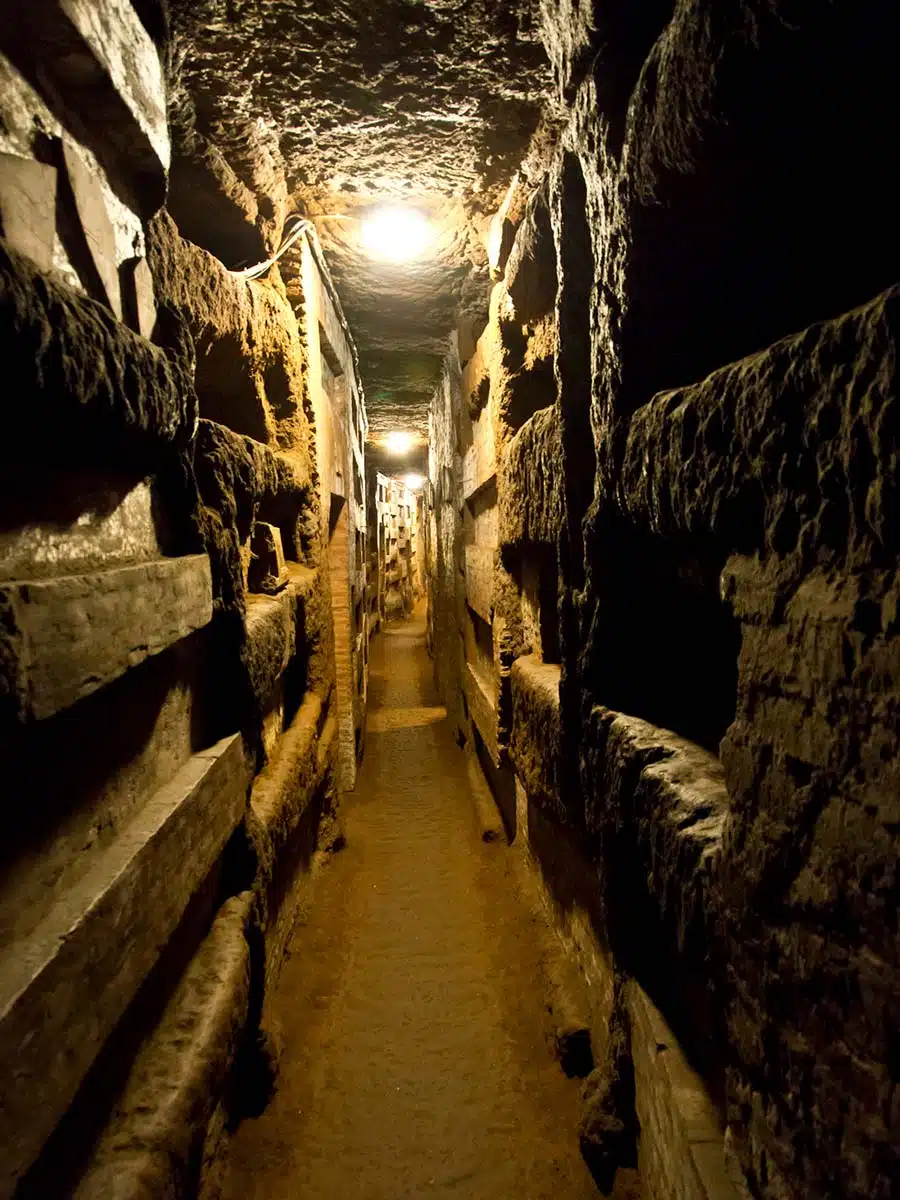
Why does Rome have so many catacombs? What are catacombs?
Okay, hold onto your explorer’s hats, folks. Class is in session.
What are Catacombs?
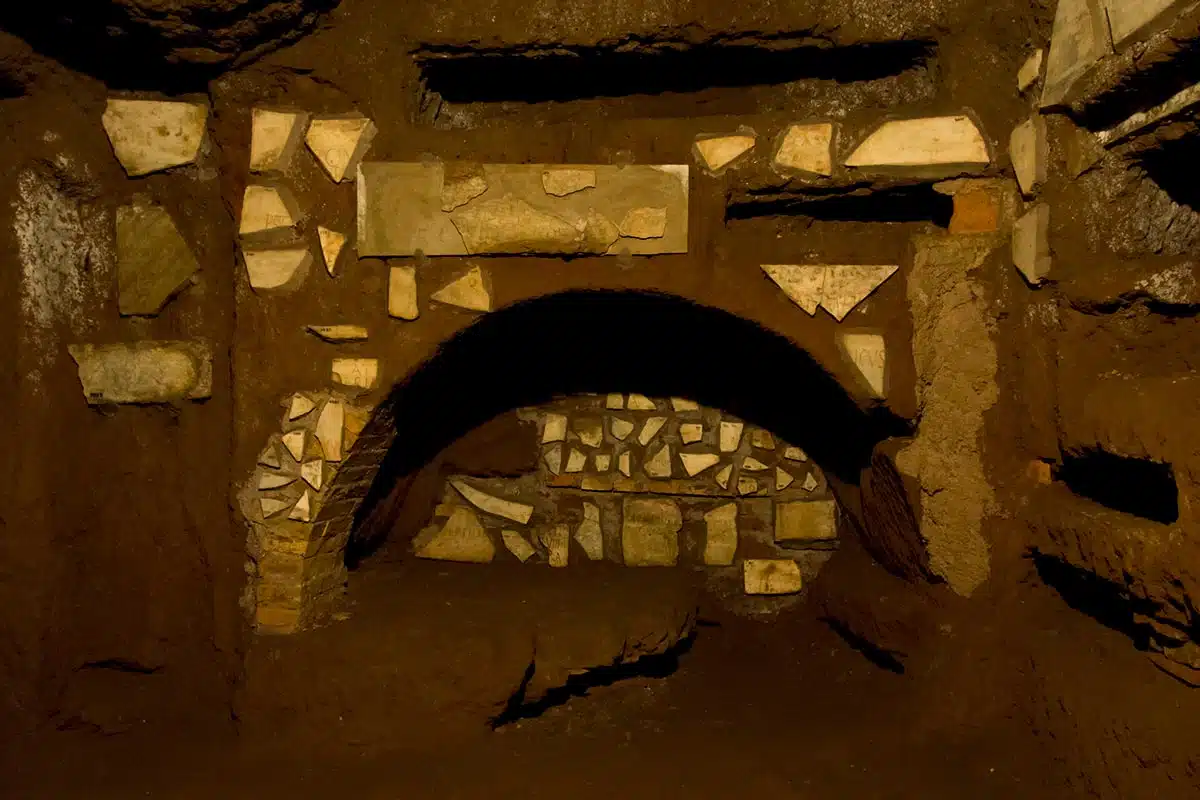
First up, what even is a catacomb? In short, a catacomb is a collection of underground passageways or tunnels. These intersect at points and often stretch for quite a few kilometres.
That doesn’t sound creepy at all, right? Well, here’s the catch. Catacombs are not just empty passageways. No, my intrepid adventurers, they usually come lined with thousands of human remains.
Yes, catacombs are burial tunnels. In fact, these labyrinths – which are as spooky as you’d expect them to be – served quite the purpose back in the day.

A Brief History of Rome’s Catacombs
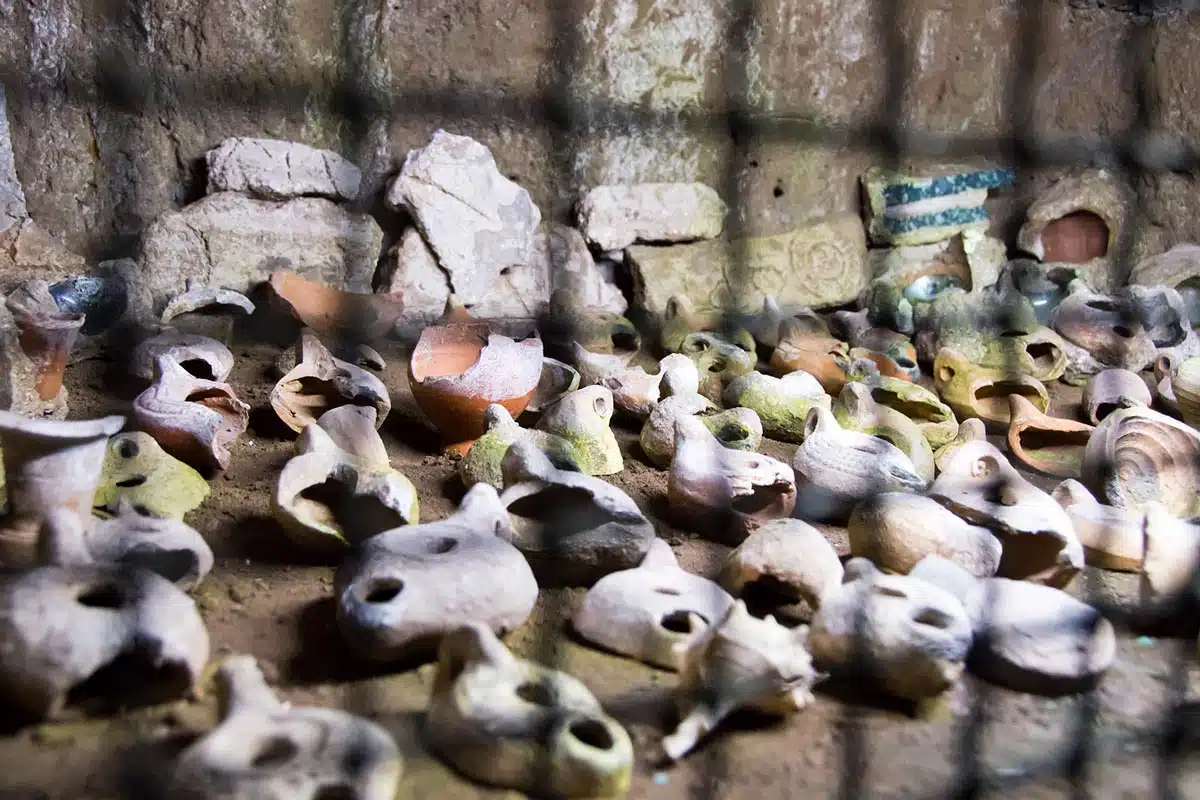
According to some archaeologists (it’s still a bit of a guesstimation), there are about 60 catacombs underneath Rome. You see, sometime between the first and second centuries, Roman law prohibited the burial of the deceased within the city.
The Jewish and Christian communities faced significant persecution in Rome – particularly between the 1st century AD and 4th century AD. Living in communities distinct from the mainstream pagan society, they also buried their dead separately too.
Initially, only Jewish citizens used the tunnels, and then about a century later, Christians followed suit.
The catacombs offered a safe place to bury their dead without fear of displaying religious symbols upon tombs. Thousands of people found their eternal resting place within these mazes.
Then in 313, the persecution of Christians stopped with the signing of the Edict of Milan . This edict allowed for the building of churches and the designation of burial land. But, the use of catacombs persisted until the 5th century.
The barbarian invasion of Italy in the 8th century resulted in heavy looting and desecration of the catacombs. Subsequently, the use of catacombs stopped and most left abandoned with important relics moved to churches inside the city.
Now that you know the ins and outs of Rome’s catacombs let’s dive into the best ones you can visit.
Catacombs in Rome You Should Visit
Catacombs of san callisto.
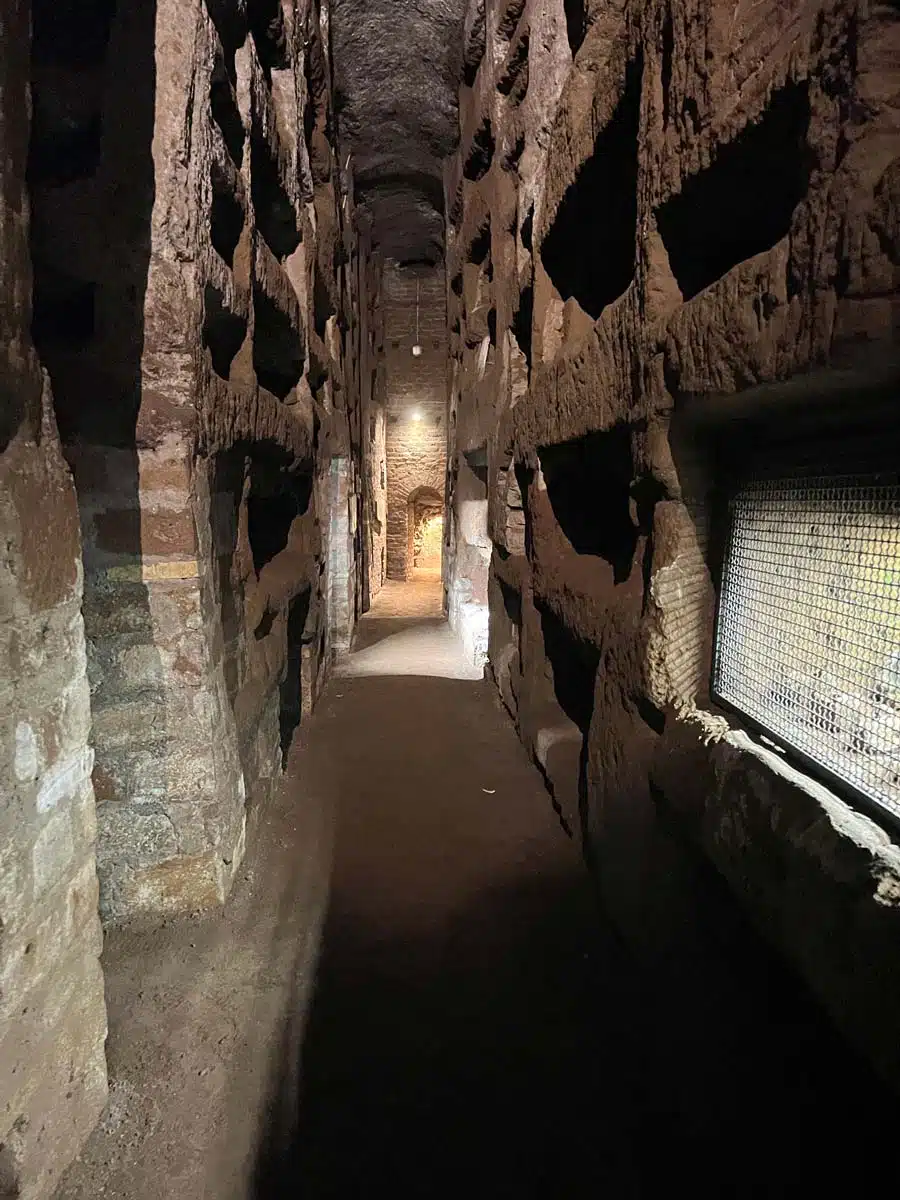
It would be quite a scandal if I started this list with anything but the catacombs of Saint Callisto, also known as Saint Callixtus. Why, you might be asking? Well, it’s considered the most impressive and beautiful (I use the term loosely) in Rome.
Considered the first catacombs used by Christians, they stretch for an astounding 20 kilometres. Within, you’ll find the burial sites of 16 Popes alongside many Christian martyrs.
Two famous sites in the catacombs include the ‘crypt of the Popes’, which houses the sanctified remains of five deceased pontiffs. The other is the crypt of Santa Cecilia.
Top Tip: Book this guid e d tour of the catacombs of St Callixtus, or this tour that includes the Appian Way.
Catacombs of Santa Priscilla
Originally called ‘Regina catacumbarum’, which translates to ‘the queen of catacombs’, this is where roughly 40 thousand burials took place. Amongst these, six Popes and hundreds of martyrs fill its niches.
Inside there are numerous important sites you can visit. The Cubicle of the Velata depicts redemption scenes from the Old Testament. The Greek Chapel showcases frescoes of “franctio panis”, or the sacrament of breaking bread. And what some deem the most ancient depiction of the Virgin Mary and the baby Jesus.
Explore the catacombs of Santa Priscilla, which are open from Tuesday to Sunday. You can choose to go between 9 am and 12 pm or 2 pm and 5 pm.
Catacombs of Domitilla
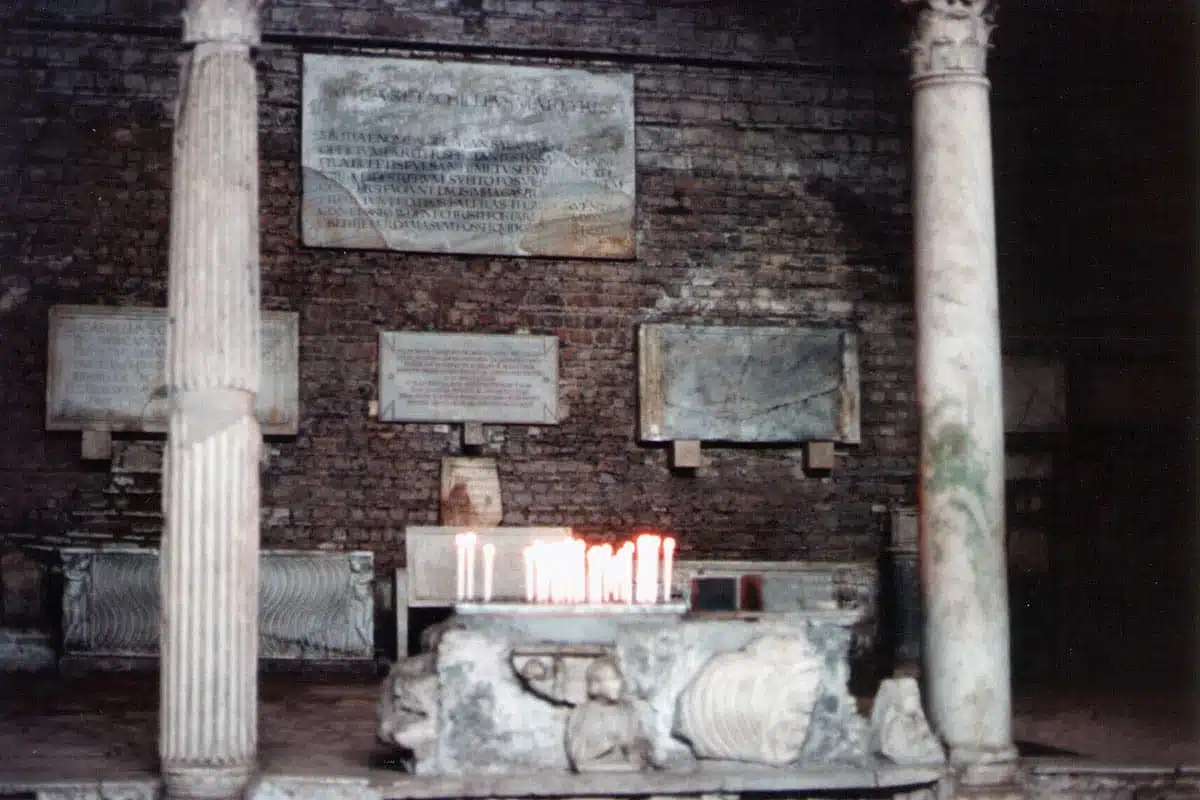
While many other Rome catacombs brim with the history of popes and martyrs, the catacombs of Domitilla tell a different story. Commissioned by the Domitilla family, they span nearly 15 kilometres.
These catacombs are the oldest of Rome’s underground burial tunnels, which is why they have seen significant restorations. Inside, the stunning frescoes offer depictions of Christ, while many others display more Christian art.
Fun fact time. Some of the niches carved into the passageways still contain bones. But, large parts of the catacombs are still closed to the public.
Top Tip: Book this small group Roman Catacombs tour to delve into the history of Domitilla.
Catacombs of Sant’ Agnese
Catacombs are fascinating, but they are also (unsurprisingly) sombre. The catacombs of Sant’ Agnese are exceptionally so. Agnes, a young girl of 12, died due to Christian persecution.
While these Roman catacombs do not contain much in the way of artistic frescoes or paintings, it is worth a visit. Inside the three-tier catacombs, you can see many epigraphical testimonies etched into its walls.
These tell tales of countless visitors to the tomb who came to view one of the first burial catacombs dedicated to a woman. The legend of Saint Agnese is why some call it one of the most famous catacombs in Rome.
Top Tip: You can only visit the catacombs of Sant’ Agnese by booking a guided tour through the official website. Visit their website to book your tickets.
Catacombs of Praetextatus
From an artistic perspective, the catacombs of Praetextatus are the most renowned tunnel network in Rome. It’s also one of the few in the city where depictions of not just Christian symbols mark the walls.
The interior features a few distinct areas as well. First is the Cubicle of Coronatio, which depicts the crowning of Jesus with thorns and the resurrection of Lazarus. Beyond that, it holds the sarcophagus of Emperor Balbino, as well as illustrations of the myth of Achilles.
Top Tip: Choose this guided half-day tour of the catacombs of Rome, which includes significant basilicas, to explore the eternal city’s underground.
Catacombs of San Sebastiano
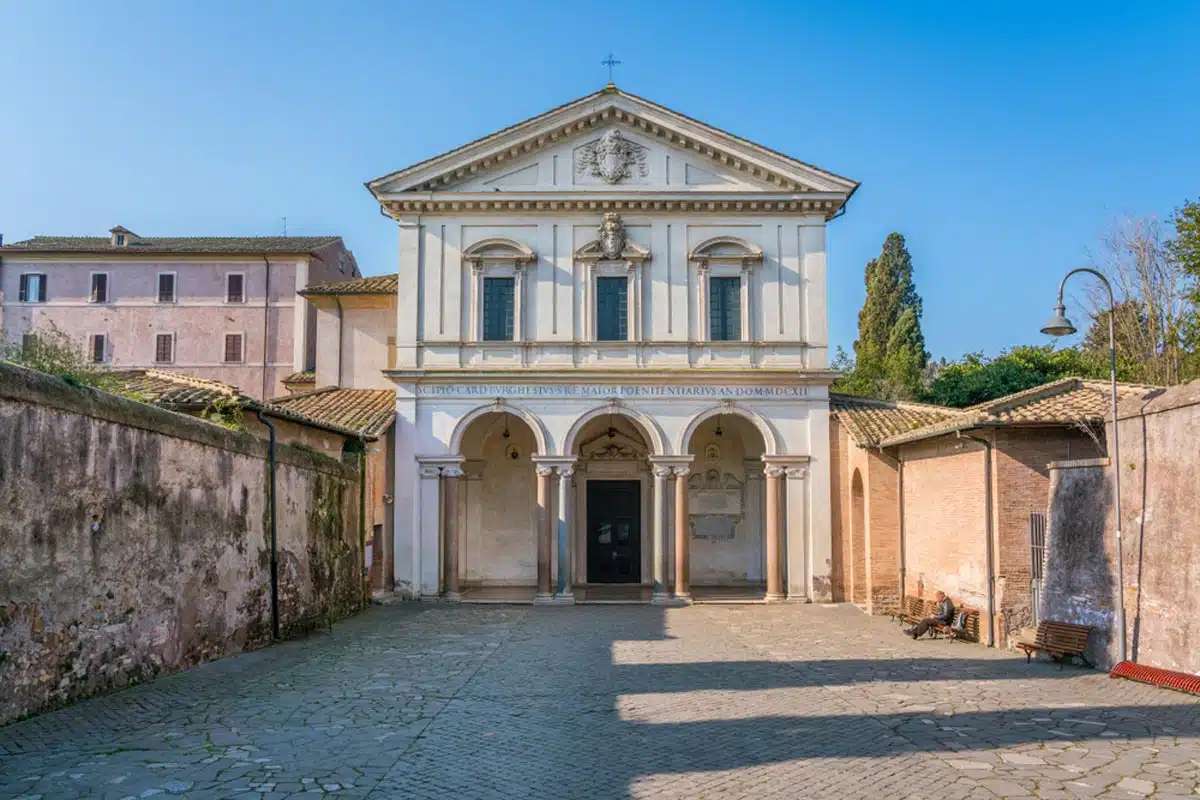
Dedicated to Saint Sebastian, these are the first burial tunnels called catacombs. Persecuted by the Roman Emperor Diocletian for converting thousands of soldiers to Christianity, his remains reside here.
Extending nearly 12 kilometres, you’ll see many distinct decorations distinguishing each corpse buried here. Inside sits the Baroque Basilica of Saint Sebastian, one of Rome’s seven holy pilgrimage sites.
The catacombs also contain a marble statue of St Sebastian and several sacred relics. These include the arrows that pierced his body and the column on which he died.
Top Tip: To view these burial tunnels, book this 3-hour guided tour of the best catacombs in Rome.
Practical Tips for Planning Your Visit to Rome’s Catacombs
Visiting the catacombs independently.
If you’re planning to visit any of the catacombs in Rome independently, there are a few things to remember. Most importantly, you can only enter them as part of a guided tour.
While there are numerous tour operators, each catacomb has its own tour system.
These tours led by monks or priests often involve a sermon. You must also dress appropriately, as the catacombs are holy sites.
Independently, you’ll also need to know each catacomb’s opening and closing times.
Visiting Rome’s Catacombs On a Tour
On the other hand, adding a tour, or tours of Rome catacombs through a tour operator, is a more encompassing experience. These often include more than one catacomb and other areas of interest.
Hosted tours also are led by well-trained guides whose knowledge enhances your overall tour quality. These are, however, often more costly but worth it if pressed for time.
Book Your Catacombs Tour Now
Catacombs in Rome: Map
Now You’ve Explored the Roman Catacombs – Read These
- Unmissable Things to do in Rome
- 3 Day Rome Itinerary
- The Best Places to Stay in Rome
- Cool Day Trips from Rome
- Rome in a Day
- The Rome Rooftop Bars with the Best View
Love This? Save and Share on Pinterest
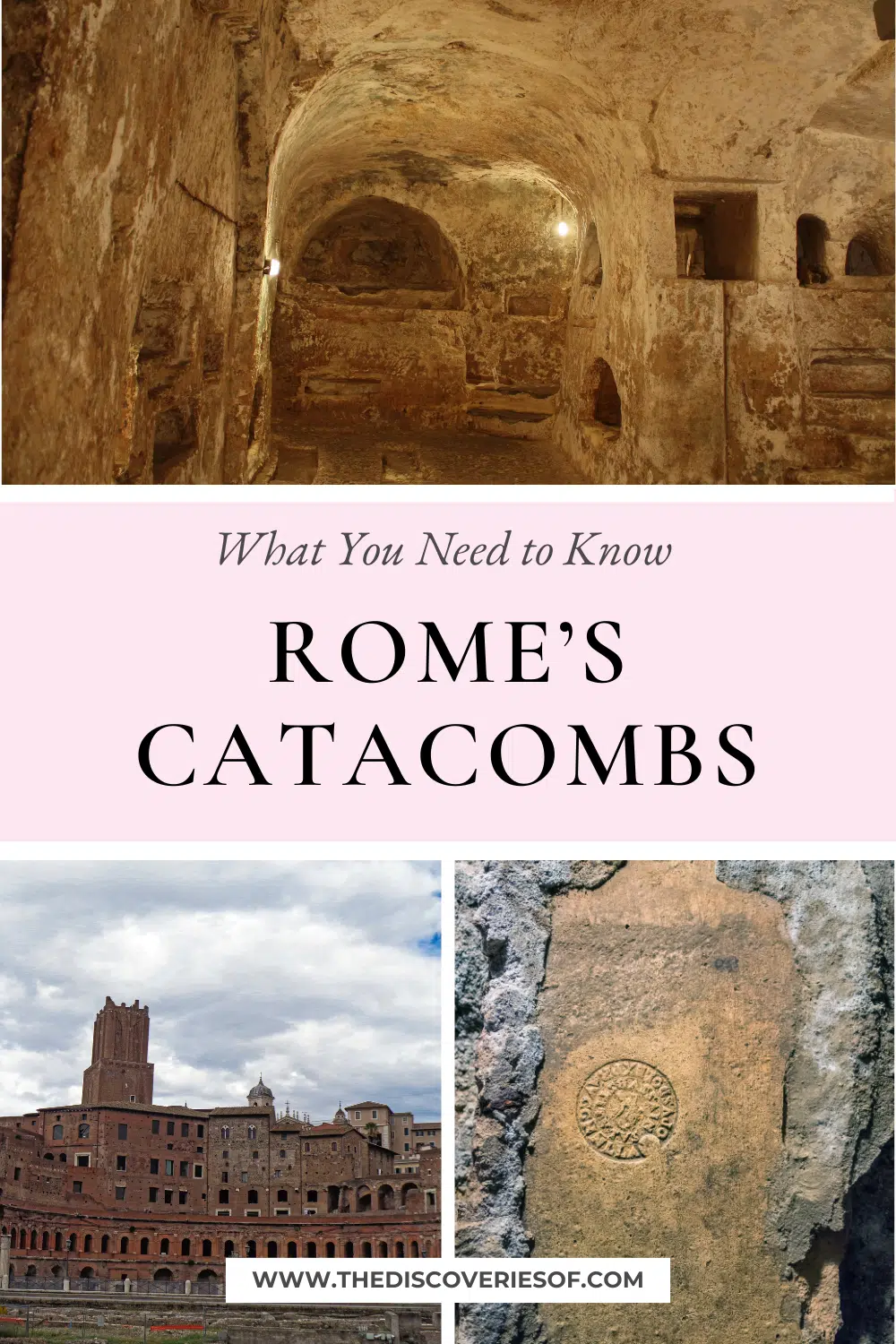
I’m Julianna Barnaby - a professional travel writer and geek extraordinaire. I started The Discoveries Of to help you to discover the best of new destinations from around the world.
Discovering new places is a thrill - whether it’s close to home, a new country or continent, I write to help you explore more and explore differently.
Related Posts
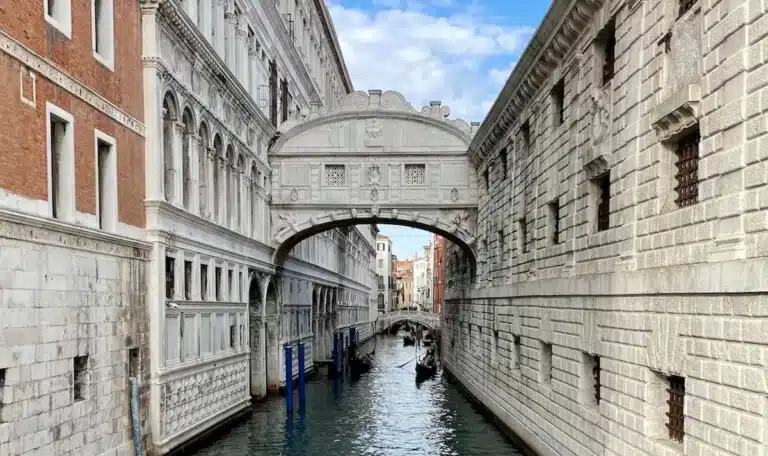
Bridge of Sighs, Venice: A Guide
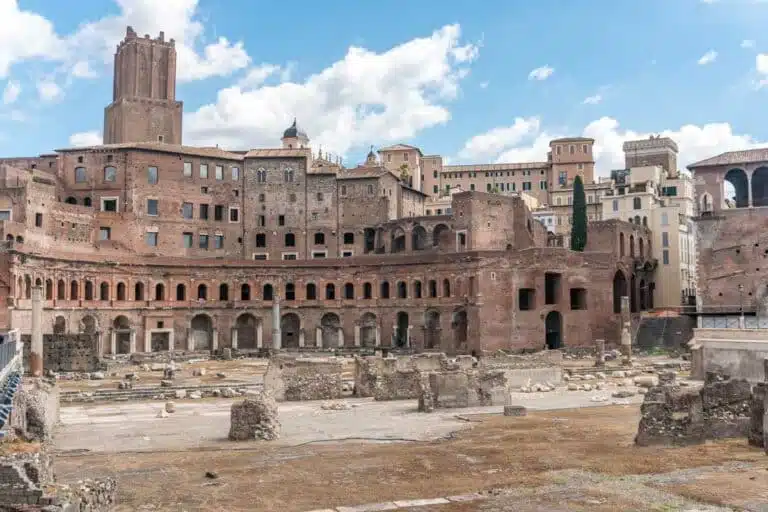
15 Famous Landmarks in Rome You Have to See

The Best Hotels in Tuscany: Top Picks for Your Tuscan Escape
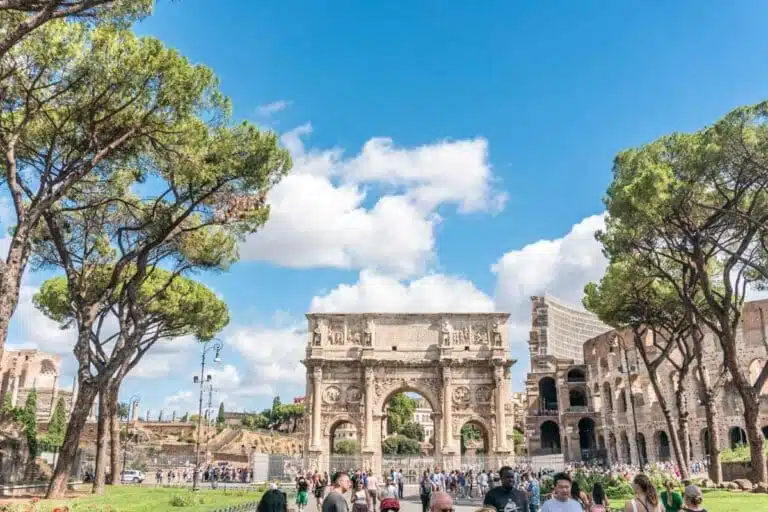
29 Best Things to Do in Rome

Follow me on Instagram for travel inspiration, tips, and guides.

- Exhibitions
- Cinema and TV
- Ancient art
- '800 e '900
- Contemporary art
- AB Arte Base
- All reviews
- Mostre in corso
- Mostre concluse
- Foreign countries
- Exhibition finder

Catacombs of Rome, which ones to see: guide to the 10 most interesting ones
The catacombs of Rome constitute a vast system of underground cemeteries located along tunnels that extend beneath the city. These catacombs were primarily used as burial sites during the first centuries of Christianity. The Roman catacombs originated during the period of the Roman Empire, beginning in the second century. Many of the earliest Christians were buried in these catacombs because of their religious beliefs (in fact, Christianity believed that the doctrine of the resurrection of the flesh was incompatible with cremation, which was practiced by pagans instead), consequently long cemeteries were carved out underground to give Christians a proper burial. Catacombs consist of a network of corridors, chambers and loculi (burial niches) carved into the rock. These tunnels can extend for miles underground, and some catacombs also contain rooms used for worship meetings and religious celebrations. The catacombs are an important historical landmark for the study of early Christianity, as they contain frescoes, graffiti and inscriptions that testify to the faith and practices of those times. Today, many of Rome’s catacombs are open to visitors interested in discovering their history and importance , while others are accessible only to experts. Indeed, scholars and archaeologists continue to study the catacombs to better understand the lives and beliefs of early Christians, as well as to explore the history of ancient Rome. Preserving the catacombs, however, is a challenging task because of the challenges related to moisture, rock degradation, and the influx of visitors. However, efforts have been made to preserve these important historical records for future generations. Many catacombs can be visited: here is a guide to Rome’s catacombs for those who would like to discover this peculiar aspect of the city’s history.
1. Catacomb of San Callisto
It is the catacomb par excellence, since it was the official cemetery of the Church of Rome in the 3rd century, and given its extent one can also speak of it in the plural (“the catacombs” of St. Callistus). The Catacomb of St. Callistus is in fact one of the most important and largest catacombs in Rome. It is named after Pope Callistus I, who ruled the Church in the third century and was one of the first to recognize the importance of the catacombs as burial places for Christians. This catacomb is located along the Via Appia Antica, one of the main access roads to the city of Rome. The Catacomb of St. Callistus is spread over several underground levels reaching a total length of about twenty kilometers, and it is estimated that about half a million Christians were buried here. This catacomb is divided into several areas, each of which contains several tunnels and burial niches. It is also notable for the presence of numerous tombs of martyrs, popes and saints (in fact, the burials of as many as sixteen popes are counted). These catacombs were an important burial site for early Christians, especially during periods when the practice of Christianity was subject to persecution. The frescoes, graffiti and inscriptions inside provide valuable information about the life and faith of the early Christians. Within the Catacomb of St. Callistus are a number of crypts that have traditionally been associated with popes and bishops. For example, the Crypt of the Popes is an area of this catacomb where nine popes are buried. The Catacomb of St. Callistus is open to the public and can be visited to discover its history and importance.

2. Catacomb of Domitilla
The Catacomb of Domitilla is another of the important catacombs in Rome. It is named after a Domitilla who belonged to the family of the Flavians, who may have owned the land on which the catacombs were built. This catacomb is one of the largest and best preserved in Rome, and is located along the Via Ardeatina. Excavated in the tufa, it extends over several underground levels and covers a large area that in several parts bears interesting wall paintings, one of the main attractions of the catacomb: scenes from the life of Jesus, biblical episodes but also pagan figures (e.g. depictions of Orpheus). Especially famous is the wall painting depicting the Good Shepherd , one of the earliest known works of Christianity. A curiosity: in 1965 the “Covenant of the Catacombs” was signed here, an agreement between a number of cardinals, mainly Brazilians and Latin Americans, a few days before the end of the Second Vatican Council: with the covenant they pledged to live in poverty according to the Gospel, renouncing the privileges arising from their office.
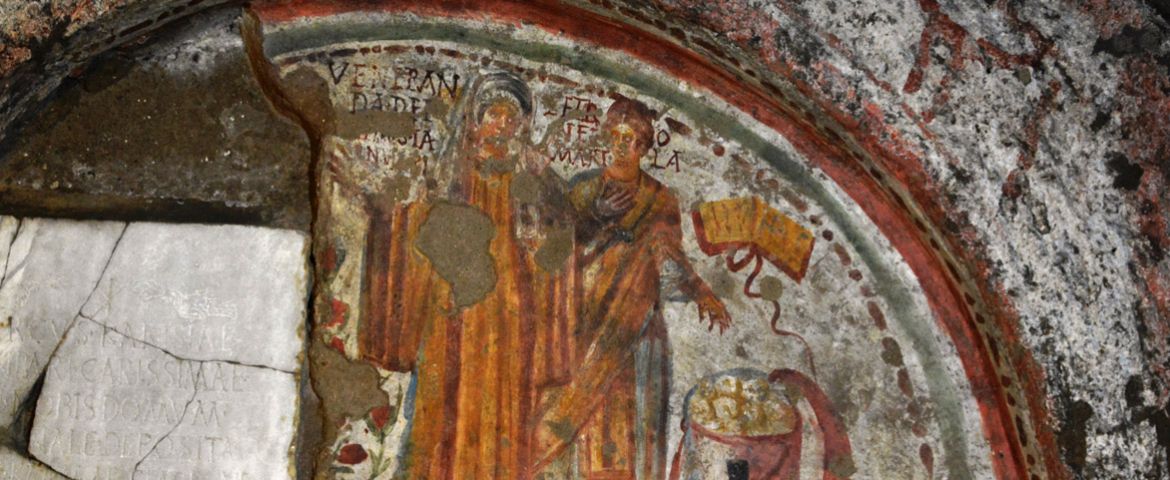
3. Catacomb of St. Pancratius
Named after St. Pancratius, a young Christian martyr who lived between the 3rd and 4th centuries. Located along the Via Vitellia, a short distance from the Aurelia Antica (where St. Pancratius was martyred), the Catacomb of St. Pancratius has an interesting and significant history especially as it is linked to the cult of the saint, for whom, between the 4th and 5th centuries, Pope Symmachus also had a basilica erected right above the catacomb: as a result, there are two entrances inside the basilica that lead to the underground burials. The catacomb consists of a series of corridors, chambers and loculi carved into the rock: however, it is one of the worst preserved.
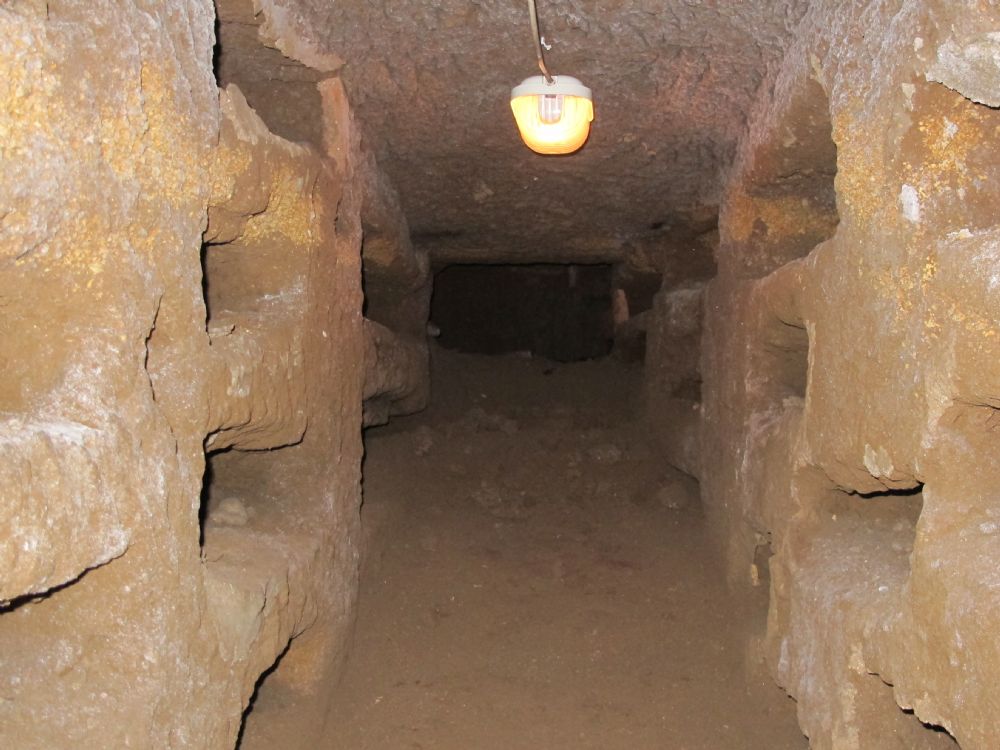
4. Catacomb of St. Sebastian
Among the best-known and most visited catacombs in Rome, the Catacomb of St. Sebastian , along the Via Appia Antica, was used as a burial site within an abandoned pozzolan quarry in the late 2nd century, on which the imposing basilica of St. Sebastian Outside the Walls (known as ad catacumbas precisely because of the presence of the vast underground cemetery) was later built by Emperor Constantine in the 4th century. Tradition states that St. Sebastian, a Roman soldier who converted to Christianity and was later martyred, was buried in this catacomb in the 3rd century. His devotion and martyrdom made the catacomb an important place of veneration for the faithful (the remains were later moved to St. Peter’s in the 9th century). Ancient sources also attest that two other martyrs, Quirinus and Eutychius, were buried here. Here, too, parts of the catacomb are decorated with frescoes, graffiti and inscriptions depicting biblical scenes, Christian symbols and images of faith. The crypt of St. Sebastian, on the other hand, preserves a 17th-century bust of the saint.

5. Catacomb of Priscilla
The Catacomb of Priscilla is one of the most famous catacombs in Rome and in ancient times was also known as the “Queen of the Catacombs” because of the importance of the personalities who were buried here. It is named after the Christian matron Priscilla, who is traditionally believed to have donated the land in which the cemetery was excavated. This catacomb is located along the Via Salaria, one of the ancient routes into the city of Rome. A distinguishing feature of the Catacomb of Priscilla is the presence of “cubicles,” larger burial chambers decorated with frescoes and drawings: for example, the cubicle of the Veiled, so called because of the presence of a fresco depicting a veiled woman shown praying. Next we visit the Greek Chapel, with several scenes depicting episodes from the Old and New Testaments. The Catacomb of Priscilla is also the burial place of as many as seven popes: Marcellinus, Marcellinus I, Sylvester I, Liberius, Siricius, Celestine I, and Vigilius.
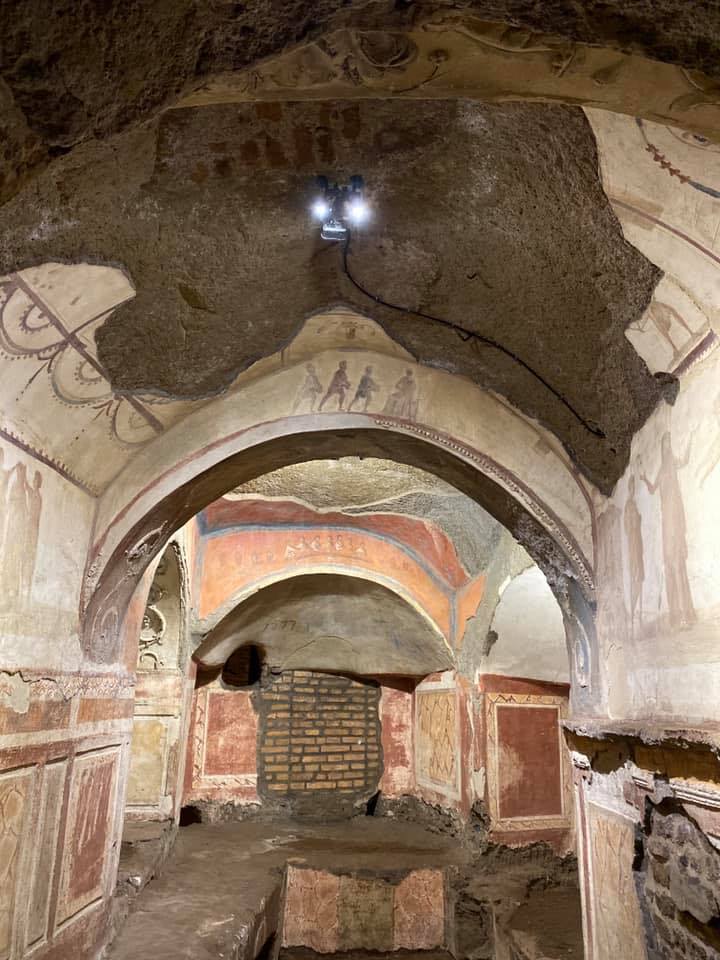
6. Catacomb of St. Agnes
Dedicated to St. Agnes, a young Christian martyr from the 3rd-4th centuries, the only martyr reported by ancient documents to be buried in this catacomb. The Catacomb of St. Ag nes is one of the oldest burial sites and consists of a network of corridors, chambers and burial niches dug into the tuffaceous rock and arranged on three levels, in turn divided into four areas, which were developed at different times. The peculiarity of the Catacomb of St. Agnes is that it is very poor in paintings, but is instead rich in epigraphs and inscriptions. Also on the site of St. Agnes’ burial, a church dedicated to her was built in the 5th century, then rebuilt in the 7th century, when it took its present form as a partially buried basilica. This site thus represents an important place of veneration and history of early Christianity in Rome: its association with St. Agnes and its epigraphic evidence offer a unique opportunity to learn more about the life and faith of early Christians and to explore the city’s ancient heritage.
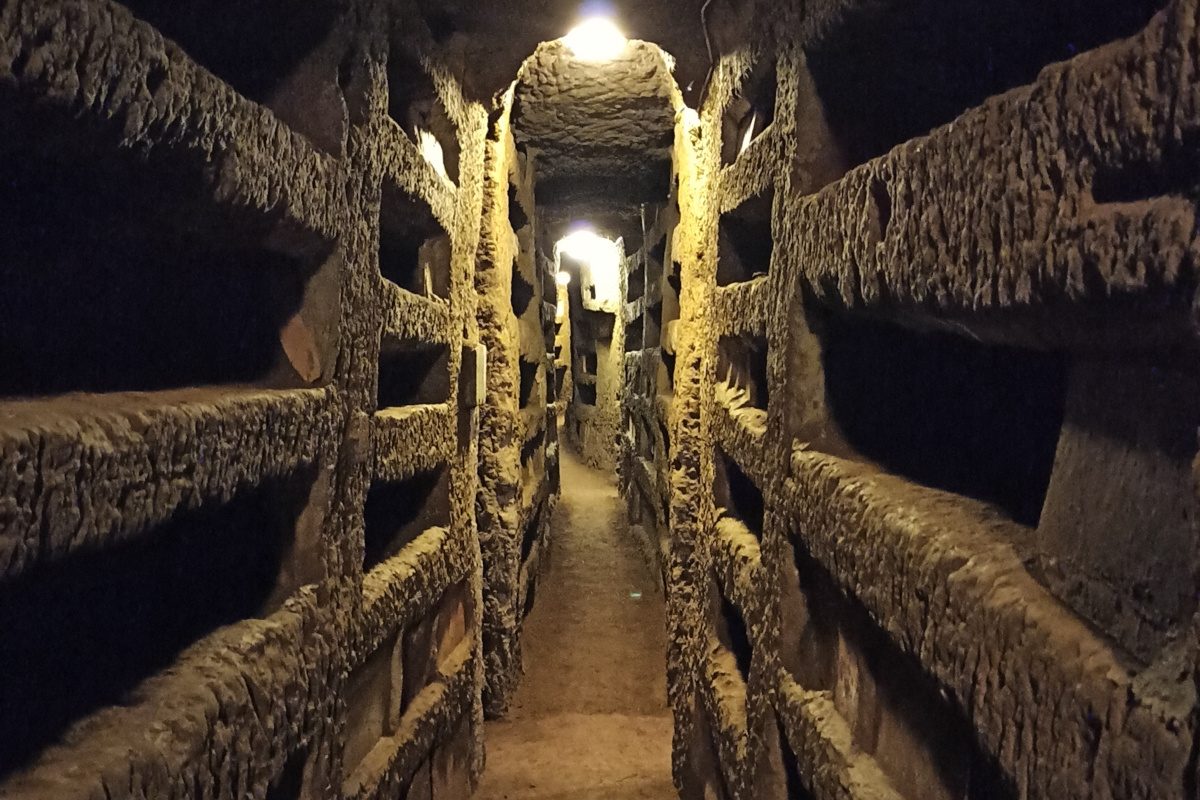
7. Catacomb of Saints Marcellinus and Peter
Located along the Via Casilina, the Catacomb of Saints Marcellinus and Peter is one of the oldest in Rome, since it was a burial site from the early second century. Access is from the Church of Saints Marcellinus and Peter ad Duas Lauros and is dedicated to Saints Marcellinus and Peter, two fourth-century Christian martyrs who were killed during Diocletian’s persecutions. The catacomb continued to be used for centuries. It consists of a series of underground tunnels covering an area of about 18 thousand square meters (it is estimated that more than 15 thousand burials were housed there). Many rooms are decorated with frescoes: it was in fact the burial place of particularly wealthy Christians.
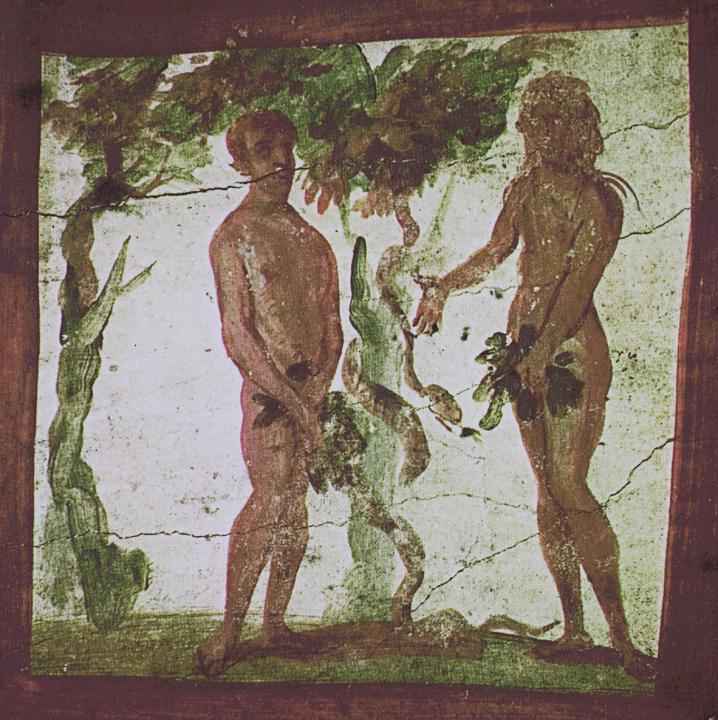
8. Catacomb of Pretestato
The Catacomb of Pretestato is located in the Appio-Latino district and is situated on the route of the Appia Antica. Used as a cemetery since the 3rd century, it is known because it is rich in works of art, including pagan ones, since Christian burials were made in a catacomb where prominent personalities were already buried earlier (the well-known 3rd-century Sarcophagus of Emperor Balbinus was discovered here). Little-known as it is, in fact, the catacomb of Pretestato is one of the most artistically valuable (see the scene with the Coronation of Christ, from the 3rd century, that decorates one of the cubicles: it is believed to be one of the oldest examples of Passion episodes). It also has a special feature: it is the only Roman catacomb where there was a keeper’s house. It can be visited upon request.
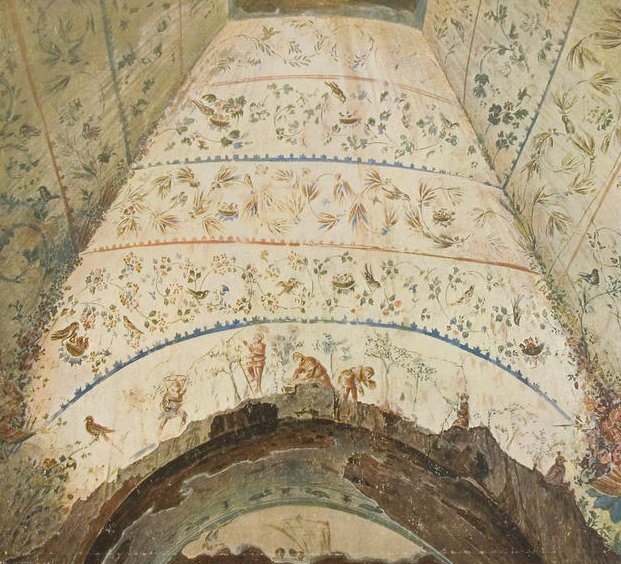
9. Catacomb of St. Thecla
Along the Via Ostiense stands the catacomb of St. Thecla, dedicated to the saint of the same name about whom, however, we have no reliable information. It dates from the 3rd century and features a series of corridors and chambers (twenty-two in all, arranged along three ambulatories) that are arranged around the small 4th-century underground basilica where, according to tradition, St. Thecla was buried. It stands out because the walls of the cubicles are almost entirely covered with frescoes, although they are in a poor state of preservation. In 2009 an image of St. Paul was discovered here that is believed to be the oldest known depiction of the saint (it dates back to the fourth century), included in a cycle of roundels with the faces of the apostles (Peter, Andrew and John also appear, and the image of St. Thecla is believed to be the oldest known to us for them as well). This catacomb is also open for visits by request only.
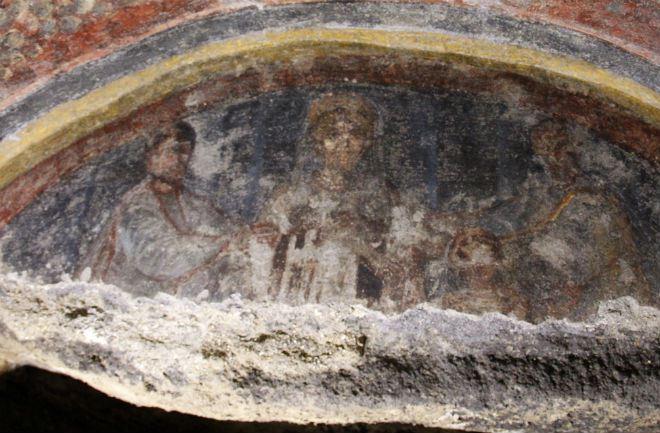
10. Catacomb of Generosa
Another catacomb that can be visited only by request, the Catacomb of Generosa is named after the woman who, according to tradition, donated the land under which the underground cemetery was dug. It is located in the Portuense district, not far from the Tiber. It was carved out of the tunnels of an abandoned pozzolan quarry, so between the 3rd and 4th centuries the quarry was reused as a burial place (the martyred saints Simplicio, Faustino and Beatrice, among others, were buried there). Next to the catacomb stood a basilica, built by Pope Damasus, the remains of which were discovered in the 1980s.
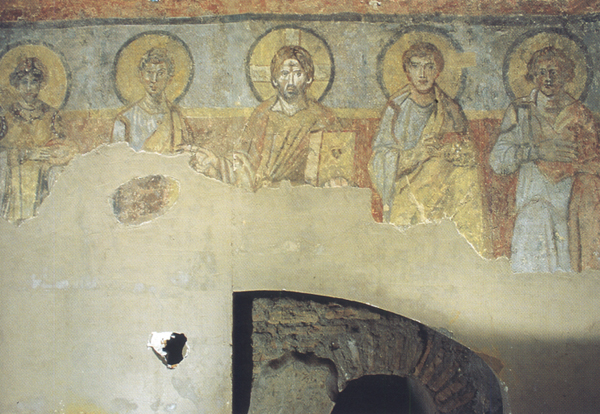
Warning: the translation into English of the original Italian article was created using automatic tools. We undertake to review all articles, but we do not guarantee the total absence of inaccuracies in the translation due to the program. You can find the original by clicking on the ITA button. If you find any mistake, please contact us .

Most read of the month


11 BEST Catacombs of Rome Tours (selected by an Italian)
By: Author Stefania Guglielmi
Posted on Last updated: October 9, 2023
Categories Europe , Italy
Find the very best Catacombs of Rome tours to make sure you have a memorable adventure exploring the eerie, underground side of the city. I’ve made a super comprehensive list for you!
Rome is one of the most important – and visited – cities in the world. Center of the Roman Empire and later capital of the Kingdom and Republic of Italy, Rome has an incredibly rich history that’s evident in pretty much every corner.
From the astounding Colosseum to the Forum and Palatine Hill, the ruins of its past keep the stories alive. And if you add mouthwatering Italian cuisine, picturesque streets, and breathtaking architecture to the mix, you’ve got yourself an unparalleled city destination .
But did you know there’s more to Rome’s ancient settlements…and many of them are underground? Rome in fact hides a mysterious world beneath its streets: the catacombs .

These centuries-old tunnels are a time capsule, packed with art, relics, and mind-blowing constructions from the first five centuries AD. Home to enthralling tales as well as invaluable antiques, the catacombs are a lesser-known and highly recommended attraction that’s a great addition to your 3-day itinerary in Rome .
In this article, I’ve rounded up the 11 best catacombs of Rome tours so that whichever option you decide to join, you know it will be good value. From unveiling the mysteries beneath the Appian Way to soaking in the ambiance of Capuchin Crypt, the choices are many and varied. Check them out!
👉 Why rely on my guide for Catacombs of Rome tours? As an Italian who’s devoted years to exploring and writing about Italy’s rich history and hidden gems, I’ve curated this list with an eye for the exceptional. My recommendations focus on tours that delve deep into the mysterious world beneath Rome, offering both quality and captivating storytelling.
I generally use Viator and Get Your Guide to book tours around the world. I especially recommend them for their great cancellation policy, which allows you to cancel most activities up to 24 hours in advance and get a full refund.
OUR PICK: The BEST Catacombs of Rome Tour
Unearth the mysteries lurking beneath the city’s streets on this Rome: Crypts & Catacombs Tour with Bone Chapel & Transfers . You’ll hop on an air-conditioned coach and breeze through the city to explore three of Rome’s most intriguing attractions.
Start by visiting the 2-millennia-old catacombs where Christians would practice their faith, safe from their persecutors. You’ll learn about the history and purpose of the passageways which were not only used for praying but also for burials.
Next up is the 4th-century Basilica di San Martino al Monte, filled with spectacular and ancient frescoes. Your last stop will be the spine-chilling Capuchin Crypt, an eerie series of chapels adorned with the bones of 4,000 Capuchin monks, and the Capuchin Museum.
This tour of catacombs in Rome allows you to skip the lines at the three attractions, and gain insights on each location from your knowledgeable guide.
📝 This tour includes : Transfers, a guide, skip-the-line tickets for all attractions, and an audio guide to the Capuchin Crypt and Museum. ➥ BOOK IT HERE
Other 3 GREAT Tours of the Catacombs in Rome
▶️ This Guided Rome Catacombs Tour of St. Callixtus and Appian Way is a 3-hour excursion that takes you to the catacombs located beneath the city’s ancient aqueducts. Travel by bus to the site, and then trace the footsteps of the early Romans as you walk along the rustic Appian Way.
Then, travel back in time as you explore the Catacombs of St. Callixtus, which were carved in the first centuries AD and served as the final resting place for Christians. Discover the burial niches, venture into the Crypt of the Popes, and admire the haunting beauty of sarcophagi as your guide provides the stories that go with the sights.
📝 This tour includes : Roundtrip transfers from a meeting point, entrance tickets, a guided tour of the catacombs, and headsets. ➥ BOOK IT HERE
▶️ Join this Small-Group Express Tour of Roman Catacombs with Transfer and unearth Rome’s enigma with a professional guide. Hop on a comfortable minivan and head to Appian Way’s fabled Catacombe di Santa Domitilla, a series of subterranean burial chambers and tunnels.
Descend 16 meters underground to discover the four levels of the crypts, and trace the religious and mythological frescoes to discover the site’s history. Learn about the local martyrs and the shift from Paganism to Christianity, and pay a visit to the 4th-century Basilica of Nereus and Achilleus, also located below the ground.
📝 This tour of Catacombs in Rome includes : Roundtrip transfers from a meeting point, a guide, entrance fees, and headsets. ➥ BOOK IT HERE
▶️ On this Ancient Catacombs and Underground Rome | Semi-Private and Private Tours , pick your preferred tour mode – shared or private – and embark on an irresistible adventure to uncover the mysteries of subterranean Rome.
You’ll visit the incredible old tunnels of Basilica di San Clemente, and follow a guide through the underground passageways, listening to stories about the Pagan rituals that took place there before it was turned into Christian catacombs.
Marvel at the millennia-old paintings, and then head to the Catacombs of Santa Domitilla where the early Christians were buried. It’s one of the most important ancient graveyards in Italy! The small-group tour is limited to six people, guaranteeing personalized attention.
📝 This tour of the Catacombs in Rome includes : Transportation between the sites, a local guide, and entrance fees. ➥ BOOK IT HERE
Appian Way & Rome Catacombs Tour by E-Bike
The Appian Way Catacombs and Roman Aqueducts – Cannondale EBike Tour is a fun-filled adventure that combines a scenic e-bike ride along the beautiful Appian Way with a trip to the eerie underground.
Catch sight of the impressive Aurelian Walls and the grand Circus of Maxentius as you glide toward the tranquil countryside, passing by the ancient aqueducts and the Thermal Baths of Caracalla. Leave your bikes behind to descend into the 2nd-century Catacombs of St. Callixtus, where you’ll learn about the burial rituals that took place in that very spot.
📝 This tour includes : A Cannondale e-bike and helmet rental, a guide, catacombs visit, and water. ➥ BOOK IT HERE
Catacombs in Rome Tour by Golf Cart
Ditch the foot fatigue with this Rome: Catacombs and Appian Way Guided Tour by Golf Cart , and cruise the city in style. Zoom past some iconic sights, including the Trajan’s Column, Circus Maximus, and the Colosseum on a very original tour of the city.
Then, head to the Appian Way, an ancient Roman road used for military purposes in the 4th century. There you’ll visit the intriguing catacombs located 16 meters below the ground, which brim with history, religion, and a tad of eeriness.
Geared with a set of headsets, you’ll hear your guide loud and clear as they cover everything you might be eager to know about these mysterious burial sites.
📝 This tour includes : A tour of Rome by golf cart, a guide, entrance to the catacombs, headsets, and water. ➥ BOOK IT HERE
After-Hours Tour of the Catacombs in Rome
This Tour of Rome Catacombs: Exclusive After Hours & Bone Chapel grants you access to the ancient burial grounds when all the tourists have already gone home, ensuring an intimate and very special experience.
Start by touring the Capuchin Crypt, better known as the Bone Chapel after the 4,000 remains of Capuchin Monks that decorate the chapels. Take advantage of the audio guide provided to learn about this creepy location, and then follow your guide to the Roman Catacombs.
Descend into the ground for a tour of the catacombs after they’ve closed to the public, relishing the excitement of being the only group to walk the silent, mysterious passageways. The best part? Your expert guide will tell you all about the birth of Christianity, and the role that these catacombs played in the religion!
📝 This tour includes : Transportation, a guide, tickets with audio guide for the Capuchin Crypt, and Rome Catacombs visit with after-hours entrance. ➥ BOOK IT HERE
A Private Tour of Rome Catacombs
On this Catacombs of Rome and Ancient Appian Way 3-Hour Tour with Private Driver you will descend into the ancient Catacombs of San Callisto or San Sebastiano to explore tombs and art.
Your driver will pick you up at your hotel, and tell you what to expect at the catacombs which you’ll explore on your own with the provided tickets. You’ll then be taken to the Appian Way, the road used by the Romans to transport military supplies during the 4th century AD.
Learn about the sites from your driver, and take your time exploring them before returning to your accommodation in Rome.
📝 This Rome Catacombs private tour includes : Private transportation, an English-speaking driver, and entrance tickets. ➥ BOOK IT HERE
Family-Friendly Tour to the Catacombs
Dive into a thrilling adventure at Rome’s Catacombs with this Catacombs for Kids – Private Family Tour . You’ll visit the underground cemeteries with a friendly guide who’ll be in charge of conducting the treasure hunt, an activity that will keep you and your children invested in the tour.
Solve riddles as you explore the Capuchin Crypt and the Catacombs of Santa Domitilla, and win prizes while learning about the catacombs’ history in a way that’s appropriate for children to hear.
📝 This tour includes : A guide, entrance tickets, transfers between the sites, and a treasure hunt. ➥ BOOK IT HERE
Rome Catacombs Guided Tours with No Transfers
▶️ Uncover the hidden world below with a Rome: Catacombs of Priscilla Entry Ticket & Guided Tour , getting to visit one of the many underground sites used by the early Christians for funerals and burials.
What makes the Catacombs of Priscilla stand out, however, is that it wasn’t originally used as a resting place for the departed but as an arenarium, which was then found by the Christians and incorporated into the complex structure of floors and niche tombs that comprised the catacombs.
You’ll gain access to the site and explore it with a guide, learning about the history of Christianity in Rome, the process of shifting from Pagan rituals to Christian belief, and stories of local martyrs.
📝 This tour includes : A guided tour of the Catacombs of Priscilla with entrance tickets. ➥ BOOK IT HERE
▶️ Delve into the depths of history with this Rome: Catacombs of Domitilla Entry Ticket & Guided Tour . Descend 16 meters underground to explore the chillingly ancient burial chambers decorated with a blend of Pagan and Christian frescoes.
Accompanied by a guide, you’ll learn about the martyrs’ sacred resting grounds, and the importance of the catacombs for Roman Christianity in the first centuries AD. As you navigate the maze of chambers, you’ll discover the site’s restoration processes and hear stories from almost 2,000 years old.
📝 This tour includes : A tour guide, and entrance tickets to the catacombs. ➥ BOOK IT HERE
Rome Catacombs Tours FAQs
Visiting the Catacombs in Rome is possible, though there are no longer bones in them. When touring the sites you’ll get to explore the narrow passageways and discover the burial niches of the early Christians.
You don’t need a tour to visit the Roman catacombs, but it’s highly recommended to avoid the hassle of transportation from Rome and to fully grasp the meaning and history of these ancient burial sites.
Catacombs tours in Rome take approximately three hours and include roundtrip transfers from the center of Rome, and a guided visit of the underground tunnels. Some also take you to visit the Bone Chapel or the Appian Way, taking a bit longer.
Taking photos inside the Roman Catacombs is not allowed.
In my opinion, the best Rome catacombs tours are these: • Rome Underground Tour: Crypts & Catacombs with Bone Chapel & Transfers • Catacomb of St. Callixtus and Appian Way: Guided Tour • Appian Way Catacombs and Roman Aqueducts – Cannondale EBike Tour
The Catacombs are beneath the city, most of them on the Appian Way Regional Park, located 4 miles (6.6 km) away from the city center.
The Vatican Necropolis can only be visited with special permission, so it’s not a popular underground location to visit in the city. Vatican Scravi, however, can be visited with a guided tour.
Stefania Guglielmi is the founder of Every Steph. Originally from Bologna, Italy, she's been traveling full-time since 2016 and has visited over 50 countries across 6 continents. She believes sustainable travel and luxury travel can go hand in hand and has been advocating for responsible tourism since 2014. Stefania's advice and travel experiences have been featured in important publications such as Business Insider, Refinery29, and Yahoo Money.
Sign me up for the monthly newsletter!
6 Best Catacombs in Rome
Explore the unique Best Catacombs of Rome , including Priscilla, San Callisto, San Sebastiano, Domitilla, San Pancrazio, and the Crypt of the Capuchins. Each offers a distinct glimpse into Rome’s past, from early Christian art to contemplative spaces. Uncover the stories and significance behind these ancient burial sites.
Table of Contents
6 Best Catacombs in Rome: A Journey Through Ancient History
Embark on a journey to discover the Best Catacombs in Rome , where history and mystery intertwine beneath the city’s bustling streets. From early Christian burial sites to fascinating underground art, Rome’s catacombs offer a unique glimpse into the past. Here are the top six catacombs that you shouldn’t miss during your Roman adventure.
Want to take a Catacombs tour while in Rome? Take a moment to check the tour we had during 2024!
Best Catacombs in Rome: Catacombs of Priscilla
The Catacombs of Priscilla , nestled on Via Salaria, are a testament to the early Christian era in Rome. These catacombs, among the Best Catacombs in Rome , are famous for their extensive and significant religious frescoes, including one of the earliest known images of the Virgin Mary.
As you wander through the narrow passageways, you’ll be enveloped in history. The Greek Chapel, a highlight of the 6 Best Catacombs in Rome , features exquisite frescoes depicting biblical scenes, offering a glimpse into the artistic and spiritual life of ancient Christians.
The importance of Priscilla extends beyond art. It’s known as the resting place of numerous martyrs and several popes, making it a site of profound religious significance. The catacombs also provide insight into the burial practices and the development of early Christian iconography.
Visiting the Catacombs of Priscilla is not just a tour; it’s a journey back in time. The serene and spiritual atmosphere here allows for a unique connection with the ancient past of Rome’s Christian community.
Priscilla’s Catacombs has gained first place in our “ 6 Best Catacombs in Rome “, do not miss them!
How to Reach Priscilla’s Catacombs
Priscilla’s Catacombs are located in Via Salaria, 430.
Here are a few ways you can reach one of the Best Catacombs in Rome:
From the Termini Station:
- METRO B1: (direction Jonio) to the stop S. Agnese Annibaliano. From here continue via Lago di Lesina and you arrive at Via Salaria 430 (15 minutes)
- METRO B: (direction Rebibbia) to the stop Bologna. From here continue on bus 310 (direction Piazza Vescovio) to the stop Priscilla.
- BUS 310: (direction Piazza Vescovio) to the stop Priscilla.
- BUS 92: (direction Marliana) to the stop Priscilla
From the center of the city :
- BUS 63: (direction Rossellini) to the stop Priscilla
Priscilla’s Catacombs opening times
Priscilla’s Catacombs are open from Tuesday to Sunday, from 09:00 AM to 12:00 PM and from 02:00 PM to 05:00 PM.
How to purchase tickets
Tickets can be purchased directly at the ticket office or can be purchased online with a surcharge by clicking here .
Ordinary ticket: 10.00 euros.
Reduced ticket: 7.00 euros:
- Minors between the ages of 7 and 16
- Groups made up of students belonging to first and second-grade schools and institutes
- Students of archeology, architecture, art history, and cultural heritage up to the age of 25, who present themselves with adequate certification
- Priests, religious, seminarians, and novices who present themselves with adequate certification
Free entry:
- Children up to 6 years of age
- People with disabilities and any accompanying person
- Students of the Pontifical Institute of Christian Archeology
- Priests and nuns belonging to the Religious Family of the Guardian Community of the Catacomb
- Professors, teachers, and catechists accompanying groups (one free for every 15 paying visitors) 2 free admissions for groups, consisting of at least 35 people, who purchase the full fare ticket
- Tourist guides with a valid card
- Scholars who, document the object of their research, make a specific request to the Pontifical Commission for Sacred Archeology
Form of Payment accepted:
Cash and credit/debit card
Guided tours
ONLY GUIDED TOURS: is not possible to go inside alone.
The last tour is at 12:00 PM last tour 4:00 PM.
Best Catacombs in Rome: Catacombs of San Callisto
The Catacombs of San Callisto stand out as one of the most extensive and historically significant burial sites in Rome. Located on the ancient Appian Way, these catacombs form part of an elaborate underground network that is quintessential to the Best Catacombs in Rome .
San Callisto’s catacombs were the principal burial grounds for early Popes and are home to countless martyrs. As you explore these catacombs, you’ll encounter a myriad of tombs, each with its own story and significance, echoing the voices of the past.
The art in San Callisto is both striking and symbolic. The frescoes, sculptures, and inscriptions found here are not only artistic expressions but also powerful representations of faith and hope in the early Christian community. San Callisto is a must-see and could not be on our 6 best catacombs in Rome.
A visit to the Catacombs of San Callisto offers a profound experience, where history and spirituality converge. Walking through these ancient corridors, visitors gain a deeper understanding of the early Christian era and its enduring legacy in Rome.
How to Reach the Catacombs of San Callisto
San Callisto’s Catacombs are located in Via Appia Antica, 110/126.
Here are a few ways you can reach one of the Best Catacombs in Rome by public transport from Termini Station:
- Metro A (direction Anagnina) to the stop San Giovanni (in Laterano). From here continue on bus 218 (direction Ardeatina) to the stop Fosse Ardeatine
- Metro A (direction Anagnina) to the stop Arco di travertino. From here continue on bus 660 to the stop Appia Pignatelli/Appia Antica
- Metro B (direction Laurentina) to the stop Colosseo or Circo Massimo (bus stop: Terme Caracalla/Porta Capena). From here continue on bus 118 (direction Appia/Villa Dei Quintili) to the stop Catacombe di San Callisto (Via Appia Antica, 110)
- Bus 714 to the stop Navigatori. From here continue on foot for 1 km along Via delle Sette Chiese
San Callisto’s Catacombs opening times
San Callisto’s Catacombs are open every day except for Wednesdays, from 09:00 AM to 12:00 PM and from 02:00 PM to 05:00 PM.
Tickets can be purchased directly at the ticket office or can be purchased online by clicking here .
- Children aged 7 to 16
- School groups from Elementary through High School
- Students of Archaeology, Architecture, Art History, and Cultural Studies, up to 25 years of age with proof of eligibility
- Priests, Religious, Seminarians, and Novices with proof of eligibility
- People with disabilities with a percentage over 74% and the accompanying person;
- Students from the Pontifical Institute of Christian Archaeology
- Salesian brothers of Don Bosco and sisters of Mary, Help of Christians
- For those accompanying groups of minors (professors, teachers, and catechists): one free ticket for every 15 paying visitors
- 2 complimentary admissions for groups of at least 35 persons, paying the standard admission fee
- Licensed tour guides with proof of eligibility
- Researchers who, certify the object of their research, make a specific request to the Pontifical Commission of Sacred Archaeology
- Credit/Debit card (CartaSi, Bancomat, Mastercard, Visa, Diners)
- Bank Transfer in Advance (for groups of at least 15 persons)
Best Catacombs in Rome: Catacombs of San Sebastiano
The Catacombs of San Sebastiano , named after the martyred Saint Sebastian, are an essential part of Rome’s sacred history. These catacombs, situated along the storied Appian Way, are notable for their rich historical layers, showcasing relics and artifacts from various periods.
San Sebastiano’s catacombs hold a special place in history. The term ‘catacombs’ originally referred specifically to this site, later becoming a general term for all such Christian burial places. This historical significance makes them a crucial part of the Best Catacombs in Rome .
Within these ancient walls, visitors can explore a network of tunnels and burial chambers, each revealing different aspects of Roman and early Christian life. The catacombs also served as a pilgrimage site, adding to their religious and historical importance.
A journey through the Catacombs of San Sebastiano is a walk through different epochs, offering a tangible connection to the past and an appreciation for the perseverance of faith and tradition through the ages.
How to Reach the Catacombs of San Sebastiano
San Sebastiano’s Catacombs are located in Via Appia Antica, 136.
Here are a few ways you can reach one of the Best Catacombs in Rome by public transport from Termini Station:
- Metro B (direction Laurentina) to the stop Colosseo or Circo Massimo (bus stop: Terme Caracalla/Porta Capena). From here continue on bus 118 (direction Appia/Villa Dei Quintili) to the stop Catacombe di San Sebastiano (Via Appia Antica, 136)
San Sebastiano’s Catacombs opening times
San Sebastiano’s Catacombs are open every day, from 10:00 AM to 05:00 PM.
It is not possible to purchase tickets in advance. For groups bigger than 10 people click here to see more info.
- School groups from primary to secondary schools
- Students of Archaeology, Architecture, Art History, up to 25 years of age with proof of eligibility
- Accompanying teachers of school groups (one free pass is given for every 15 paying visitors)
- Two free admissions are granted to groups consisting of at least 35 adults purchasing a full-price ticket
- Tourist guides with a valid license
Best Catacombs in Rome: Catacombs of Domitilla
The Catacombs of Domitilla , sprawling beneath Rome, offer a unique blend of history and art. These catacombs, among the Best Catacombs in Rome , are distinctive for their vast network of tunnels and chambers that span over 17 kilometers, making them one of the largest catacomb complexes in the city.
As you navigate the subterranean passages of Domitilla, you’ll encounter fascinating frescoes and inscriptions that tell the stories of early Christians in Rome. The intricate artwork here is not only visually striking but also rich in symbolism and historical significance.
One of the highlights of the Catacombs of Domitilla is the underground basilica dedicated to martyrs Nereus and Achilleus. This sacred space adds a layer of spiritual depth to the catacombs, connecting visitors to the devotional practices of ancient times.
Exploring these catacombs offers a profound understanding of the early Christian community’s life and death. The intertwining of art, history, and spirituality in Domitilla’s catacombs provides an immersive experience of Rome’s ancient past.
Domitilla’s Catacombs are one among the most famous and Best Catacombs in Rome !
How to Reach the Catacombs of Domitilla
Domitilla’s Catacombs are located in Via delle Sette Chiese, 282.
- Bus number 714, and get off at Piazza Navigatori, then proceed on foot ( 5 to 6 minutes walking distance) towards the left side on the road Via delleSetteChiese until the entrance to the Catacombs of Domitilla (House Number 282).
Domitlla’s Catacombs opening times
Domitilla’s Catacombs are open every day except for Tuesdays, from 10:00 AM to 12:00 PM and from 02:00 PM to 05:00 PM.
- Children aged 7 to 15
- Students of Archaeology, Architecture, and Art History, up to 25 years of age with proof of eligibility
Best Catacombs in Rome: Catacombs of San Pancrazio
Located near the Basilica of San Pancrazio, the Catacombs of San Pancrazio are a significant part of Rome’s Christian heritage. These catacombs are known for their historical importance and are a key part of the Best Catacombs in Rome .
San Pancrazio’s catacombs are relatively smaller but hold great significance as the resting place of the young martyr Saint Pancras. The sacred atmosphere here is palpable, allowing visitors to connect with the site’s historical and religious roots.
The catacombs feature an array of ancient Christian inscriptions and epitaphs, providing insights into the lives and beliefs of those who were laid to rest here. Each inscription tells a unique story, weaving a rich tapestry of history and faith. San Pancrazio it’s a must on our Besta Catacombs in Rome guide.
Visiting the Catacombs of San Pancrazio offers a more intimate and reflective experience. It’s a journey through a sacred site that has witnessed centuries of devotion and reverence, echoing the resilience of faith through time.
This one is definitely a hidden gem and deserves to be on our “ 6 Best Catacombs in Rome ” guide!
How to Reach the Catacombs of San Pancrazio
San Pancrazio’s Catacombs are located in Piazza di San Pancrazio.
Here are a few ways you can reach one of the Best Catacombs in Rome by public transport from the city center:
- 44 : from Piazza Venezia; get off at Piazza Ottavilla
- 75 : from Piazza Indipendenza (Termini Station) to Poerio; get off at Carini/Bonnet
- 870 : from Via Paola (lgt Sassia/S. Spirito) to Trullo; get off at Vitellia/S.Pancrazio
- 871 : from Trastevere Station ; get off Fontaiana/Ottavilla
San Pancrazio’s Catacombs opening times and guided tours
San Pancrazio’s Catacombs Tours are open during these days, please note that is not possible to tour on your own:
- Tuesday: 09:30 AM – 10:30 AM – 11:30 AM
- Wednesday: 09:30 AM – 10:30 AM – 11:30 AM – 04:30 PM – 05:00 PM
- Thursday: 09:30 AM – 10:30 AM – 11:30 AM
It is not possible to purchase tickets in advance since the entrance is free – donations are much appreciated !
Best Catacombs in Rome: Crypt of the Capuchins (Bone Crypt)
The Crypt of the Capuchins , or Capuchin Crypt, is a unique and somewhat macabre addition to the Best Catacombs in Rome . While not a catacomb in the traditional sense, this crypt is a remarkable site, known for its chapels adorned with the bones of Capuchin monks.
Located beneath the church of Santa Maria della Concezione dei Cappuccini, the crypt is divided into several small chapels, each decorated with intricate patterns made from the skeletal remains of over 4,000 monks. This artistic yet solemn display is a reflection on life, death, and the transient nature of earthly existence.
The Capuchin Crypt serves as a contemplative space for visitors to reflect on deeper existential themes. Its unique decor makes it a must-visit for those interested in the more unusual and thought-provoking aspects of Rome’s history.
It’s important to approach the Crypt with respect and mindfulness, as it is a place of religious significance and contemplation. The experience of visiting the Crypt is both haunting and humbling, offering a different perspective on Rome’s rich religious and cultural tapestry.
How to Reach the Capuchin’s Bone Crypt:
Capuchin’s Bone Crypt is located in Via Vittorio Veneto, 27.
- Metro A to Battistini. Get off at Barberini and walk for a couple of minutes.
Capuchin’s Bone Crypt opening times
Capuchin’s Bone Crypt is open every day from 10:00 AM to 06:30 PM.
You can purchase tickets here .
Reduced ticket: 6.50 euros:
- Minors (up to 17 y.o.)
- Children up to 7 years of age
- People with disabilities
ONLY GUIDED TOURS: is not possible to go inside alone. Note that when you buy a ticket, you’re buying also a group tour. Also, note that tours for kids are available only in Italian.
If you want to create a great memory, you could book a private evening tour here . This is a terrific “horror” experience. If you want to join Bone’s Crypt tour with another of the Best Catacombs in Rome , check out this tour .
Conclusion: Exploring the Depths of Rome’s History
The catacombs of Rome offer a unique window into the city’s rich and layered history. Each of the catacombs discussed – Priscilla, San Callisto, San Sebastiano, Domitilla, San Pancrazio, and the Crypt of the Capuchins – provides its own unique story and atmosphere, contributing to the mosaic of Rome’s ancient past.
Visiting the Best Catacombs in Rome allows you to explore the depths of early Christian burial practices, marvel at ancient art, and contemplate the mysteries of life and death. These catacombs are not just tourist attractions; they are sacred sites that deserve respect and contemplation.
Whether you are a history enthusiast, an art lover, or someone seeking a deeper understanding of Rome’s past, these catacombs offer an unforgettable journey through time. They remind us of the city’s enduring spirit and the many layers of stories and beliefs that have shaped it over the centuries.
For further reading and to explore more about the catacombs’ historical context, visit Wikipedia’s page on the Catacombs of Rome . This resource provides additional insights and details about these fascinating underground labyrinths. We’ve selected the 6 Best Catacombs in Rome for you.
If you want to find out more, why don’t you take a look at our “ Rome Tours Recommended by Locals ” section?
Remember, when exploring the Best Catacombs in Rome , you’re stepping into a world where history, art, and spirituality intersect in the most profound ways. Each visit is a chance to connect with the ancient roots of this eternal city.
Related Tips
The 6 best markets in rome.
Alright, buckle up, my adventurous friends! “The Best Markets in Rome” guide is your supercool pal – me! – leading...
Valentine’s Day in Rome – 7 Romanti...
To all the Rome-antics out there, get ready for the ultimate Valentine’s Day journey through Rome’s most romantic spots. From...
Is the Colosseum Underground Worth It?
In this article, we delve in and out of Rome’s must-see: the Colosseum, with special emphasis on questioning if the...
Which Colosseum Ticket Should I buy?
Here are a few tips on What Colosseum Ticket to buy. Whether you’re already informed or you’re completely new to...

Guide to the Catacombs in Rome
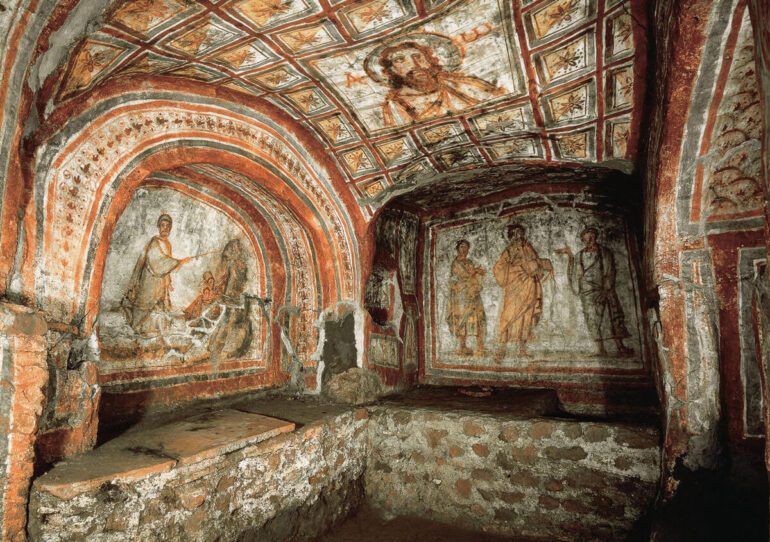
The Best Rome’s Catacombs to visit
Every time you turn a corner in Rome you stumble upon another ancient temple or Renaissance masterpiece but have you ever wondered what lies beneath your feet? Acres and acres of tombs! Rome is home to a vast underground maze of catacombs carved out of the soft, volcanic tufa stone that surrounds the city.
There’s a myth that during their persecution, Christians used the catacombs as a secret place to bury their dead but in reality the location of the catacombs was well known. Poor Christians simply couldn’t afford to be buried in their own private grave so they would arrange to have their bodies carried down into these tunnels, laid out in a sarcophagus or shelf in the wall and sealed over to await the Last Judgment…or the inquisitive eyes of archeologists.
Begun in the 2 nd century A.D. these 60 burial sites were extended deeper into the earth as they filled up with bodies one layer at a time. In the 6 th century more familiar church cemeteries took their place and the entrance to the catacombs were often blocked up to prevent them from being looted.
Catacombs of San Callisto
Catacombs of san sebastiano, catacombs of domitilla, catacombs of priscilla.
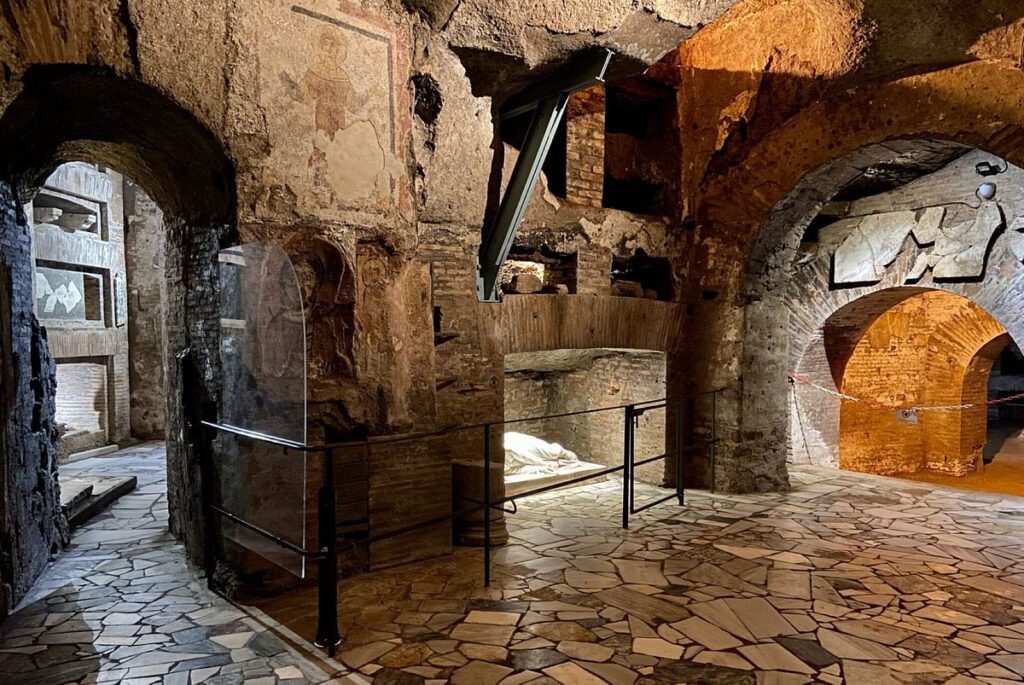
Possibly Rome’s most famous catacomb, this site extends almost 20 km and was the burial place of more than 10 martyrs and 16 popes. As the official catacombs of the Roman Church, the crypt of the popes was known as “the little Vatican” and you can still see the Greek markings “MPT” on two of them for “martyr.” You can also see burial place of Saint Cecilia, the patron saint of music, buried here for five centuries until her remains were transferred to a church in Trastevere.

This cemetery, named after the martyr St. Sebastian, who is buried here, was originally called “ad catacumbas”. According to the widely acknowledged explanation, the name signifies “near the hollows”, because of the mines of tuff located in this area. The name was later used generally to indicate all subterranean Christian cemeteries. The tour of this catacomb, which has second-century pagan tombs along with Christian chapels, will take you down a staircase studded with pieces of sarcophagi with imperial seals. Underneath the church, you’ll see an area with three decorated pagan tombs with some very attractive frescoes and a floor mosaic. It is believed that both Christian and pagan funerals were held in the elaborate central chapel, the vault of which has acanthus and lotus-leaf stucco decorations. The Chapel of Symbols has early Christian symbols carved in it. Up another staircase is a dining room for funeral banquets. The graffiti date back to the second century.
CLICK HERE TO BOOK SAINT SEBASTIAN CATACOMBS TOUR
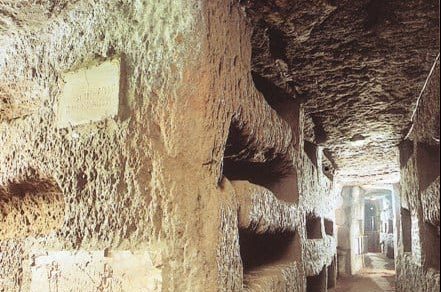
Rome’s oldest catacombs are the only ones that contain an ethereal sunken basilica through which you can enter the labyrinth below. Built in the 4 th century, the basilica was abandoned in the 9 th and not until 1870 was it reconstructed. You can visit the tombs of the martyrs Nereus and Achillius and gaze upon the most extensive inventory of catacomb paintings which includes an image of the Last Supper. They are also the only catacombs that still contain bones.
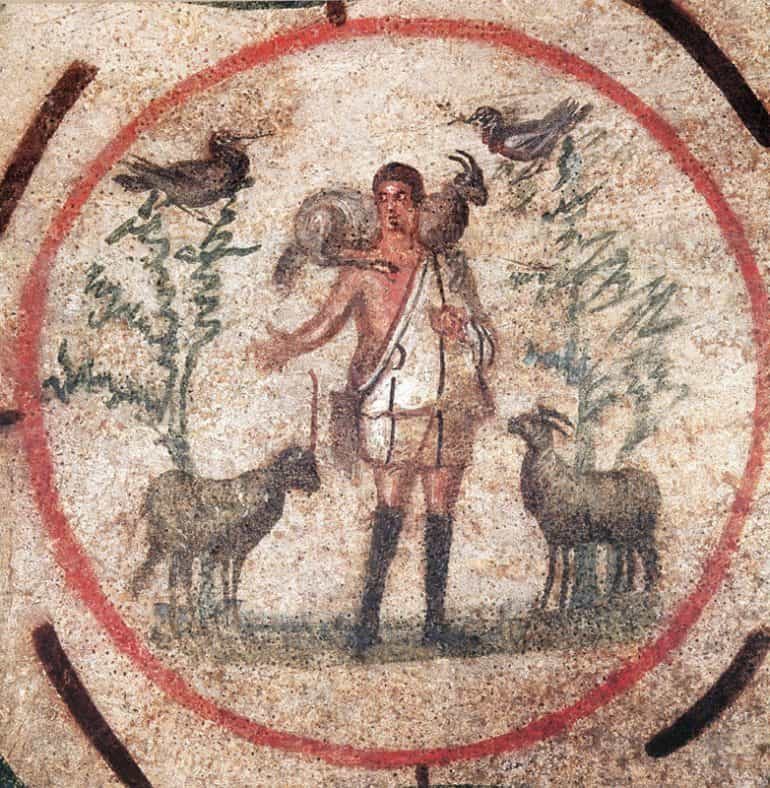
Run by an order of nuns, these catacombs were named after the woman who owned the land in which they were built and were known as the “regina catacumbarum” or the queen of the catacombs. They are famous for housing the oldest image of the Virgin Mary in existence. There’s also a chilling view point where you can look down and see the three levels of grave sites dug farther and farther into the earth to accommodate the dead.
CLICK HERE TO BOOK PRISCILLA CATACOMBS TOUR
Check out the Museum And Crypt Of The Capuchin Friars as well
The Best Underground Sites Of The Eternal City
Sign up to our newsletter for the latest news, events, and insights from Rome
By subscribing you agree with our privacy policy .
Check your inbox or spam folder to confirm your subscription.
Related Post:
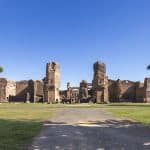
Your email address will not be published. Required fields are marked *
Yes, add me to your mailing list
Catacombs of Saint Callixtus
Tickets sell out fast in Rome: check availability now »
Explore the largest Christian catacombs in Rome.
The Catacombs of Saint Callixtus are not only the most famous of Rome’s Christian catacombs, but they’re also one of the oldest official cemeteries of the Church of Rome. Visit the tombs of popes, martyrs, and half a million Christians in this subterranean complex.
- Discover the Crypt of the Nine Popes, known as ‘the little Vatican’ of the cemetery.
- Marvel at the mosaics and frescoes covering the walls of the Crypt of St. Cecilia – the patron saint of music.
- Try to decode the carvings of early Christian symbols found on the walls and tombs – see if you can spot the phoenix.
Tickets & Prices
Enjoy a 45-minute guided tour of the catacombs and its highlights with an official live tour guide. You’ll delve deep into the history of the cemetery and learn about the period of Christian persecution in Rome, hear interesting stories about some of the occupants of the tombs, and discover the meaning behind the mystifying symbols etched into the stone.
Find out which ticket best suits your needs with this handy guide below.
- Guided Tour – 40-minute guided tour of the Catacombs.
- Panoramic Bus Transfer & Guided Tour – Get picked up from the city center and enjoy the views along the way with this direct return transfer ticket to the Catacombs. Includes a guided tour.
- Hop-on Hop-off Bus, Travel Card, & Guided Tour of St. Callixtus Catacombs – This ticket gives you 24-hour access to Hop-on Hop-off open buses (Vatican & Rome) and all forms of public transport within the Comune di Rome (urban, underground, and overground + Rome-Ostia train route in both directions). With entrance and a guided tour of the Catacombs included.
Standard Admission Fee and Concession Tickets
For standard tickets.
- Reserve your ticket online. Simply choose the language you wish to hear the tour in, select the date of your visit and your ideal time slot, fill in your personal details, and receive a confirmation email.
- On the day of your visit, you’ll pay at the ticket office after showing confirmation of your reservation (either in printed or digital form). Both cash and all major cards are accepted.
- You’ll then wait at the flag of your language until called by your tour guide.
- Tours are conducted in Italian, English, Spanish, French, German, and Polish.
For Concession Tickets
With this ticket, you’ll experience the same booking process and guided tour as the standard admission ticket. Find out if you’re eligible for a concession ticket below.
This ticket is intended for:
- Children from ages 7 to 16.
- Students of archeology, architecture, art history, or cultural studies up to 25 years of age (with proof of eligibility).
- Priests, novices, or seminarians (with proof of eligibility).
- School groups.
Free Admission
This ticket also grants you the full experience provided by the standard admission ticket, and the booking process is also the same. Some individuals are eligible to enjoy a free admission ticket. Find out below if this applies to you.
- Children under the age of 7.
- Disabled visitors and their companions.
- Students from the Pontifical Institute of Christian Archeology
- Salesian brothers of Don Bosco, and sisters of Mary, Help of Christians
- Professors, teachers, and catechist teachers accompanying groups of 15 and over.
- Two complimentary tickets for groups of at least 35 people when paying the standard admission fee.
- Licensed tour guides (with proof of eligibility).
- Researchers who make a request to the Pontifical Commission of Sacred Archeology.
Catacombs of St. Callixtus: Guided Tour
Experience a 40-minute guided tour with a live guide with this immersive ticket. Discover the history behind this underground cemetery, and walk around the tombs of the early popes and martyrs buried here.
This ticket is very similar to the standard admission ticket. Buy this ticket if you want the option to pay for your ticket online and to have the flexibility of free cancellation.
- Choose the date and time slot that best suits you online. Enter your personal details and pay by credit/debit card, PayPal, or AliPay.
- The tickets will be sent to your email, which you can then print out or show directly from your smartphone.
- Arrive ten minutes before your intended tour. Show your ticket, and you’ll be directed to your guide.
- Free cancellation until 23:59 on the day before your visit.
- Guides are available in English, French, German, Italian, and Spanish.
Additional Information
- The catacombs are open every day except Wednesdays from 9:00 – 12:00 in the mornings and 14:00 – 17:00 in the afternoons. The ticket office closes at 16:50.
- Wheelchairs are not permitted within the catacombs, and those with severe mobility issues may encounter walking difficulties.
- It is forbidden to take pictures or videos inside the catacombs.
- Remember to bring something to cover up, as it’s chilly and humid down in the catacombs.
How to Get There
The Catacombs of St. Callixtus are 20-30 minutes from the city center, depending on the traffic.
The best way to reach the Appian Way and the catacombs is by bus. There are 2 options:
Departing from San Giovanni ( metro line A), this bus does the first part of the Appian Way , then goes right when the road forks at Quo Vadis church.
Stay on board for a few more minutes until the Fosse Ardeatine stop, and you’ll almost be opposite the back entrance to the catacombs. The gate is above you on the other side of the road and is open whenever the catacombs are.
The Fosse Ardeatine bus stop seen from the back entrance to the Catacombs of St. Callixtus
You can catch this bus from the Circo Massimo (the bus stop is around the corner on Viale delle Terme di Caracalla) or Colosseo metro stops (line B). You should get off at the stop at Catacombe San Callisto, and you’ll see the entrance to the catacombs.
You can also get there by bike. Bikes can be rented at the Circus Maximus or the beginning of the Appian Way. There are also bike tours that include a visit to the catacombs. If you arrive by bike, there is a bike parking area inside the complex to the right before you reach the ticket office.
Walking to the catacombs will take about 45 minutes. You can either leave from the Circo Massimo metro, take Viale delle Terme di Caracalla, and continue in a straight line for about 40 minutes until you reach the catacombs, or start from San Giovanni and follow the ancient walls to Porta San Sebastiano and the beginning of the Appian Way, then turn left. Sunday is the best day to walk when most of the Appian Way is closed to traffic.
When to Visit
The catacombs of Saint Callixtus are closed on Wednesdays. If you are only able to visit the catacombs on Wednesdays, the nearby Catacombs of Saint Sebastian are open every day.
What to Wear
Inside the catacombs, it’s 16°C / 60°F, even when it’s hot outside. Initially, it’s wonderfully cool, but it will get chilly if you don’t cover up. You should wear closed shoes and bring something to cover your shoulders and back. However, although this is a religious site managed by the Vatican, they don’t impose a dress code on visitors.
When you arrive, go first to the ticket office. If you have bought your ticket online, show them the booking, and you’ll receive a ticket. If you haven’t got your ticket already, you can buy them for the next available timeslot.
You cannot use your Roma Pass here.
Tourist passes are not valid here
The ticket includes a guided tour as it’s not possible to visit the catacombs without a guide. When you buy your ticket, you’ll be asked to select the language you would like. There are tours throughout the day in English, Italian, French, Spanish, and German.
You have to wait in front of the language of your tour just before the time on your ticket. There are regular announcements informing visitors when to line up for the next tour.
Line up next to the right language
When the gate in front of the flag is opened, a member of staff will tear off part of your ticket and invite you to enter.
The tour starts outside with an overview of the catacombs. The guide uses boards to explain how the catacombs were built, but if you aren’t at the front, it can be difficult to see.
The first part of the tour is explained outside
After the introduction, you enter the catacombs down a steep flight of steps. From this point, you cannot take photos or videos.
The Catacombs of Saint Callixtus are the biggest and most famous of the catacombs, so you can expect to find a lot of groups there at the same time.
Each group can have up to 50 people, and there will be groups in front and behind you, so the guides have to keep moving and won’t answer questions during the tour.
The guide uses a microphone, but the visitors do not have headsets, so you might find it difficult to follow everything that is being said. If you’re part of a large group, the guide might be inside a room talking, and some of the group is left outside, unable to see or hear.
The tour visits the Crypt of the Popes, leaders of the church in the 3 rd century when Christians were persecuted in Rome. Other Roman martyrs were also buried here, like Saint Cecilia, whose statue is in one room, though their remains were moved into the city after Christianity was legalized.
Along the way, you’ll pass many corridors lined with tombs and see some of the larger cubiculum, family tombs of more wealthy residents, with wall paintings with Christian stories and motifs.
Accessibility
To enter the catacombs, you must be able to walk up and down steep steps and walk at a slow pace for 30 minutes.
With limited light underground, the visit may not be suitable for those with impaired vision.
The tour also isn’t recommended for anyone who suffers from claustrophobia. Although none of the tunnels are particularly small (most are about 1m wide), they are extensive. You won’t be able to see the exit, and the guide cannot leave the group to assist you outside, so be sure you are comfortable with this before the visit.
In the small complex, there are vending machines for coffee and snacks, water fountains, toilets, and areas for sitting in the shade while you wait for your tour to start. There’s also a gift shop selling rosaries, books, paintings, and postcards.
Inside the gift shop
Surroundings
The Appian Way is one of the most beautiful green areas in Rome, so it’s worth adding an hour or so to your visit to explore part of it. The way is well-signposted. Just follow the signs for Appia Antica after your tour.
Directions are easy to follow
A 20-minute walk will take you to some of Appia Antica’s most beautiful sites. If you go on a hot day, make sure to cover your head as there’s very little shade.
The Basilica of Saint Sebastian
There are other catacombs underneath the basilica, where the bodies of St. Peter and St. Paul were kept. Stop at the basilica to see the statue of St. Sebastian, the Roman soldier who was shot to death by arrows (a popular subject with Roman artists), and Bernini ’s final statue.
The Basilica of St. Sebastian
The Stadium of Maxentius (Closed Mondays)
Many people don’t know that the Circus Maximus isn’t the only stadium remaining in Rome. This one was built on the private land of the emperor Maxentius and is much better preserved than the Circus Maximus. You can walk inside (entrance is free) and get lovely views of the Tomb of Cecilia Metella.
The Circus of Maxentius
The Tomb of Cecilia Metella (Closed Mondays)
The circular tomb of a Roman noblewoman was made into a fortress in the 12 th century.
The Tomb of Cecilia Metella
Part of the Original Roman Road
Part of the original Roman road
In this same area, there are several places where you can stop for lunch. It’s best to book, especially on Mondays when several of them are closed.
There are many places to stop for lunch on the Appian Way
Did you Know That: 4 Interesting Facts
- Although only some areas are accessible to the general public, the whole complex of the catacombs spans five underground levels over an area of 90 acres.
- The reason the catacombs lie so far from the historic center is because of an Ancient Roman law that prohibited the burial of the dead inside the city for health reasons.
- The word ‘cemetery’ derives from ‘coemeterium’, the Greek for ‘dormitory’, as, for the Romans, the burial of the dead was a temporary ‘sleep’ while they waited for the final resurrection.
- The catacombs are located on the Appian Way, one of the earliest and most important Roman roads which are still in use today.
- The Catacombs of Saint Callixtus were founded in the middle of the 2nd century CE, shortly after the Christians started burying their dead underground, at a time when they were greatly persecuted by the Romans.
- Although probably started from family tombs, the burial grounds were open to everyone of the Christian faith and expanded over time.
- At the beginning of the 3rd century, the catacombs became the official cemetery of the Church of Rome. Pope Zephyrinus appointed the deacon Callixtus as their administrator. It’s from him that they get their name.
- Even after the end of Christian persecution, the cemetery stayed in use until the beginning of the 5th century, when Christians began to be buried in basilicas or above ground.
- They were subsequently abandoned and, by the late Middle Ages, even forgotten.
- They were rediscovered in 1854 by Italian archeologist Giovanni Battista de Rossi, considered the father of Christian archeology.
- In 1930 the Holy See entrusted the care of the catacombs to the Congregation of the Salesians of Don Bosco.
- Today, the Catacombs of Saint Callixtus are the most popular catacombs out of the five in Rome that are open to the public and are enjoyed by pilgrims and tourists alike.
You can get tickets to the Catacombs of St. Callixtus from the official site or at the desk office on arrival.
A total of 16 popes are buried in the Catacombs of St. Callixtus.
Which is the best catacomb is arguable. But the Catacombs of Callixtus are certainly the most famous and are also one of the oldest in the Church of Rome.
The catacombs are certainly worth seeing. They offer a unique experience and insight into the history of Rome and are the resting place of some of the greatest popes and martyrs.
Address: Catacombs of St. Callixtus, Via Appia Antica 110/126, 00179 Roma, Italy · view larger map

Catacombs of Rome: how to visit and where to find them

The Catacombs have always been a very fascinating topic, especially in Rome, where we count more than 60 catacombs!
Let’s learn what the catacombs are, which are the best catacombs to visit in Rome and how to visit them. We also offer a semi-private guided tour including one of these catacombs and the Appian way, which you can find here .
What are the Catacombs of Rome?
The name Catacombs comes from the ancient Latin ad catacumbas , which literally means “in the hollow”.
The first catacomb to be called like that was the Catacomb of San Sebastiano . Before becoming a cemetery, there was a quarry of pozzolana ash, which created a sort of cave, a hollow.
Later on the Romans (pagans) built some sanctuaries (still incredibly preserved and visible today!) in the hollow. Successively it became a Christian cemetery.
Since then, every underground cemetery was referred to as “catacomb”.
Which are the best Catacombs to visit in Rome?
With over 60 catacombs in Rome, choosing where to go can be challenging. All the catacombs are located outside of the ancient Roman city walls (the Aurelian walls).
This means you won’t find catacombs in the very city center today, but you’ll have to move in less central areas of the city.
These are the best catacombs of Rome that we suggest visiting. (Please note we’ll be adding more catacombs on this list over time!)
We take you to some of these catacombs during our Oldest Catacombs in the World and Appian Way tour. Click here to learn more!
Catacombs of San Sebastiano

The Catacombs of San Sebastiano are the first catacombs of Rome . This is where the word “catacomb” originated from, and then used to refer to all the underground cemeteries.
The Catacomb of San Sebastiano are located on the Appian Way , in the east suburb of Rome. It features 12 kilometers (7.5 miles) of galleries and more than 100000 burials .
Many tombs of Saints were here, for example San Sebastian. Later on the Popes decided to move the relics of the saints inside their respective churches, to preserve them from the tomb raiders, which in the past have been stealing the grave goods and jewels from the catacombs.
Above the Catacombs of San Sebastiano a basilica church was built, which is also referred to as: in memoria apostolorum . This name comes from the fact that in the 3rd century the relics of St Peter and St Paul were temporarily transferred here to protect them from the persecutions. Now St Paul is buried in the church of St Paul outside the Walls. While St Peter is buried in St Peter’s basilica.
To visit the Catacombs of San Sebastiano you need to buy a ticket directly at the venue or online. The visit to the Catacombs lasts about 40 minutes.
To make the trip to the catacombs even more worth it, you can combine these Catacombs with a tour on the soon-to-be Unesco World Heritage site, the Appian Way. That’s the very first road the Romans built and you can walk on it! All this is included in our Oldest Catacombs in the World and the Best of the Appian Way tour !
Catacombs of Domitilla

The Catacombs of Domitilla are located on the Via Ardeatina, near the Appian Way. These are one of the longest network of corridors among the Catacombs of Rome.
These catacombs feature more than 17 kilometers of galleries , across 4 different levels underground . With an estimate of over 15000 bodies .
During the guided visit you will be able to explore the second level (counting from overground).
The highlights of this catacomb is the underground basilica dedicated to Achille and Nereo, (two of the first Christian martyrs), and the fascinating frescoes that include a lot of the Christian symbolism, still visible in such vibrant colors.
To visit this catacomb you need to pay an entry ticket. That includes the guided tour by the internal guide to the site, which you can purchase directly on site.
Catacombs of San Callisto

The catacombs of San Callisto are the biggest catacombs of Rome. Over half a million Christians were buried here, including 16 popes and several martyrs !
These catacombs feature a network of galleries of about 20 kilometers located across many floors.
The most important highlight is the Crypt of the Popes . Which is also the most sacred place of the Catacombs of San Callisto.
Another highlight is the crypt of Saint Cecilia . This is where the body of the patron saint of music was located, before Pope Pasquale I moved it to the church of Santa Cecilia in Trastevere.
We visit this church and Cecilia’s crypt in Trastevere during our best-selling tour “ Hidden Gems of Trastevere, Tiber Island & Jewish district “.
The Catacombs of San Callisto are located on the Appian Way. This is one of the catacombs which is included in our Oldest Catacombs in the World and the Best of the Appian Way tour !
Written by Federica

You may also like..

Things to do in Rome in March 2024
Feb 26, 2024
International sports competitions, marathons, archaeological sites and temporary exhibitions. There’s so much to do in Rome this March 2024!

Things to do in Rome in April 2024
Feb 1, 2024
Breathtaking astronomical events, Rome’s birthday, flowers, air shows and more . There’s so much to do in Rome this April 2023!

Things to do in Rome in May 2024
Jan 31, 2024
Special openings of hidden places, international sports competitions and breathtaking shows. There’s so much to do in Rome this May 2024!
You say all catacombs are outside Rome. What about Priscilla’s catacomb? It’s on via Salaria in the city.
Ciao Peter! The catacombs were all outside the ANCIENT city walls. The city of Rome later on expanded and now the area of the Catacombs of Priscilla is inside the modern city. But the closest ancient city walls to those catacombs were by Villa Borghese today. Hope this makes sense! 😊
Submit a Comment Cancel reply
Your email address will not be published. Required fields are marked *
Save my name, email, and website in this browser for the next time I comment.
Submit Comment
- In the Press
- Work with us
- Rome & Vatican Rome Vatican Colosseum Rome Food
- Italy Florence & Tuscany Venice & Northern Italy Pompeii & Herculaneum Amalfi Coast & Capri Naples & Southern Italy
The Best Catacombs in Rome You Need to Visit
Fri 12 Jan 2024
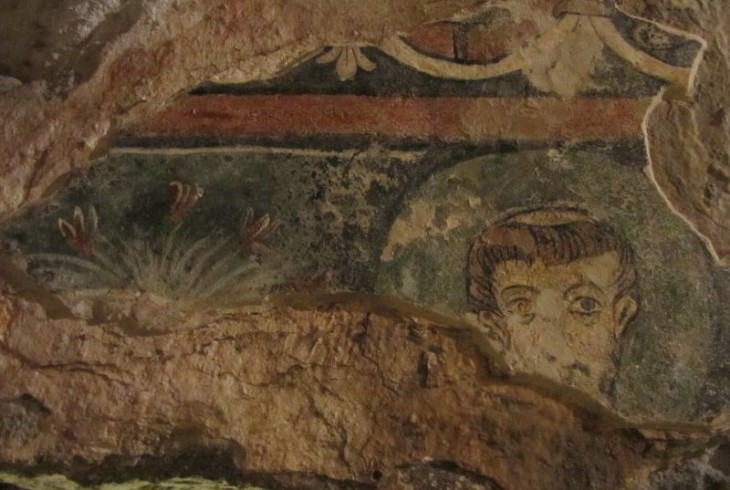
Rome, it is often said, is like some great archaeological lasagne. As if the stunning monuments that grace the streets of the Eternal City weren't reason enough to make Rome one of the world's most fascinating places, what you can see at first glance in Rome barely scratches the surface of the city's riches. Thanks to its continuous habitation over thousands of years, an array of extraordinary historical sites lie concealed beneath the street level of the modern city, vast underground worlds hiding in plain sight just awaiting discovery by the intrepid traveller. And of all the subterranean sites in Rome, the catacombs are arguably the most fascinating .
In these passages and caves carved deep into the Roman bedrock beyond the ancient city walls, the city's early Christian community came to bury their dead in the hope that they would remain undisturbed by those hostile to the new religion. But although these places are conditioned by death, we must remember that death was not the end for these early believers. To understand these silent memorials in all their complexity, we must understand that they are as much celebrations of a glorious birth rather than commemorations of a sad death. In the shapes and forms of the wonderfully simple wall-paintings, carvings and inscriptions that survive in these tunnels, we can gain a unique insight into the world of early Christianity, and the distant thoughts and philosophies that animated these spaces millennia ago.
Read on to discover the most important catacombs that you can visit in Rome!
Catacombs of Domitilla
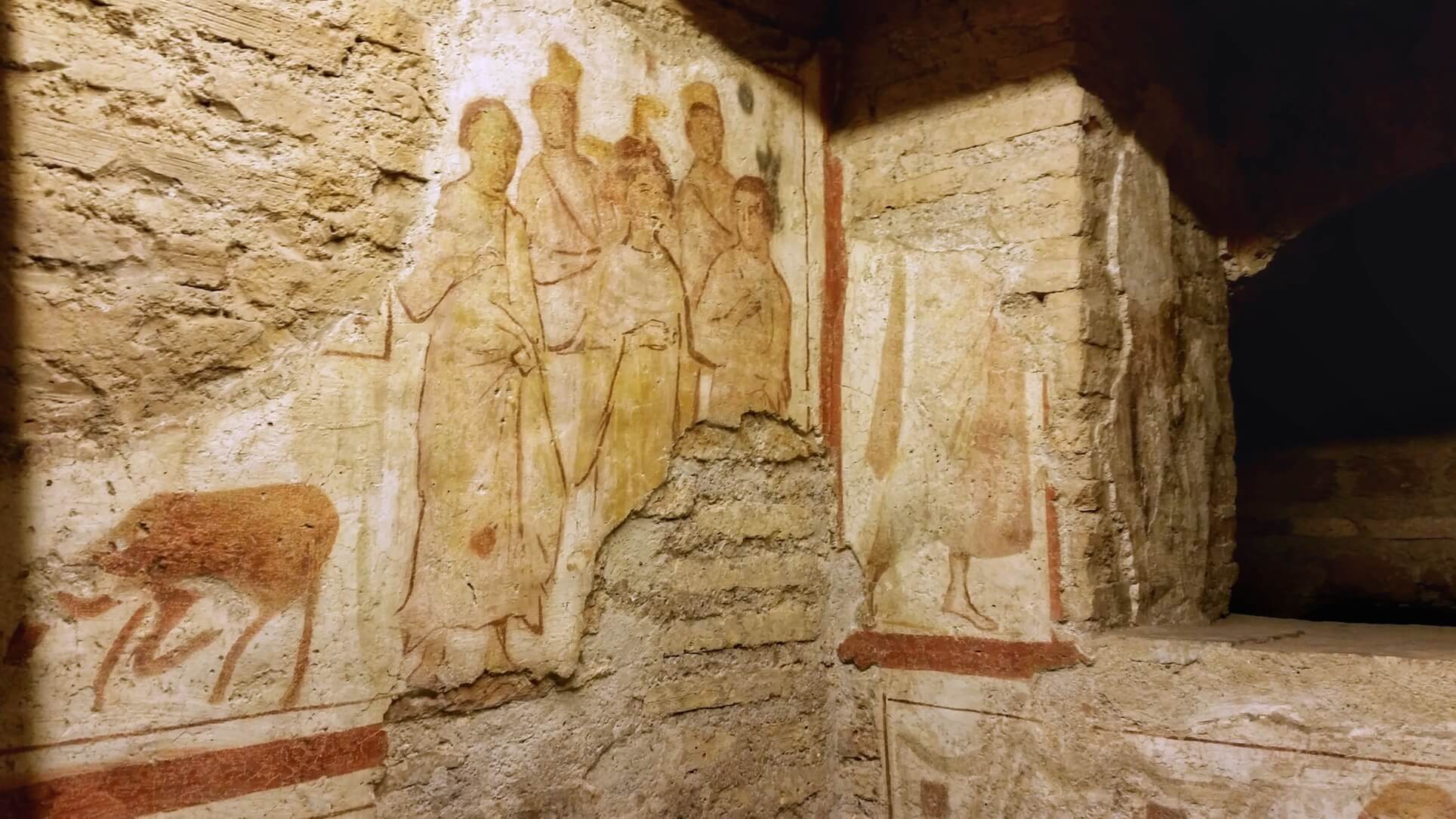
The remarkably well-preserved Catacombs of Domitilla , located along the ancient Via Ardeatina, form one of the largest subterranean burial complexes in Rome. Dating back to the 2nd century, when the aristocratic Christian convert Flavia Domitilla donated land to the nascent church, the catacombs contain a vast network of galleries and tombs linked by labyrinthine tunnels carved out of the soft tufa rock characteristic of the Roman countryside.
The passages are lined floor to ceiling with narrow niches called niches which house the remains of countless early Christians. Small rooms, or cubicles , open out from the maze to reveal the final remaining places of families rich enough to enjoy the peace of private sepulchres. Strange symbols are engraved into their tombs – fish and anchors, secret signs that demonstrated the presence of Jesus Christ, messiah and savior of the Christian faith.
Wall paintings provide a window into the burial practices and beliefs of early Christians: allegorical images of plants and animals including phoenixes - symbolic of the resurrection - appear alongside depictions of important religious figures such as the twelve apostles, and one particularly fascinating portrait of a man identified as Diogenes, who appears with a pickaxe and shovel: it was his task to dig out the catacombs for the secure burial of his fellow Christians.
This extraordinary hidden world lay undiscovered for many centuries until it was unearthed in the late 1500s by Antonio Bosio, a man known as the 'Columbus of the Catacombs' for his intrepid adventuring spirit. He got lost for three days down here in search of the lost origins of Christianity, and it's easy to see why even today, even with the aid of electric light illuminating the spooky way down towards the center of the earth.
Catacombs of Domitilla, Via delle Sette Chiese, 282. Opening Hours: from 9.00 to 12.00 and from 14.00 to 17.00. Closed on Tuesdays. Tickets €8, €5 reductions.
Catacombs of San Sebastiano
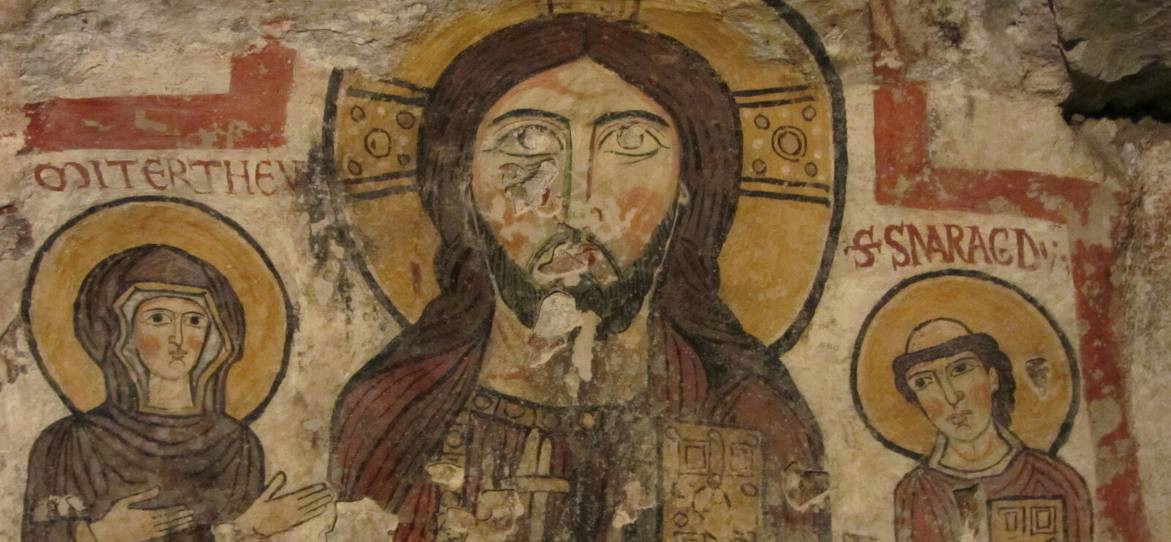
Historically the most easily accessible of the Roman catacombs, the small burial complex of San Sebastiano never slipped from the historical record as did the other entries on our list. Consequently, whilst perhaps being the most famous of the Roman catacombs, it has also suffered the depredations of grave robbers and material stripping more than its neighbours. Nonetheless, it still stands as a fascinating testament to the world of early-Christian Rome. Believed to house the final remaining place of the highly revered 3rd-century martyr Saint Sebastian, moved here by the pious matron Lucina after he appeared to her in a dream, the catacombs are located beneath the church of San Sebastiano Fuori le Mura near the beginning of the Appian Way.
Originally a mine for pozzolana stone in antiquity, the site was adapted for pagan - and eventually Christian - burial from the 3rd century onwards.. Numerous graffiti referring to the apostles Peter and Paul attest to the site's sacred significance for early Christians, and it has been theorized that the relics of the saints were briefly transferred here to a marble aedicule for safe-keeping in the 3rd century. The so-called Cubicle of Jonah houses incredible early-Christian frescoes depicting the life of the prophet, while the Crypt of Saint Sebastian features a beautiful marble statue of the saint designed by Baroque master Gianlorenzo Bernini and sculpted by Antonio Giorgetti.
Catacombs of San Sebastiano, Via Appia Antica, 136. Opening Hours: from 9.00 to 12.00 and from 14.30 to 17.00. Tickets €8, €5 reductions.
Catacombs of Priscilla
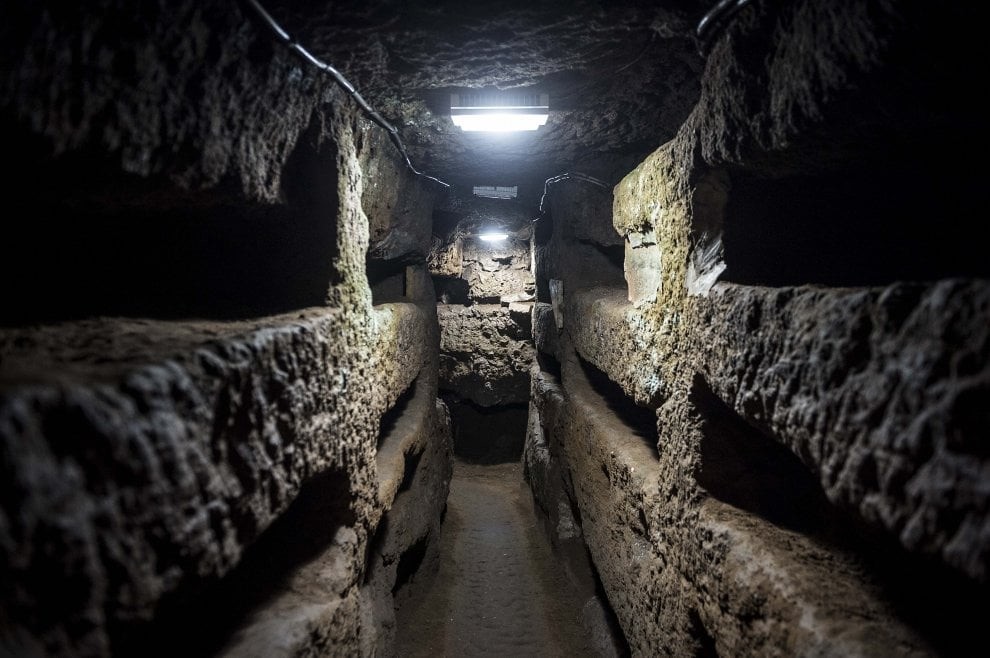
Often referred to as the "Queen of the Catacombs," thanks to the variety and extent of the early-Christian remains housed there, the Catacombs of Priscilla conserve over 40,000 bodies extending over 13 kilometers of tunnels excavated from the soft tufa rock beneath what is now the Roman park of Villa Ada. Located along the ancient consular road Via Salaria, the complex occupies a particularly privileged place in Christian hagiography as a result of the numerous popes and saints interred here during the time of the Emperor Diocletian's persecution of the new faith: Popes Marcellinus, Marcellus and Sylvester were buried here alongside notable saints including Felix, Philip, Praxedes and Pudenziana.
When the complex was rediscovered at the height of the Counter-Reformation in the 16th century, it caused a sensation. The cardinal and historian Cesare Baronio described how 'all of Rome was filled with wonder' at the find, 'for it had no idea that in its neighborhood there was a hidden city, filled with tombs of the days of the persecutions of the Christians. '
Exceptionally high-quality paintings, including the oldest known depiction of the Virgin Mary and the infant Christ as well as a beautifully enigmatic fresco of a veiled woman dressed in liturgical vestments, make the catacomb an incredibly important site for art historians. The catacombs also feature a vast network of burial niches, adorned with frescoes depicting biblical scenes and symbols of Christian faith. Counters and marble seating provide evidence that early Christians staged ritual banquets in honor of the dead down here, a fascinating memorial practice that is alluded to in a particularly fine depiction of a Eucharistic meal of bread and fish.
Catacombs of Priscilla, Via Salaria, 430. Opening Hours: from 9.00 to 12.00 and from 14.00 to 17.00. Closed Mondays and the month of August. Tickets €8, €5 reductions.
Catacombs of San Callisto
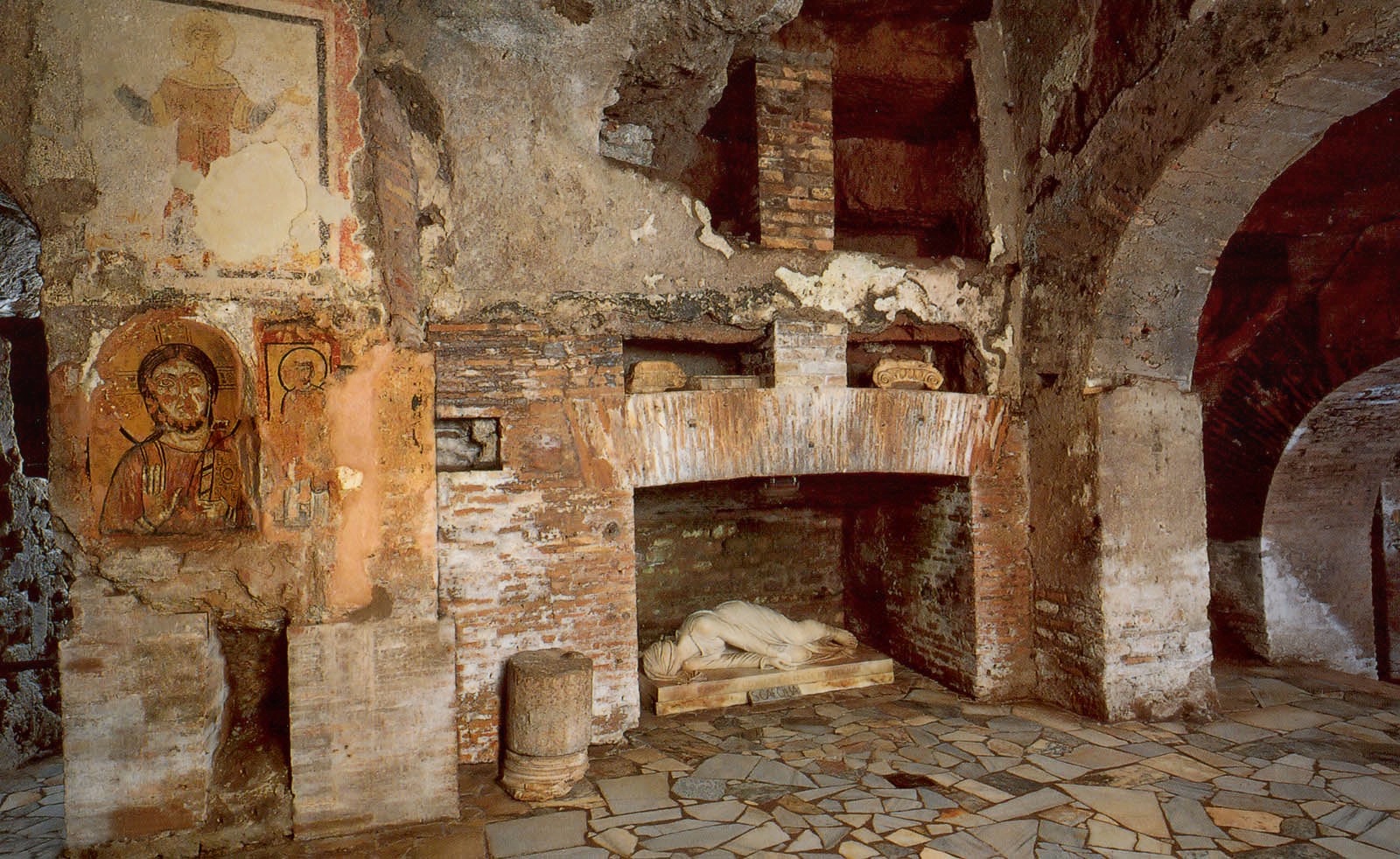
The Catacomb of San Callisto is the oldest and best preserved of the cemetery complexes on the Appian Way. Dating back to the 2nd century AD, the catacombs served as the final resting place for numerous prominent early Christians, and its tunnels and galleries extend over 20 kilometers and multiple levels. Notable features include the Crypt of the Popes, a gallery that was described by its 19th-century rediscover GB de Rossi as a “Little Vatican” thanks to the presence of the mortal remains of no fewer than 9 early pontiffs and 8 bishops.
But perhaps the most famous early Christian laid to rest in the catacomb is the locally revered Saint Cecilia, the patron saint of music who was martyred for her faith in the 3rd century. Her body di lei was moved to the church in Trastevere that bears her name di lei in the year 821, although the original marble sarcophagus in which she was interred is still visible in the atmospheric Crypt of Saint Cecilia. A copy of the magnificent statue of the saint that graces the high altar of Santa Cecilia in Trastevere has also been placed here, adding to the evocative atmosphere. Well-preserved frescoes depicting the sacraments of Communion and Baptism, meanwhile, are preserved on the walls of the so-called "Cubicoli dei Sacramenti," offering a vivid insight into the lives and customs of the early Christian community in Rome.
Via Appia Antica, 110. Opening Hours: from 9.00 to 12.00 and from 14.00 to 17.00. Closed Wednesdays and the month of February. Tickets €8, €5 reductions.
Catacombs of Saint Agnes

According to Christian hagiography, the unfortunate Saint Agnes was little more than a girl when she was brutally executed for refusing to renounce her faith in the 3rd century, and her cult quickly became one of the most popular in all of Rome. A shrine sprang up at her reputed burial place in a small Christian cemetery dug into the side of a hill along the Via Nomentana. When Constantine converted to Christianity and promoted the development of Christian architecture a century later, he commissioned a basilica on the site.
The church was rebuilt in the 7th century and features a stunning apse mosaic featuring the young saint. Descend beneath the church to explore the small catacomb: although there aren't wall paintings comparable to the other sites on our list down here, numerous inscriptions and funerary paraphernalia make the catacombs well worth a visit.
Via Nomentana, 349. Opening Hours: from 9.00 to 12.00 and from 16.00 to 18.00. Closed Sunday mornings and the month of November. Tickets €8, €5 reductions.
We hope you enjoyed our guide to the catacombs in Rome! To visit the catacombs in the company of an expert archaeologist guide alongside other fascinating subterranean sites in the Eternal City, be sure to join our award-winning Underground Rome with catacombs tour !
Post Categories
Suggested Tours
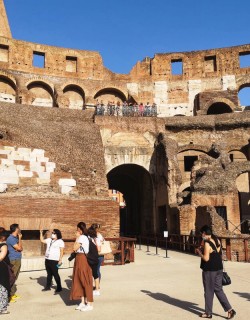
Colosseum with Gladiator Arena Floor, Forum and Palatine Hill Semi-Private Tour
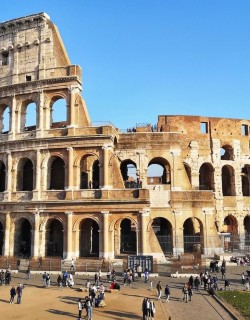
Ultimate Colosseum Semi-Private Tour with Roman Forum & Palatine Hill

Rome at Twilight Among the Piazzas and Fountains: Evening Semi-Private Walking Tour

Domus Aurea Tour (Nero’s Golden House)
Subscribe to our newsletter and receive 5% off your first booking!
You'll also receive fascinating travel tips and insights from our expert team
Subscribe to our free newsletter
Thank you for subscribing!
You should shortly receive a confirmation message with your discount code. If you do not receive this within 5 minutes, please email [email protected].
9 Most Interesting Rome Catacombs Tours of 2024
From the Colosseum to the Spanish Steps, there are so many attractions there is so much to see and do in Rome. However, When in Rome, don’t miss the famous Roman Catacombs! We’ve pulled together the most interesting Rome catacombs tour for you whether you are interested in history, art, or cruising the countryside on a bike.
We spent six weeks exploring Italy with our kids, from Bari up to Venice on our Family Gap Year and we return as often as we can. While Trastevere is our favorite neighborhood in Rome, we love the mix of old and new throughout the city. There are always new things to discover and plenty of activities for all ages. We have found that the underground areas in Italy are some of the most fascinating spaces.
When I first heard about the Roman Catacombs, I had images of piles of bones, much like the famous Paris Catacombs. However, the Catacombs in Rome are some of the oldest catacombs in the world- and seeing stacks of bones is just the beginning. Inside the Catacombs of Rome, you won’t find many bones- instead, you’ll find ancient Christian art, and miles of early Christan history stretching beneath the outskirts of the city. We’ll cover the best tours of the catacombs in Rome, what to expect from each tour, how each Rome catacombs tour is different, and answers to all your questions about the different catacombs you might visit.
We also have a quick history of the Rome catacombs, as well as advice on what to bring with you on your Roman catacombs tour. Rome, called the Eternal City, is such a fascinating place full of history at every turn.
This article may contain affiliate links, which means we may earn a small commission if a reader clicks through and makes a purchase. As an Amazon Associate, we earn from qualifying purchases at no additional cost to you. All our recommendations are our own and are in no way influenced by any advertiser or commercial initiative.
At the bottom of this post, download free Mobile Wallpaper images to satisfy your wanderlust!
If you are interested in budget travel to Europe, join our free Facebook Group: Europe Travel with Families on a Budget .
Editors Pick: Rome Catacombs Tour In a Hurry? Book our Top Pick: Rome Catacombs Night Tour with Exclusive Access
Table of Contents
Are the Roman Catacombs Worth Seeing?
Yes, the Catacombs in Rome are definitely worth seeing! There is an immense amount of history in these tunnels, as well as precious artworks.
Unlike the Paris Catacombs, the main draw of the Roman Catacombs is not the bones, in fact, most Roman catacombs have removed bodies and bones from the tourist route, respectfully moving their final resting place deeper into the tunnels.
Instead, you’ll see ancient passageways, places where early Christians worshipped in secret, and priceless pieces of early Christan art. National Geographic calls Rome “the capital of catacombs”- there are rumors that the legendary Holy Grail may be here- buried in a lost section of the Roman catacombs.
We also visited the catacombs of St. Paul in Malta , and while we enjoyed them for other reasons, they had very few visible pieces of art remaining. Rome really does boast some of the most compelling catacombs in the world.
Quick Guide: The Best Catacomb Tours of Rome, Italy
Rome Catacombs Night Tour with Exclusive Access Restricted Areas Catacombs of St. Agnes
Roman Catacombs: After-Hours Tour
Crowd-free, Includes Bone Chapel Catacombs of St. Priscilla
Rome Catacombs Tour via Golf Cart
Best Catacomb Tour for Families Catacombs of St. Callixtus
The 9 Most Interesting Rome Catacombs Tours
These are the most engaging, best catacomb tours in Rome for every traveler- from those who love history to those who love the macabre. From group tours to biking tours, and even a ghost tour, we’ve got the best catacomb tour in Rome for you!
For each tour, we’ve listed which of the Roman catacombs you should expect to visit. Jump down below the tour list to see a description of each catacomb and what they are famous for to make sure you’re picking the one that interests you most.
1. Top Pick: Rome Catacombs Night Tour with Exclusive Access
🌟 Rating: 5 Stars ⏳ 2 1/2 Hours ✅ Exclusive Rooms, St. Agnes 🔎 Check Rates
This night tour is limited to six people at a time and has access to parts of the St. Agnes catacombs that are usually off-limits. You’ll start this catacombs tour at 5 pm with a visit to the Capuchin Monks Bone Chapel, then head to the Basilica of St. Agnes where you’ll see the interior and then descend into the St. Agnes catacombs.
“ Our guide was very knowledgeable and made this tour amazing. Didn’t want it to end. “ Heather_J (Read more reviews )
After the catacombs, you’ll visit the Mausoleo di Costanza behind the Basilica, where Emperor Constantine’s daughters are buried. There are impressive 4th-century mosaics here.
This tour is the only one that we found that visits these particular Roman catacombs- combine that with the extremely small size of the group, and you have a very special experience.
Book Now: Rome Catacombs Night Tour with Exclusive Access
Night tours are a fun way to explore Rome after the heat of the day. Rome is lit up at night and everything is aglow. From special photography tours to food tours, we’ve got the best night tours of Rome for every traveler.
2. Roman Catacombs: After-Hours Tour
🌟 Rating: 4 1/2 Stars ⏳ 2 1/2 Hours ✅ Crowd Free, St. Priscilla 🔎 Check Rates
With a 5:45 start time, this evening catacombs tour takes you first to the Capuchin Crypt and its famous Bone Chapel. You’ll then head outside of the main city to visit the catacombs of St. Priscilla after they have closed to the general public. You’ll have a more relaxed, quiet experience in these catacombs, which are renowned for their artwork including the oldest known images of the Virgin Mary.
“ Great tour. Crypts were interesting and catacombs were fascinating. Alessandra was very knowledgeable and kept the group engaged throughout the tour. “ Taxmonkey121 (Read more reviews )
This tour is a little larger than some small group tours, with a max capacity of 18 travelers, travelers often comment on how knowledgeable and enthusiastic the guides are.
Book Now: Roman Catacombs: After-Hours Tour
3. Semi-Private Small Group Catacombs Tour
🌟 Rating: 5 Stars ⏳ 2 1/2 Hours ✅ Small Group, St. Domitilla 🔎 Check Rates
This small group morning tour starts at the Capuchin Crypts and then moves to the Catacombs of St. Domitilla. This is a very small group- never more than six people so you can expect an intimate experience.
“ Fascinating tour, outstanding guide! We brought our children, and we all had a great time and learned so much. “ Clifford_G (Read more reviews )
St. Domitilla is where St. Peter’s daughter is buried and is known for its important ancient mosaics, which have been recently restored. The artwork in this Roman catacomb also includes a fresco that is the earliest known depiction of Christ as the Good Shepherd.
Book Now: Semi-Private Small Group Catacombs Tour
4. Rome Catacombs Tour via Golf Cart
🌟 Rating: 5 Stars ⏳ 3 Hours ✅ Golf Cart, St. Callixtus 🔎 Check Rates
Golf carts are a really fun way to get around Rome! These vehicles don’t get stuck in traffic, and are open-air, so you see more than from a closed van while cutting down on the walking time during your tour.
This catacombs golf cart tour includes a visit to the catacombs of Saint Callixtus, as well as stopping at the Colosseum, and Appian Way. This tour also includes a stop inside Basilica San Sebastiano to see a Bernini Masterpiece, as well as a stop at the famous Mouth of Truth.
“ Absolutely fantastic- one of the top highlights of our 3 week trip. So informative and interesting- a little off the beaten path of what you can see on foot. He was so passionate about the showing us the history of Rome and all it was, that the catacombs (which we thought would be the highlight) came in as just an agreed bonus. “ jKimmerling88 (Read more reviews )
A golf cart tour is fantastic for families with different abilities. The visit to the catacombs requires walking and often quite a few stairs, but the golf cart allows you to see a lot of Rome while escaping the heat, and with less walking than a standard tour.
Book Now: Rome Catacombs Tour via Golf Cart
We love golf cart tours of Rome- we wrote a whole article on the best tours! Don’t miss the best golf cart tours to explore Rome – from night tours to foodie tours.
5. Small Group Rome Catacombs Tour with Aqueduct
🌟 Rating: 4 1/2 Stars ⏳ 3 1/2 Hours ✅ Aqueduct, San Sebastian 🔎 Check Rates
This small group tour is longer than the standard half-day Rome catacombs tours as it includes time to visit the Roman Aqueducts at the end of the tour. You start at the Crypt of the Capuchins, then visit the Catacombs of St. Sebastian. This is a great catacomb to visit to learn a wide history of Rome as it is only partially excavated and includes pagan tombs as well as Christian.
“ Our guide through the catacombs was very informative and interesting. Even our 11 year old was kept interested. The added trip out to the aqueduct was very interesting – lots of lovely photo opportunities.” sandamuzzell (Read more reviews )
After the catacombs, you’ll drive to the Roman Aqueducts and have time to explore and take photos at this marvel of engineering. This tour is capped at 18 travelers per group.
Book Now: Small Group Catacombs Tour with Aqueduct
6. Hidden Gems and Catacombs of Rome
🌟 Rating: 5 Stars ⏳ 3 Hours ✅ Hidden Gems, St. Callixtus 🔎 Check Rates
This hidden gems tour does not include the Capuchin Bone Crypt that most catacomb tours begin with. Instead, a visit to the catacombs of St. Callixtus is part of a larger tour designed to show you some of the hidden gems of Rome.
“ Absolutely fantastic, probably the best trip we booked whilst in Rome, what a find!. Our host was Assem and he was kind, patient and knowledgeable .” Marcus_O (Read more reviews )
You’ll visit the ancient gates of Rome, walk along the famed Appian Way, and see the Vatican through a keyhole viewpoint. This is a great tour if you’re interested in seeing the catacombs but would like to combine it with a more expansive list of sights and countryside around Rome.
Book Now: Hidden Gems and Catacombs of Rome
7. Bike Tour of Catacombs and Appian Way
🌟 Rating: 5 Stars ⏳ 4 Hours ✅ Electric Bike, St. Callixtus 🔎 Check Rates
This five-star bike tour starts in central Rome and then heads out to the Appian Way. You can choose a 4-hour tour that includes the catacombs of St. Callixtus, or a 5-hour tour which includes biking to the Roman Aqueducts. This tour includes an electric bike, helmet, and a poncho in case of rain.
“ What a wonderful way to see another side of Rome! The guide was very friendly, knowledgeable and excellent for all levels of biking. Highly recommend! “ Jason_K (Read more reviews )
This tour is intended for all levels, but you will be biking approximately 29km (18 miles), including the first few miles from the center of Rome to the Roman countryside. There is some “city” biking, so judge for yourself whether this is right for you and your family.
Children are welcome to join this biking tour- those over 140 cm can ride on their own, shorter can join with a child extension, and infants up to 20 kg are welcome to join in a child seat at no charge.
Book Now: Bike Tour of Catacombs and Appian Way
8. Rome Catacombs and Ghost Walking Tour
🌟 Rating: 4 1/2 Stars ⏳ 8 Hours ✅ Combines 2 Tours, St. Domitilla 🔎 Check Rates
This double tour combines a more traditional Roman catacombs tour which includes a visit to the Bone Chapel and a visit to the catacombs of St. Domitilla, with a ghost and mysteries-themed walking tour around Rome. The catacombs tour begins at 2:30, followed by the ghost tour which begins at sunset and lasts well into the evening.
“ The tour of the crypts was really spectacular and Divan was a wonderful guide. It’s really obvious that he is passionate about Rome’s history and that comes across in your experience on the tour. The ghost and mystery walking tour wasn’t what I was expecting, it was much, much better. “ briann_R (Read more reviews )
This tour is a long day- but a great way to see more of the city, and keep teens and older kids entertained. The ghost and mystery tour is a 1 1/2-hour walking tour that is limited to 20 people or less. It focuses on the darker side of Roman history- stories of executions, murders, and more.
Book Now: Rome Catacombs and Ghost Walking Tour
9. Catacombs and Half-Day Walking Tour of Rome
🌟 Rating: 4 1/2 Stars ⏳ 3 Hours ✅ Countryside walks, St. Callixtus 🔎 Check Rates
This half-day tour of Rome combines walking routes along the Appian Way with a visit to the catacombs of San Callisto. This tour does not include the Crypt of the Capuchins and it’s Bone Chapel. Instead, you’ll visit the Claudian Aqueduct, Mausoleum of Cecilia Metella, and Circus of Maxentius among others on your walking tour of the Roman countryside.
“ Excellent guide and very interesting tour. Highly recommend it especially for teens. Also the aqueduct and Appian way was very interesting.” Gita_V (Read more reviews )
This is a walking tour- both above ground and below, so make sure to wear comfortable shoes and be prepared for some time in the sun while you explore the Appian way and the Roman countryside. This is a great way to get outside the city into a quieter area and also get a bit of exercise!
Book Now: Roman Catacombs and Half-Day Walking Tour
Is There More Than One Catacomb in Rome?
Yes, there are many catacombs beneath Rome, several of which are open for visitation. You’ll want to pay attention to which catacombs each tour visits, though they may switch if one is closed on the day of your tour. We’ve listed the catacombs of Rome that are open to the public below so you can choose the best catacomb in Rome for you.
Capuchin Crypt and Museum
Most Roman Catacomb tours begin with the Capuchin Crypt, known for its Bone Chapel. This is where you’ll see all the bone art. Here you’ll find 6 chapels filled with the bones of over 3,000 monks, arranged artistically to remind us all that death is part of the cycle of life. This is the most touristy part of many Rome catacomb tours, with more visual punch, and less historical significance.
Catacombs of Saint Callixtus
One of the most popular Rome catacombs to visit, the catacombs of St. Callixtus are located along the Appian Way- also called the Via Appia Antica, one of the most important ancient Roman roads. One of the largest catacombs, St. Callixtus stretches over 12 miles, with some tunnels reaching an impressive height of 70 feet!
This space includes the remains of 16 popes and many saints. It was famously featured in the movie Ben Hur. Please note that all bodies and bones along the tour route have been removed.
Catacombs of Santa Domitilla
These Rome catacombs include an underground basilica with 1,000-year-old mosaics that are newly restored. Parts of these catacombs are still unexcavated- the sacred spaces and artwork are the main draw. These are the only catacombs with some bones still on display. Closed on Tuesdays.
Catacombs of San Sebastian
The remains of apostles Peter and Paul were rumored to once reside in these Roman catacombs. This is one of the least preserved of the catacombs. Also includes some pagan Roman tombs. Closed Sundays.
Catacombs of St. Priscilla
This is one of the oldest catacombs in Rome. Several Popes were buried here, and you’ll find what might be the first depiction of Mary from the 3rd Century. There are also extensive frescos in the Greek Chapel here.
Catacombs of St. Agnes
This is one of the least visited Roman catacombs on traditional tours as it is not on the Appian Way but on Via Nomentana. There are three tiers to the catacombs here, as well as the beautiful Saint Agnes Outside the Walls Basilica.
Tips for Visiting the Catacombs in Rome
Here are a few tips to make sure you get the most out of your tour of the Bone Chapel and the catacombs of Rome.
- Photography is not allowed in the Bone Chapel or in the various Roman catacombs.
- These Roman catacombs tours are not recommended for people who struggle with confined spaces or have asthma or other breathing problems.
- All of these Rome catacomb tours are operated in English, check for other languages as needed.
- Tickets to enter the Rome catacombs may or may not be included in the tour, some expect you to purchase a ticket on-site, check details.
- While the Capuchin Bone Chapel contains bones (as one would expect), most of the Roman catacombs themselves have very few or no bones on display. Instead, you’ll find chambers, passageways, mosaics, and other artifacts as well as a lot of Roman history.
- Because it was illegal to bury people within the city walls of Rome, the Roman catacombs are located outside the city center. These catacombs tours are a great way to learn more about Roman history and see a bit of the Roman countryside. Some catacomb tours in Rome also include visits to the Appian Way and/or aqueducts in the same area.
- Roman catacombs are sacred spaces, so please dress respectfully, with both your shoulders and knees covered. Also, keep in mind that these underground spaces are quite cool, even in summer, so bring a light sweater or jacket.
A Quick History of the Catacombs of Rome
The Catacombs of Rome, Italy are some of the oldest in the world. Many of these man-made tunnels date back to the Etruscans who were mining for stone. While pagan Romans preferred to cremate their dead, Christians and Jews preferred burial. Burial was illegal within the city walls (for hygiene purposes), so these old passageways were expanded to use for burial, and later worship. This is also the reason that these sites are outside the main city walls.
Christians also worshipped in these spaces, and they are still considered sacred. You will see mosaics and paintings here. In fact, the Roman catacombs have one of the most valuable collections of Christian art outside the Vatican!
(Psst… don’t forget to visit the Vatican when in Rome!)
Christians buried rich and poor next to each other, in the same manner, so bodies were labeled with name only- with no mention of status or title. When Christianity became legal in the year 313 CE, there was no longer a reason to worship in secret, and the catacombs slowly fell out of use. The catacombs were then forgotten until they were rediscovered in the 1600s by an explorer who almost died when he got lost in the extensive maze below the streets of Rome.
What to Bring on a Catacombs Tour in Rome
- You won’t be able to take photos inside the Roman catacombs, so only bring your camera if you choose a tour that includes other sites around Rome.
- You will need a sweater or jacket as the catacombs in Rome can be quite chilly.
- Please dress appropriately for sacred spaces- catacombs and basilicas require that shoulders and knees be covered and that men remove hats.
- Please wear comfortable shoes that are suitable for uneven terrain.
FAQ: The Top Rome Catacombs Tours
You can go to any of the catacombs in Rome that are open to the public and buy a ticket directly. You will then join a tour by a priest or monk and may get a more spiritual than historical lecture. We highly recommend taking a guided tour which will include transportation and a balanced historical perspective.
The best Roman catacomb depends largely on your particular interests. For history and the “wow” factor of huge, extensive catacombs, the popular catacomb of Saint Callixtus is the best one in Rome. For art lovers, Santa Domitilla and St. Priscilla are the best options. For Christian History, San Sebastian is a great choice.
The Catacomb of St. Callixtus is the most visited catacomb in Rome. It has extensive tunnels, vast spaces, and a lot of history to share. It is the resting place of 16 Popes! It’s also been featured in famous movies and is located close to the Appian Way and Aqueducts.
The Capuchin Crypt is a series of crypts that house the remains of Capuchin monks and is much younger than the Roman catacombs. The Catacombs are miles of tunnels underneath the outskirts of Rome where early Jewish and Christian citizens buried their dead and practiced their religion in secret.
No, you should not wear shorts to visit the catacombs. The catacombs of Rome are considered sacred spaces. Many miles of them are controlled by the Christian Church. You should plan to dress as you would to enter a church or basilica. For both men and women, shoulders and knees should be covered.
Hundreds of thousands of bodies are buried in the catacombs beneath Rome. As the tunnels were lost and rediscovered, there is no exact count. It is possible there are additional tunnels that have not been excavated.
The catacombs contain the remains of Popes, martyrs, and ordinary citizens. Most were buried between the 2nd and 5th centuries.
There You Have it: Best Rome Catacombs Tours
The Catacombs of Rome are a great destination to learn more about Roman culture and the history of Christianity in Rome. For an intimate visit with exclusive access that is not available to the general public- check out our top-pick tour: Rome Catacombs Night Tour with Exclusive Access.
Traveling with toddlers or grandparents in your group? You’ll love the Rome Catacombs Tour via Golf Cart which takes the walking out of your day.
Ready for a more active day? Then the Bike Tour of Catacombs and Appian Way is just right for you!
Visiting Rome? We’ve got the best hotels in Trastevere , our favorite neighborhood in Rome. Visiting during the hot summer months? We’ve got the best hotels with pools in Rome !
We’ve also got the best places to eat in Rome and a 4-day itinerary for Rome with kids !
Cynthia Matthews von Berg is the founder of Sharing the Wander. She is a passionate traveler, mom, and travel coach specializing in long-term travel and family travel. She and her family embarked on a Family Gap Year in 2021, and haven't looked back.
Similar Posts
Visiting the vatican with kids: how to plan a memorable family trip in 2024, 9 fantastic day trips from florence italy in 2024, adventures in the eternal city: 4 day itinerary in rome with kids (2024), is pisa worth visiting 13 reasons to visit pisa in 2024, 14 epic rome night tours for 2024, is venice worth visiting 9 reasons to visit venice italy in 2024.
- Skip to main content
- Skip to primary sidebar
- Skip to footer

Italy Travel Experts Tours and Vacations
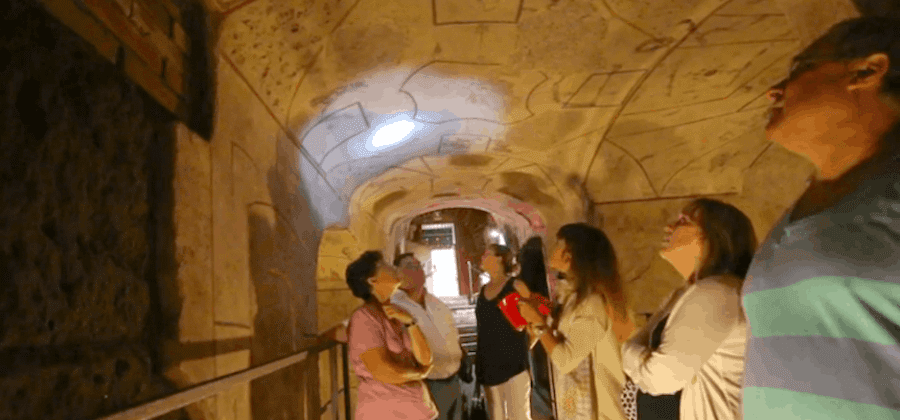
How To Visit the Rome Catacombs in 2024
Sean Finelli Last Updated: August 28, 2023
When you think of Rome, what comes to mind? Food, the Colosseum, and the Vatican? That’s pretty accurate, but our local guides know of a few other top sights you definitely don’t want to miss. If you’re up for exploring the darker side of Rome, find out how to visit the Rome Catacombs.
Pro Tip: It’s easier to organize your trip when you have all your resources in one place. Create a browser folder and bookmark this post. Also, check out our guide to Rome for more planning resources, our top Rome Catacombs tours for a memorable trip, and how to visit the Rome Catacombs at night .
Visiting the Catacombs of Rome: What We’ll Cover
- Catacombs of Rome History
- Hours, tickets, and catacomb options
- Catacombs Tour Options
- How to get to the Catacombs
- Things to see at the Catacombs
- Where to eat nearby
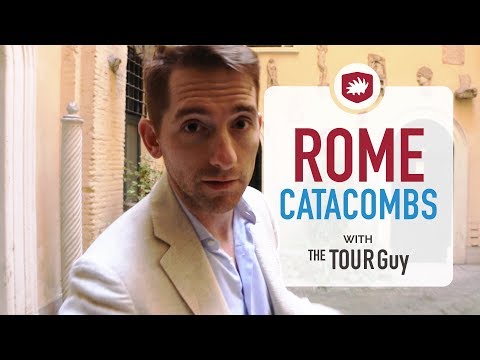
Not ready to book a tour? See if a Rome Catacombs tour is worth it .
History of the Rome Catacombs
Some say the Catacombs came to be underground because of religious persecution, forcing Christians to hide the bodies of their dead from the Romans. Nothing could be further from reality.
Many of Rome’s Catacombs were actually built on or around the Appia Antica. This was Rome’s principal road in and out of the city. So, if Christians were trying to hide there, it wasn’t a very good choice in location. Building their catacombs there would have been the equivalent of trying to hide a building on 5th Avenue in NYC today.
Romans definitely martyred Christians. However, it was less frequent than you’d think and mostly took place in the 3rd century. Rome was a liberal place where people enjoyed religious freedom—as long as they pledged allegiance to the Roman state anyway. People often had to make this pledge in the form of sacrifices to the Roman Gods—something Christians couldn’t do.
Most martyrs were victims of circumstance or sporadic bouts of religious persecution. For example, Saint Sebastian rose fast in the military and was promoted to the Praetorian Guard, which directly protected the emperor. Diocletian was emperor at the height of Christian popularity when the “cult” was considered to be a serious threat to the Roman way of life.
Emperor Diocletian discovered that Saint Sebastian was not only concealing his own faith but also converting others to Christianity, especially Praetorians, and his martyrdom followed.
Martyrs were often people who held high office in the Roman government rather than common people. They were usually identified through their refusal to participate in pagan ceremonies or through rumors spread in elite circles.
Another example is the Patron of the Domitilla Catacombs. The granddaughter of Emperor Vespasian, she was exiled. Her husband, Flavio Clemente, was put to death.
Rome Catacombs Hours, Tickets, and Options
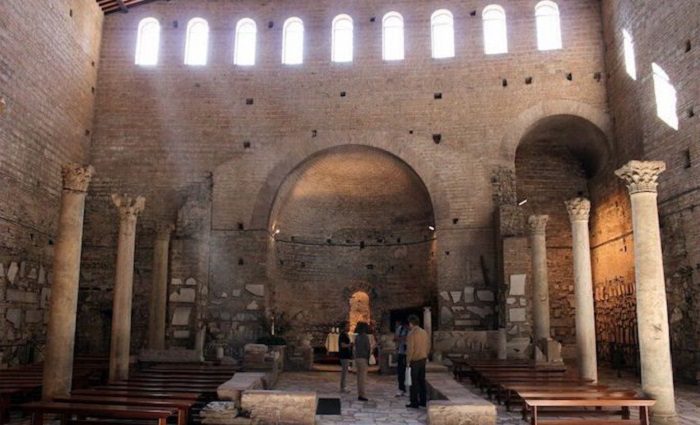
The Catacombs of Domitilla
The Domitilla Catacombs are one of Rome’s oldest and largest catacombs, holding over 150,000 people and stretching 10.5 miles (17km). It is the only Catacomb with an underground basilica—a massive structure used for worship. The basilica makes a big impression on visitors when they first walk in, which is why it’s our preferred catacomb for guided tours and the one we most recommend to travelers.
There are many paleo-Christian frescoes, which are in excellent condition today. Visiting the catacombs is an amazing way to connect with our ancestors from close to 2000 years ago.
Hours:
Open Wednesday to Monday from 9 am to 12 noon and 2 pm to 5 pm (Closed on Tuesdays)
The Catacombs normally close from Dec 15 to Jan 15th for seasonal closure. Check the official website ahead of your visit for up-to-date information.
- €10 (Adults)
- €7 (6 – 15 and students)
- Free (>5)
Address: Via delle Sette Chiese, 282
Not ready to book a tour yet? Find out if a tour of Rome’s Catacombs is really worth it .
The Catacombs of San Callisto (Callixtus)
San Callisto is not the oldest of the Rome catacombs, but it is without question the largest. Buried there are roughly half a million (500,000) Christians, including many of Rome’s most famous martyrs and 16 early Popes. The catacomb is named after its creator, Deacon St. Callixtus, who was assigned by Pope Zephyrinus, the 15th Pope.
Known for the immense amount of symbolism inside, you can find many early Christian symbols like the monogram of Christ, Alpha and Omega, and the Anchor, among many others, in the Catacombs of San Callixtus.
One of the main attractions here is the Papal Tombs. These are very impressive tombs that once held the remains of some of Rome’s earliest Popes, including the 11th Pope St Anicetus. The main reason we do not visit these catacombs is due to the crowds—it is Rome’s most popular catacomb and draws in many crowds.
Catacombs Opening Hours:
Open Thursdays to Tuesdays from 9 am to 12 noon and 2 pm to 5 pm (Closed on Wednesdays)
Closed on New Year’s Day (1st January), Easter, and Christmas Day (25th December). There are also seasonal closures, so please check the official website for up-to-date information ahead of your visit.
Catacombs Tickets Prices:
- €10 (Standard Admission)
- €7 (Concession Tickets)
Address: Via Appia Antica, 110
The Catacombs of Saint Sebastian
The Catacombs of Saint Sebastian are one of Rome’s oldest catacombs and home to the remains of St. Sebastian, one of Rome’s greatest martyrs. Executed on the orders of Diocletian, they shot Saint Sebastian with as many arrows as a “sea urchin”. Miraculously, he survived.
Once he regained his health, he surprised Diocletian with a moving speech about the persecution of Christians. Unfortunately, it fell on deaf ears and Diocletian made sure he did not survive the next run at this life. Thrown into the common sewers, fellow worshippers fished Saint Sebastian out and buried his remains in his namesake catacombs.
Open Monday to Sunday from 10 am to 5 pm
Seasonal closures: December (annually), 25th December (Christmas Day), and 1st January (New Year’s Day).
Catacombs Ticket Prices:
- €7 (7 – 16 years old and students)
- Free (>6)
Address: Via Appia Antica 136
The Catacombs of Priscilla
The Catacombs of Priscilla, known as the “queen of the catacombs” due to the number of martyrs buried within, are a vast complex of underground burial chambers in use from the 2nd to the 5th century A.D.
The name Priscilla comes from the Roman noblewoman who granted the church the use of her vast land for the purposes of burial. They blocked the entrances at some point to prevent robbery.
Unlike pagans and many others, Christians did not bury their dead with worldly possessions. Thieves did not realize this and would vandalize graves. Re-discovered in the 16th century, these are great catacombs to visit today, but we recommend going to the catacombs surrounding the Appia Antica. In our opinion, the area has a larger history and gives you more options to explore other nearby monuments.
Open Tuesday to Sunday from 9 am to 12 noon and 2 pm to 5 pm (Closed on Mondays)
Tickets (reservations required):
Address: Via Salaria 430
Rome Catacombs Tour Options
You can definitely visit the catacombs on your own, but why all the hassle? You’ll need to take a bus out there and back, and you’ll miss out on the nearby attractions like the Old Appian Way and the Capuchin Bone Crypts.
We offer a variety of different catacomb tour options that will make your visit simple, enriching, and enjoyable! Here are a few of our best Rome Catacombs tours to take:
Rome Catacombs Tour with Capuchin Crypts (3 hours)
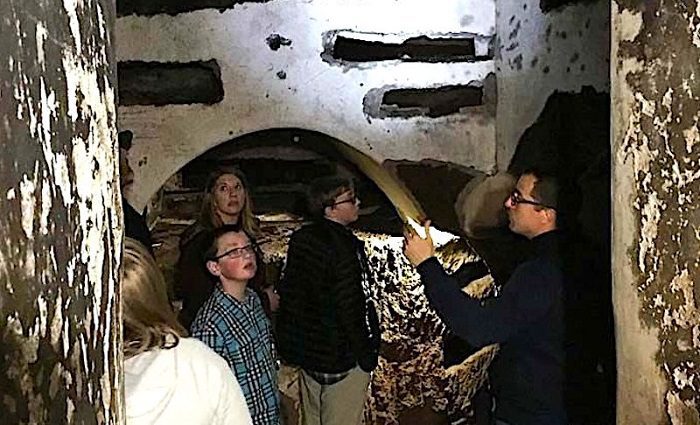
Don’t bother with the hassle of figuring out which catacombs to visit on which day and how to get there. Come with us and we’ll take care of all that, plus show you some other pretty cool sights along the way.
Your expert guide will share all the history that makes the Capuchin Crypts and Catacombs even more interesting, plus dispel some myths along the way. Don’t just see Rome—get to know its story.
See tour itinerary, price, and description
After Hours Rome Catacombs Night Tour with Capuchin Crypts (2.5 hours)
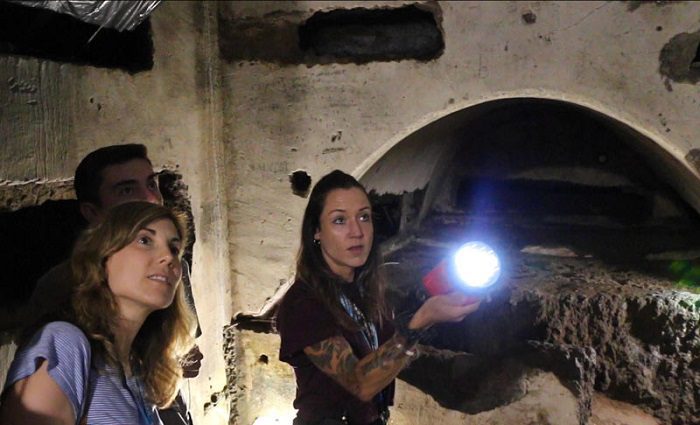
You can see the Catacombs with everyone else during the day or you can join our special-access night tour.
It’s a lot more creepy, but this VIP experience gets you into the catacombs without the crowds and your guide will even unlock the gates to lead you into the ancient depths. Cool or what!
Ancient Rome Tour with Colosseum Arena Floor and Catacombs Tours (8 hours)
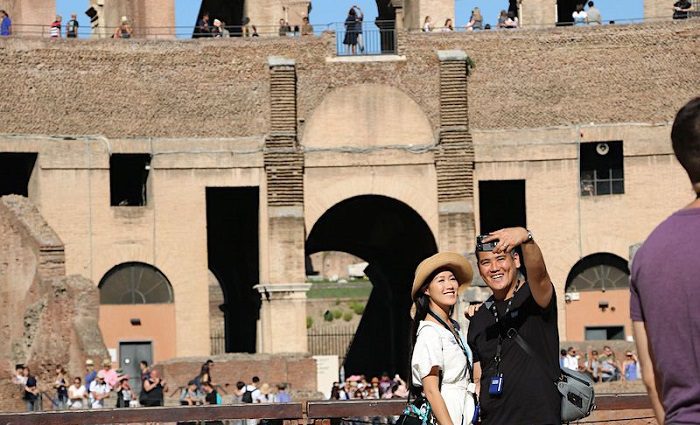
Our combo tours give you the best value by combining two top sites in Rome. On this tour, not only will we show you the Colosseum but we get you special access to the Arena Floor where you can see through the eyes of ancient gladiators.
Our tours get you skip-the-line tickets, transport, and passionate guides, but our combo tours let you see more for less.
History of Christianity Tour with Vatican, Sistine Chapel, and Catacombs (8 hours)
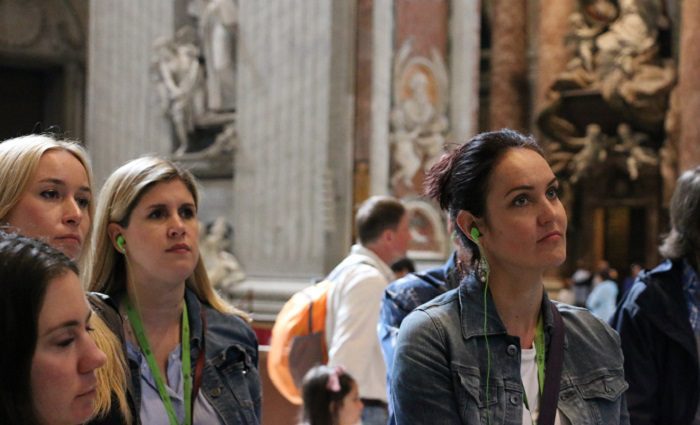
If you want to visit the Catacombs and the Vatican Museums on your trip, you’ll get more bang for your buck by combining the two on our combo tour.
With us, you’ll get coveted skip-the-line tickets for the Vatican, an expert guide to accompany you through the Museums and the Catacombs, and all the logistics taken care of. It’s the easiest and most meaningful way to see two of Rome’s major sights.
Catacombs Private Tour in Rome (3 hours)
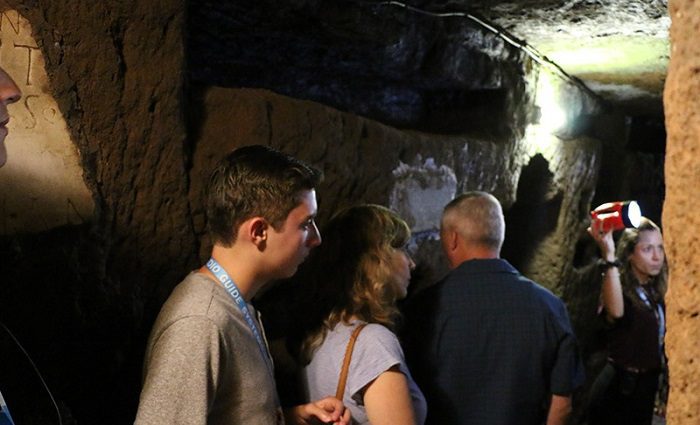
If you’re looking for a VIP experience of the Rome Catacombs, this private tour is for you! It comes with a door-to-door transport service and an expert guide who can focus on your interests.
With all logistics and tickets taken care of, your private group simply has to sit back and enjoy the scenery and the Rome Catacombs. There’s no better way to see them.
How To Get To the Rome Catacombs
There are a few ways you can get to the Domitilla Catacombs from Rome’s city center. By taxi, it will take about 15 minutes. Another option is to take the bus. From Roma Termini station, you’ll want to get the 714 bus and take it 12 stops to Navigatori, which should take about 15 or 20 minutes.
Once you’re there, you’ll walk about 10 minutes down Via delle Sette Chiese and arrive at Domitilla Catacombs. The catacombs of Saint Sebastian and San Callisto are fairly close by.
Getting around Rome by bus can be a little confusing if you don’t know the city very well or can’t speak Italian. If using public transportation worries you, we recommend going with an expert guide on a group tour. This way, you can take private transportation directly to the Domitilla Catacombs without having to worry about logistics.
11 Things To See at the Rome Catacombs
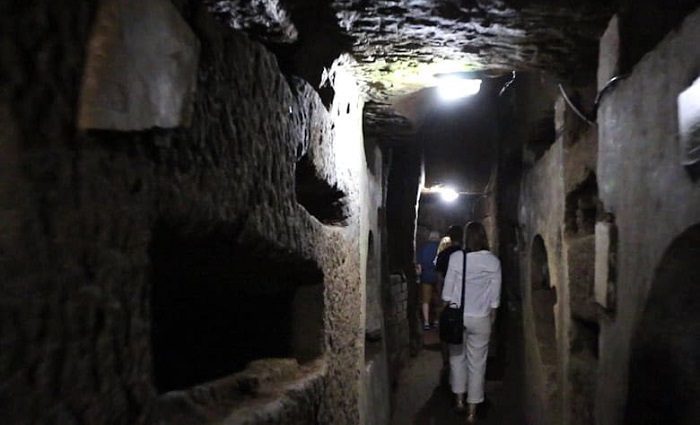
Domitilla Catacombs
Located about 15 minutes outside Rome are the hidden Catacombs of Domitilla. Early Romans created the Domitilla Catacombs because burial was not allowed inside of Rome, whereas the Paris Catacombs were created because there was no more room to bury anyone in the city.
Not a lover of death and bones? The Catacombs of Domitilla are also home to many incredible frescoes dating back as early as A.D. 360 and you will not find any skeletal remains to this day. An estimated 150,000 bodies are buried in the catacombs.
The Basilica of the Martyrs Nereus and Achilleus
One of the main draws of these catacombs is the underground basilica. It is exactly what it sounds like, a massive basilica under the ground that was used by Christians for worship.
The Basilica was constructed at the end of the 4th century A.D. when Christianity was already legalized. It was not located underground to hide but instead to be closer to the tombs.
Christian Tombs
The tombs or graves are dug out of tufa stone which is a type of volcanic stone. The oldest tombs are the ones closest to the surface since they were the first ones dug. You’ll notice the tombs are shorter than you would likely fit into—this is because Romans were short and people have gotten taller over time.
Here are the different types of tombs:
- Loculi : These are single-person tombs cut into the walls. Sometimes, multiple people were put in these, but they were originally meant for one person. Smaller ones exist for children.
- Arcosolio : This is a tomb for more than one person, often used for families.
- Cubicoli : Full rooms reserved for families where generations of people could be buried over time.
Tombs would be covered with marble slabs, many of which are missing as graves have been robbed over time.
Ancient Frescoes of Paleo-Christian Origin
There was a big advantage to the catacombs being underground—for preservation. At one point, many of them were sealed shut to protect the tombs from grave robbers, which meant there was almost no circulation of air or elements. Often graves were decorated with frescoes and many of them are the best-preserved frescoes from antiquity.
- The Last Supper
- Life of Bakers
- Grape Vines
- Jesus with Apostles
- Noah’s Ark
- Daniel with Lions
A lot of the frescoes portray the transportation of grain to Ostia, probably representing the profession of those buried there. There’s even a fresco dating back to the second century, depicting The Last Supper.
Via Appia Antica
The Appian Way or Via Appia Antica is one of the original seven roads leading into Rome. The road connected Rome to Brindisi, which is a seaside village in the southeast of Italy and a port that connected the city with the middle east.
The original road was built in 312 B.C. by Appius Claudius Caecus who named it after himself. The road was completed and used during the Samnite Wars. It was an impressive road that extended more than 350 miles or (560km).
The road was built in layers, starting with leveled dirt, followed by interlocking stones, mortar, gravel, and finally larger interlocking stones. The road was level, straight and flat. It also had mile markers throughout the entire route, which gave travelers an excellent idea of where they were on their journey.
Ancient Roman catacombs line the Appian Way and it is a great site to explore off the beaten path. When they were still in use, the catacombs lining the Way were common burial sites for both Christians and Pagans.
Capuchin Crypt in Rome
If bones are what you’re after, head to the Capuchin Crypts in the historic center of Rome. Dating back to 1645, the Capuchin Crypt is not technically a catacomb. However, it fits hand-in-hand with the spooky atmosphere of the Roman catacombs.
Why head here? Well, this place is the final resting place of around 4,000 monks, buried between 1500 to 1870. Adorned with the bones of these ancient monks, these rooms are more than a bit eerie.
For the most haunting Capuchin Crypts experience, we recommend visiting the area at night on our VIP Rome Catacombs Night Tour with Capuchin Crypts .
The underground crypt is divided into five chapels: Crypt of the Resurrection, Crypt of the Skulls, Crypt of the Pelvises, Crypt of the Leg Bones and Thigh Bones, and the Crypt of the Three Skeletons.
While underground burial sites in Rome typically require a hike to the outskirts of the city, the Capuchin Crypt is easy to add to a day of sightseeing alongside the Pantheon, Colosseum, Vatican, and Spanish Steps.
Park of the Aqueducts
The Parco degli Aquedotti or Park of the Aqueducts is part of the Appian Way Park and Rome’s largest green space. It is a very peaceful place that can be a bit hard to get to, but it’s definitely worth it.
It’s exactly what you think it is—a park with Ancient Roman aqueducts running through it. You can see the Aqua Felix and Aqua Claudia in plain view. The Claudian Aqueduct, or Aqua Claudia as it is referred to, rises as much as 100 feet in the air and stretches 43 miles.
It is one of four great Roman aqueducts and apparently was capable of bringing 50 million gallons of water into Rome every 24 hours! You really can’t miss the structure as it is free to visit!
Not ready to book a tour? Find out if a Rome Catacombs tour is worth it .
Where To Eat Nearby
Hostaria Antica Roma : €€€ | Experiential Ancient Roman Food —If you are looking for authentic ancient Roman eats, this is your spot. Yep, dine off a menu of food that the Romans themselves indulged in themselves about two thousand years ago. It’s pretty pricey, but a cool experience for all.
Giardino di Giulia e Fratelli: €€ | Typical Roman | Outdoor Seating | Great for Kids —I have ridden bikes out to this little garden restaurant on many of my days off. It’s a pretty cool little place with good food and a great garden. An excellent place if you have kids and you want to enjoy a long lunch. They can safely run around in the enclosure while you eat and have some wine!
If you want us to arrange the entertainment in Rome (and beyond!), contact our Trip Planning Team to coordinate an unforgettable Italian experience.
Where To Stay in Rome
Rome has a rich cultural history and many iconic landmarks to explore. Plan where to stay in the magnificent Eternal City in the best neighborhoods.
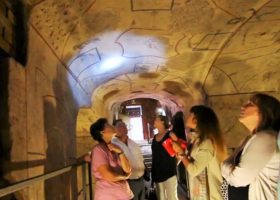
Reader Interactions
Leave a comment cancel reply.
Your email address will not be published. Required fields are marked *
- In The Press
POLICY & TERMS
- Cancellation Policy
- Terms & Conditions
- Privacy Policy

The 5 Best European Cities To Visit: Where To Go and When
E urope is a hotspot for tourism due to its impressive diversity and access. There are a multitude of cultures, cuisines and landmarks in Europe. The continent is also relatively easy to get around, since public transportation there is efficient. Some travelers may even opt to travel around Europe all at once since there are jaw dropping views within close proximity. The continent is a traveler’s paradise since the infrastructure is well designed for commuting . There are so many popular destinations within Europe, so it may be difficult for travelers to determine where exactly they should go. These are the best European cities to visit and the ideal season for travel in each.
London
London, the capital city of England and the United Kingdom, is one of the most popular travel destinations in Europe. Travelers visiting London can experience the top attractions in the bustling urban metropolis. It is a cultural capital with a plethora of historical sites that travelers can witness. This metropolitan city has plenty for travelers to explore. Some of the most popular things to do and see are the Big Ben clock tower, Westminster Abbey, The British Museum, Buckingham Palace, and the Tower of London. Foodies can indulge in some English delicacies like fish and chips, traditional English breakfast and bangers and mash. There are many other cuisines that travelers can try in London, including Indian, Italian, Chinese, Thai, French and many other cultural foods.
Best Times To Visit
The best time to visit London, England depends on the traveler. For the best sightseeing weather, travelers should make their way there between March and May. The temperature in this season is around 60 degrees, so travelers should dress themselves in layers. The high season for travel in London is in the summer and winter. If travelers want to avoid crowds, they should not visit London between June to August or December to January.
Paris
Paris, France is a major tourism destination that has plenty of globally recognizable monuments and cultural hallmarks. Even the cityscape of Paris is quite popular due to its iconic landmarks. French culture is all around very influential, but beyond that Paris is a remarkable city with plenty to see. The architectural wonders of Paris are a big appeal of the city. In fact, over 30 million travelers enjoy the picturesque city of light each year. The Eiffel Tower, Louvre Museum, Versailles Palace, Paris Catacombs, Luxembourg Gardens and the Champs-Elysees are among the best attractions in the city. Tourists can enjoy the cheeses, soups, macarons and fresh breads of Paris while visiting Paris.
The best times to visit Paris are either in the spring or autumn. During these times travelers can expect better temperatures. This weather allows them to comfortably sit outside and enjoy things like Parisian cafe tables. The weather is nice and moderate in the city between April to May and September to October. Travelers will even notice that there are less crowds in the tourist areas.
Rome is the capital city of Italy and it has certainly made its mark on the globe. It is among one of the most popular tourist destinations in the world. Some of the art, architecture and cuisine of Rome dates back 3,000 years. The city offers travelers a deep dive into ancient history and culture. There are plenty of famous sightseeing attractions in Rome that travelers should visit during their Europe trip. Some of the most popular ancient buildings for tourists to view in Rome include The Colosseum, Arch of Constantine, The Pantheon and St. Peter’s Basilica. There are a large number of famous remnants of the Roman Empire that have historical significance in this city. Some other things that tourists can do in Rome include guided walking tours, countryside trips, shopping, indulging in delicious Italian food and strolls around the city.
Travelers visiting Italy should expect bigger crowds in areas like Rome. Although crowds are somewhat consistent, travelers can plan their trip so that it is as convenient as possible. Between October and April travelers will experience the least amount of crowds. The costs of accomodations are lower during this time too, but travelers may have to tolerate the chilly weather in exchange for price. Travelers should be sure to pack a jacket since weather can be around 50 and 70 degrees in Rome during this season.
Barcelona
Barcelona, Spain is an artistic looking and charming city with plenty for visitors to experience. The city overlooks the Mediterranean Sea and is a modern hub as well as one of Spain’s most popular cities. It has a wide range of leisure activities and is a walkable city, so plenty of travelers love Barcelona. The unique architecture, beaches, culinary options and art of Barcelona keep travelers coming back. Travelers can enjoy the food of Barcelona while in the bustling city. Paella, croquettes, potato bombas and escalivada are just a few of the most popular dishes of Barcelona. Tourists commonly enjoy the Picasso Museum, the Cathedral of Barcelona, Casa Milá, Park Güell, Las Ramblas and Barceloneta Beach while in the city. Some of the most popular attractions of Barcelona are the buildings and shopping areas. Alternative activities for travelers include hot air balloon tours, walking tours, food and wine tours, private sailing tours and immersive museum experiences.
Best Times To Visit
The best time to travel to Barcelona is between April and July. During this time travelers will experience the best weather. Temperatures are around the mid 70’s during this season which means that the outdoor conditions are manageable. This is particularly important for travelers depending on public transportation. If sightseeing is a priority travelers should visit in early spring or autumn since there are less crowds. During the spring there is some rainfall, especially during April. Since a lot of the attractions in Barcelona are outdoors, this will definitely impact a trip.
Amsterdam
Amsterdam is the capital of the Netherlands and it is a quite popular city. It has a vibrant culture, rich history and stunning landscapes. The picturesque canals, historic homes, creative spirit, liberal appeal and shopping opportunities are the top features of the city. Tourists looking to immerse themselves in this European city can try the local cuisine. Pannenkoeken, haring, oliebollen, kaas and stamppot are some of the top Dutch comfort foods. These traditional food items are popular among locals but travelers should try them while they are exploring abroad. Stamppot, a dish made from potatoes and vegetables, is the national dish. Other than cuisine, travelers can visit the top attractions of the area to learn more about Amsterdam. The Anne Frank House, Van Gogh Museum, Heineken brewery tour, red light district, Body Worlds Museum and local parks are the top things to see.
The best months to visit Amsterdam are spring and autumn. Between April and May or September and November is the most ideal time to visit. There are less crowds and more mild weather during these seasons. Although the weather is not particularly dependable, these months provide pleasant temperatures of around 60 degrees. If travelers prefer to travel during the most affordable time to go to Amsterdam, the winter may be best. Temperatures generally are around 30 or 40 degrees during the winter, but hotel rates are low.


IMAGES
VIDEO
COMMENTS
Whether you're a history buff or a traveler with a taste for the macabre, get ready to explore the secrets contained within the best catacombs in Rome. 1. Catacombs of Saint Callixtus. Image: Management / Tripadvisor. Located along the historic Appian Way, the catacombs of Saint Callixtus are the largest and most well-known of the Roman ...
1.9K. All you need to know about Rome catacombs: what they are, where they are, the best catacombs in Rome to visit and how to book a tour. The catacombs are one of the most fascinating underground attractions in Rome.. Rome's catacombs are early Christian cemeteries, dating from the early days of Christianity in the Roman Empire.. They develop as an extensive network of underground tunnels ...
Catacombs of San Callisto. Situated on the Old Appian Way, the Catacombs of San Callisto span five levels and a total 20 kilometers in length. Named after the (soon-to-be pope) St. Callixtus, these are among the most significant Christian catacombs in Rome, and acted as the official cemetery of the Church of Rome in the 3rd century AD.. It is believed that roughly half a million Christians ...
The catacombs of Rome are a network of underground burial chambers located around the city of Rome. There are probably 50-60 catacombs underground Rome, but only a handful have been excavated and only 6 are open regularly. The catacombs began being used as burial sites for centuries, starting in the 2nd century CE.
Unveiling the Journey to Rome's Ancient Underground: A Visitor's Guide. Embarking on a voyage to the past, the catacombs of Rome await beneath the storied cobblestones of the Appian Way. This guide is meticulously crafted to ensure a seamless pilgrimage to these venerable relics of early Christianity.
Quick Answer: The 5 Best-Rated Catacombs Tours In Rome. Rome: Crypts & Catacombs Tour with Bone Chapel Visit. Rome: Catacombs and Crypts Small Group Minibus Tour. Catacomb of St. Callixtus and Appian Way: Guided Tour. Catacombs & St John in Lateran Combo Tour.
Covering more than 12 miles (20 kilometers), the Catacombs of St. Callixtus along the Appian Way (Via Appia Antica) are the largest in Rome. The complex once housed the remains of martyrs, popes, and an estimated half a million Christians. You'll only tour a fraction of its tunnels and burial chambers—which date from the beginning in the ...
6x Best Catacombs in Rome Rome Underground Crypts: Tickets & Tours Rome Catacombs. Outside the old city center are dozens of underground cemeteries and Roman crypts, or the Catacombs of Rome. You can visit six catacombs, like the Catacombs of Saint Callixtus, Saint Sebastian, Domotilla and the Catacombe di Priscilla.
All Articles Best catacombs to visit in Rome. Best catacombs to visit in Rome. Image: georgesyrios / Pixabay. By Amelia Ang 5 Jul 2022 ...
Top Tip: To view these burial tunnels, book this 3-hour guided tour of the best catacombs in Rome. Practical Tips for Planning Your Visit to Rome's Catacombs Visiting the Catacombs Independently. If you're planning to visit any of the catacombs in Rome independently, there are a few things to remember.
1. Catacomb of San Callisto. It is the catacomb par excellence, since it was the official cemetery of the Church of Rome in the 3rd century, and given its extent one can also speak of it in the plural ("the catacombs" of St. Callistus). The Catacomb of St. Callistus is in fact one of the most important and largest catacombs in Rome.
Other 3 GREAT Tours of the Catacombs in Rome. ️ This Guided Rome Catacombs Tour of St. Callixtus and Appian Way is a 3-hour excursion that takes you to the catacombs located beneath the city's ancient aqueducts. Travel by bus to the site, and then trace the footsteps of the early Romans as you walk along the rustic Appian Way.
San Callisto's catacombs are among the Best Catacombs in Rome, please take some hours to visit them! How to Reach the Catacombs of San Callisto. San Callisto's Catacombs are located in Via Appia Antica, 110/126. Here are a few ways you can reach one of the Best Catacombs in Rome by public transport from Termini Station:
Catacombs of San Callisto. Along the Appian Way (Via Appia Antica, 110/126) 9am-12pm, 2-5pm / Closed on Wednesday. Entry fee 7-10 €. Possibly Rome's most famous catacomb, this site extends almost 20 km and was the burial place of more than 10 martyrs and 16 popes. As the official catacombs of the Roman Church, the crypt of the popes was ...
Here are our best Rome Catacomb tours: Rome Catacombs Tour With Capuchin Crypts. After Hours Rome Catacombs Night Tour with Capuchin Crypts. Ancient Rome Tour with Colosseum Arena Floor and Catacombs Tours. History of Christianity Tour with Vatican, Sistine Chapel, and Catacombs. Catacombs Private Tour in Rome. 1.
The catacombs are open every day except Wednesdays from 9:00 - 12:00 in the mornings and 14:00 - 17:00 in the afternoons. The ticket office closes at 16:50. Wheelchairs are not permitted within the catacombs, and those with severe mobility issues may encounter walking difficulties.
The Catacombs of San Sebastiano are the first catacombs of Rome. This is where the word "catacomb" originated from, and then used to refer to all the underground cemeteries. The Catacomb of San Sebastiano are located on the Appian Way, in the east suburb of Rome. It features 12 kilometers (7.5 miles) of galleries and more than 100000 burials.
He got lost for three days down here in search of the lost origins of Christianity, and it's easy to see why even today, even with the aid of electric light illuminating the spooky way down towards the center of the earth. Catacombs of Domitilla, Via delle Sette Chiese, 282. Opening Hours: from 9.00 to 12.00 and from 14.00 to 17.00.
Rome Underground Tours: The Best Catacomb Tours in Rome Catacombs of St. Callixtus. Among the largest and most important catacombs in Rome, the Catacombs of St. Callixtus served as the official cemetery of the Church of Rome. St. Callixtus used to be a deacon, and in the 3rd century CE, he was entrusted with the administration of the cemetery.
5. Small Group Rome Catacombs Tour with Aqueduct. 🌟 Rating: 4 1/2 Stars ⏳ 3 1/2 Hours Aqueduct, San Sebastian 🔎 Check Rates. This small group tour is longer than the standard half-day Rome catacombs tours as it includes time to visit the Roman Aqueducts at the end of the tour.
By Rick Steves. The ancient paving blocks of the Appian Way can be seen in a park just outside of central Rome. (photo: Rick Steves) The Appian Way — Rome's gateway to the East — was Europe's first super highway and the wonder of its day. Built in 312 BC, it connected Rome with Capua (near Naples ), running in a straight line for much of ...
There are a few ways you can get to the Domitilla Catacombs from Rome's city center. By taxi, it will take about 15 minutes. Another option is to take the bus. From Roma Termini station, you'll want to get the 714 bus and take it 12 stops to Navigatori, which should take about 15 or 20 minutes.
Covering more than 12 miles (20 kilometers), the Catacombs of St. Callixtus along the Appian Way (Via Appia Antica) are the largest in Rome. The complex once housed the remains of martyrs, popes, and an estimated half a million Christians. You'll only tour a fraction of its tunnels and burial chambers—which date from the beginning in the ...
The Catacombs of Callixtus is perhaps the best known of the Catacombs of Rome. It is located along the Appian Way and is home to the Crypt of the Popes (dating from the 2nd to 4th centuries).
The best months to visit Amsterdam are spring and autumn. Between April and May or September and November is the most ideal time to visit. There are less crowds and more mild weather during these ...